Beyond Wild Places
Your guide to the wilder side of life

A Guide to Hiking the Markha Valley Trek
Known as one of the most popular and beautiful treks in Ladakh, I decided to hike the Markha Valley trek during my time in North India. The trail follows the Markha River through a beautiful valley south of Leh town.
The trail has become relatively popular in India for a number of reasons. It’s easily accessible, it’s not difficult to navigate and it’s one of the few multi-day treks in the region that can be done independently by staying in homestays.
The Markha Valley trek is quite spectacular and gives you a closer view of the incredible landscapes that are found around Ladakh. The colours of the rock change every kilometre on the trail and the villages appear almost like oases along the valley floor. It was also a beautiful way to get a glimpse of the traditional Ladakhi culture and lifestyle of the region.
This guide will help any independent traveller organise and hike the Markha Valley trek in Ladakh.
Disclaimer: This post contains affiliate links which means I get a commission if you buy a product through my link at no extra cost to you. By doing so, I can keep this blog going and continue to create helpful guides for you. Read more: Privacy Policy
About the Markha Valley Trek
- Distance: 68km
- Time: 4-5 days
- Difficulty: Medium-Hard
- Highest point: Kongmaru Pass at 5250m
- Accommodation: Homestays and camping available
The Markha Valley trek follows the Markha Valley River from Chilling up to Kongmaru Pass and down to Shang Sumdo, near Hemis National Park. It passes through a beautiful arid valley that provides stark contrasts between the dry dusty slopes, snow capped peaks and green fertile villages along the river.
Throughout the valley there are small local villages living a very traditional lifestyle. The region has a long history which is evident along the way as you pass old gompas and ruins of fortresses on hilltops.
While the locals live off the land as best they can, the arrival of trekkers has brought a whole new source of income and access to supplies by mules and porters. Many of the mud-brick homes have been turned into homestays for trekkers, with each village managing the homestay program themselves. Generally speaking, each night a different house has their turn to accommodate any trekkers passing through.
This also means that the price is very consistent and each village sets a price for accommodation and food per trekker. It’s a nice change in India to know that there’s no bargaining or cheating, and you know how much you have to pay.
Read next: 25 Best Things to Do in Ladakh

BUY THIS: Ottie Merino Hiking T-Shirt, Made and Owned in Australia
When to Hike the Markha Valley Trek
It’s best to tackle the Markha trek during the high season in Ladakh, between June and September . This is when the weather is at its best with clear skies, dry weather and relatively warm days. Outside of these months, you’ll likely find too much snow and some of the roads impassable.
Do You Need a Guide?
Similar to the Sham Valley Trek in Ladakh, you don’t need a guide to hike the Markha Valley trek. The trail is perfectly fine for independent hikers to follow and it’s quite common for budget travellers to complete this trek without a guide. I ended up doing most of the Markha Valley trek solo, as my two hiking buddies turned around after the first day.
However, a guide can make the experience more enjoyable if you’re not a confident hiker or you want to learn more about the local culture and history.
You can organise a guide in Leh at one of the many hiking and travel agencies in town. Prices start from around 4000 INR per day for an organised trek with a guide. Make sure you’re clear about what’s included and not included in the price, as some companies don’t include meals etc.
Any agency in Leh can also help arrange transport and porters, if you want. However, as my Markha Valley trek itinerary described below proves, you can really just head off from Leh and organise everything yourself.

Getting to the Trailhead: Chilling
With constant road construction the trailhead has moved over time. Chilling , a village on the Markha River has been traditionally considered the start of the trek. However, the dirt road now extends just past the village to a newly built bridge across the river.
When I completed the hike, I was dropped at this bridge instead of Chilling village, as it saves a couple of kilometres along a dusty, dirt road. The drive from Leh to Chilling took two hours.
The taxis in Leh have a booklet with all the official prices inside and so generally, if you’re a tourist there is not much room to bargain. The whole taxi costs around 3600 rupees (AUD$70) from Leh to the bridge/trailhead, so you can split it amongst other travellers if you find people to share it with.
Alternative Start Point
There is another option which is to start at Zingchen , which is just a short drive south of Leh. From Zingchen, you can follow the trail to Rumbak and then up to Ganda La pass at 4900m and then down to Skiu where it meets up with the Markhka Valley trek. This option adds around 2-3 days onto your hike and should only be done by those who’ve spent at least a couple of days acclimatising in Leh.
A taxi from Leh to Zingchen costs about 1900INR (AUD$38).
Read next: Best Places to Stay in Leh, Ladakh

Day 1: Chilling to Skiu
As we didn’t leave until midday from Leh, we decided to only hike to Skiu village (or also written, Skyu) on the first day. From the bridge where we were dropped, we followed the dirt road, which is actually now motorable until Markha although it’s not used with vehicles very much. It took us 2 hours of relatively easy walking to arrive in the village and it was already 5.30pm when we arrived.
A lady came running over from the field and said, “We have rotation system of homestay here, and it’s my turn tonight, come.” We were taken to her home where there were already two trekkers staying and we got a basic room to share with mattresses on the floor.
Distance: 7km Time: 2 hours Ascended: 180m

Day 2: Skyu to Markha village
Unfortunately, my two friends decided to turn back as one of them had been sick overnight. Skyu is one of the last points that you can call a taxi to reach you so it was the safest decision. I then decided to keep going alone and left at 11am for the long hike to Markha village.
It was a long undulating trail through the valley floor following the river. There were chortens and stupas along the way at small passes in the trail and the colour of the mountains was insanely beautiful.
With no shelter or cover from the sun, it did get quite hot. I was sweating a lot and I ran out of water often, but I could refill at teahouses and villages along the way. I passed a few large trekking groups with donkeys, porters and guides, so I was far from alone.
I arrived in Markha at 5pm, extremely tired and dehydrated. All I wanted to do was stop and rest but I pushed on to the village to find a homestay. It took me some time but someone finally tracked down the lady who was on the roster for the night.
There was another couple also looking for a homestay and they got the only bedroom in the house, so I slept on the floor in the kitchen/dining room with the lady. We enjoyed dinner together and then I slept like a baby until 5.30am, when I heard our host get up to make breakfast.
Distance: 21km Time: 6 hours Ascended: 420m

Day 3: Markha to Lower Hankar
I left the homestay at 8am and quickly overtook all the mule trains and trekking groups. The trail eventually wound it’s way through the valley until it came to the edge of the Markha River. There was no other choice but to wade through the freezing water which reached up to my knees.
I passed through the tiny village of Umlang where I had a ginger tea and a rest from walking at one of the teahouses.
I finally arrived in a place called Lower Hankar, which is just 1km before the main village of Hankar. A lady stopped me and said it was their turn to host trekkers. I contemplated pushing on further but wasn’t feeling the best as the elevation was getting closer to 4000m. So, I stayed the night in the large home with a few other trekkers as they rolled on through in the afternoon.
The homestay had a tent set up outside where you could enjoy the view and chat with other trekkers for the rest of the day until dinner.
Distance: 10km Time: 3 hours Ascended: 210m

Day 4: Hankar to Nimaling Camp
I woke up knowing I had a big day ahead of me, but I felt very positive and, sometimes that can make all the difference. I left at 8am and followed the undulating trail up to a campsite where a lot of the organised trekking groups had stayed the night before. From there, the trail was steep and so began the 800m ascent up to Nimaling.
The weather was not very good and clouds obscured the beautiful view as rain threatened to come all morning. I took a steady pace and surprised myself as to how little I had to stop to catch my breath.
The trail climbed up to the top of a ridge where I passed many of the trekking groups. Just as the rain started to fall, I finally made the last push up before the trail plateaued out for the last 2km to camp.
I was feeling pretty good, despite the day before and I made it to Nimaling in 4 hours, a time that not even the camp managers could quite believe.

The camp was at 4800m (the second highest I’d ever slept at), and the ‘homestay’ available is actually a cluster of tents that some locals manage and rent out for the season. At that altitude there are no permanent villages and only nomadic farmers who bring their stock up to fertile grounds for the summer.
I got myself my own tent and then sat in the dining room for the rest of the evening talking to people as they arrived. The rain was relentless and turned to hail and snow as the entire landscape became a blanket of white.
There was no heater in the dining tent and it was absolutely freezing once the sun set. I was okay in my down jacket that had served me well in Nepal, but many people shivered through the night. The camp was practically full, with all sorts of trekking groups and individuals. Many had guides, with just a few of us independent hikers.
Distance: 12km Time: 4 hours Ascended: 860m

Day 5: Nimaling to Kongmaru La to Shang Sumdo
I woke up and anxiously peered outside the tent to see what the weather had decided to do. Luckily I could see blue skies with some cloud around, a lot better than the day before. I headed off for the pass after 8am and, like the day before, I felt very strong and was moving up the steep climb at a decent pace.
For the short 3km to Kongmaru La, it’s estimated to take around 2 hours. I made it in just over an hour, with me and a Frenchman the first two to cross the pass for the day. The view was cloudy, but still magnificent with mountains stretched out in every direction.
At 5250m, I couldn’t believe how well my body was coping. Although, staying in Leh at 3500m for a couple of weeks before had definitely helped!
Distance: 3km Time: 1 hour 15mins Ascended: 430m

I started down from the pass as soon as the snow started to fall and it was a very steep decline all the way back down to the bottom of the valley. I was going at a very quick pace, but had to make myself stop for a lunch break after such a big morning. There aren’t any teahouses along the way so it’s important to carry enough food.
As you head down through the valley, the trail can be difficult to follow. At times there seems to be numerous trails, some of which are old and have been destroyed in landslides or washed away by the raging river below.
At the time, it seemed obvious to me to simply follow the donkey poo which basically leaves a perfectly marked trail all the way back as many locals use the trail. This served me well and I never got lost. It pays to use some common sense sometimes when you don’t have a guide.
The trail does go up and down along a sheer valley and crosses the river a couple of times too. You have to be vigilant in this last part of the Markha Valley trek, as you don’t have any other way out.
Distance: 14km Time: 4 hours Descended: 1580m

Finishing the Markha Valley Trek and Getting Back to Leh
I made it to a small village called Chogdo which is the beginning of the motorable road that goes back to Leh. There were a few taxis waiting at a tea house there, but they were all pre-booked for the trekking groups. There was one who wasn’t booked and he was willing to drive me back but I wanted to wait for more people to fill the car.
I waited for two hours and then gave up, and decided to continue walking the extra 5km down to Shang Sumdo, the village at the official end of the trek and closer to the sealed main road.
I arrived and there was one tea house where a lovely old couple were sitting. The lady instantly poured me a cup of chai and I asked whether it was possible to get back to Leh.
There is a bus that leaves every Monday, but it was Saturday and I didn’t feel like waiting another whole day in the village so she called a taxi. The official rate is 2750INR (AUD$50) but we settled on 2000 rupees (AUD$40) for the return drive. It took around 90 minutes to drive back to Leh.

Accommodation on the Markha Valley Trek
The homestays were generally good, although it’s far from luxury. It’s often a mattress on the floor in a shared room with other trekkers and maybe even your host, so don’t expect too much.
You can also carry a tent and camp along the way, but the homestay experience is very much a memorable part of the trek.
The price for the accommodation was the same 1500 INR (AUD$28) each night including food. Except the Nimaling Camp sometimes charges more, about 1700 INR (AUD$32), but you have no other choice up there of any other teahouse.
There were no showers available and toilets are usually just holes in the ground. So, bring your own toilet paper!

The food was very good, or at least the dinners were. Home cooked food with locally grown produce, usually rice, dahl and vegetables although they also cooked local food like stew and tingmo too.
Breakfast was only tea and some chapatti and so I never ate breakfast but had plenty of snacks with me. The homestays organise packed lunches for hikers, which were always the same; a sandwich, a boiled egg, a boiled potato or two, a juice box and a chocolate bar.
On some of the days, you’ll pass through some villages or purposely set up tents selling tea, Maggi noodles, biscuits, and other snacks. But don’t rely on this.
In regards to water , the locals drink from the river but they do offer trekkers that stay the night some filtered water. I would carry a LifeStraw or similar filter bottle so you can ensure the safety of the water you’re drinking.

Trail Navigation
The Markha Valley trek is mostly quite obvious and it would be difficult to get lost all the way through to the Kongmaru pass. There were plenty of people on the trail too, so there’s never a shortage of anyone to ask.
After the pass, however, there were a few random trails darting here and there on the way down to Chogdo, and even some trails that I could see must have been old and recently destroyed. So, its best to follow the one that has very obvious footprints and animal droppings as this will be the one that the locals use and they know best.
The trails are also marked on Maps.Me but I would actually say to follow the footprints/poo as it’s likely to be more accurate. Trails can de destroyed year to year from landslides and water.

What to Pack on Markha Valley Trek
The homestays provide almost everything you need, which means you really only need to take a small daypack with essentials. Here’s what I recommend packing:
- 30L or 45L Daypack
- Drink bottle to be refilled along the way
- Trekking poles (highly recommended for the trail up to Kongmaru La and down to Chogdo on the last day)
- Hat, sunglasses and sunscreen (the sun is incredibly strong at altitude in Ladakh)
- Trekking or walking shoes
- Headlamp for Nimaling Camp (or use your phone)
- x2 t-shirts for walking
- x1 pants, shorts or leggings for walking
- x1 long sleeve top and pants for sleeping
- x1 fleece jacket
- x1 rain jacket or poncho
- x1 down jacket (it gets very cold at Nimaling Camp)
- Underwear and x2 socks
- Toiletries (toothbrush, toothpaste, deodorant, toilet paper etc.)
- Basic first aid (BandAids or plasters, tape, Ibuprofen, electrolytes, altitude sickness pills)
- Power bank for your phone and other electronics
- Snacks from Leh
Markha Valley Trek Cost
Transport to and from: 3050 rupees (AUD$61)
Homestays & food: 6000 rupees (AUD$120)
Snacks purchased before leaving Leh: 1000 rupees (AUD$20)
There are no permits required although as I was leaving the valley I was made to pay a park fee , which was 20 rupees (AUD40c) per day.
Total: AUD$203 for five days
More Essential North India Guides
- Comprehensive Travel Guide to Ladakh
- Detailed 10 Day Leh, Ladakh Itinerary
- Complete Guide to the Sham Valley Trek in Ladakh
- Ultimate 1 Month North India Itinerary
- Best Places to Stay in Leh, Ladakh for All Budgets
25 Best Things to Do in Ladakh
- How to Get to Leh, Ladakh
Pin this post

Share this:

How to Explore Zanskar Valley in North India

A Travel Guide to Exploring Mizoram and Tripura

Comprehensive Travel Guide to Ladakh in North India
17 comments.
many thanks for this helpful blog post, which was very valuable for planning my Markha valley trek as an independent trekker.
I just came back from the trek and would like to share my experiences, which might be helpful for trekkers finding this page:
– As of June 2022, there are no homestays in Skiu anymore. There is a homestay in Kaya (village shortly before Skiu) and then only again at Sara (about 2-3 hours from Skiu). However, I would recommend reaching Sara on the first day anyway (see next point).
– Most of the trekkers I met followed a similar itinerary to the one proposed in this blog post (e.g., Chilling – Sara – Markha – Hankar – Nimaling – Chogdo), amounting to 5 days of trekking. However, they all told me quite frankly that they felt like wasting time, as the daily stages in the first few days are quite short and lead to killing a lot of time in the villages. To avoid this, I recommend to do the trek in 4 days, i.e., using Chilling – Sara – Hankar – Nimaling – Chogdo as stops. I personally did the trek in 3 days (Chilling – Markha – Nimaling – Shang Sumdo), but I would not recommend that unless you are very fit (i.e., do a lot of endurance training).
– In my case, there were neither a teahouse nor available taxis (not even on call) at Shang Sumdo. I asked a local to drive me the 8 kilometers to Karu (the next village at the ‘highway’) for 700 rupies. At Karu, a friendly lady then ordered a taxi for me, which took me to Leh for 1200 rupies. Alternatively, you might get a seat in the pre-booked taxis picking up the groups at Chogdo, but that may involve a lot of waiting.
– The homestay rates are still the same (1200 rupies for all homestays, 1700 at Nimaling).
Best regards, Simon
Thank you Simon! I’m sure this will help lots of people planning this trek now. Thanks for sharing your updates with us.
Thanks a lot for your post and update on the situation on the Markha trek. I plan to do it mid of September. How long was the trek from chilling to Sara? Can you also comment on what type of equipment you recommend to bring? Regarding drinking water did you use tablets to purify the river water? Also from Elisha’s post I expect it’s not necessary to have a guide as there are more than enough other trekkers and it’s hard to miss the trail. Can you confirm that, also with regards to the river crossings?
Thanks a lot for your help in advance.
Hi Simon and all, any idea if there are homestays again in Skyu? That would have been the perfect stop for a first night for me, distance wise!
i don’t believe there is a homestay in Skyu. there is a campsite within an hour though, and a homestay in Sara within 90 minutes…
Thank you, Simon! I was thinking of doing the trek in 4 days the same way you described above (Chilling-Hankar-Nimling-Shang Sumdo). I think 4 weeks is totally doable with some chill time with the locals. You validated my plan. So excited. Fingers crossed.
Hogwash- I just finished the trek and in Skiu there are 2 homestays near the monastery, there are a few about 700m from the monastery in the direction of Chilling, and there are a few about 700m down the road in the direction of Markha. Also, prices have gone up. All homestays are now 1500 Rp, and 2000 Rp at Nimaling. Also, the packed lunches are sufficient enough to not need to bring extra food with you (to save on weight).
Excellent post. Mobile network is active on Kongmaru La,. as on 1st August ’22.
Hi, Thanks for your post Elisha & update Simon. I plan on doing this trek late August & wondered what’s provided in the homestays? Do I need to take a sleeping bag for example or are all basics provided? I’m travelling around India from Aug 14 for 2 months and want to lug as little as possible. Thanks
Hi Richard, I didn’t take a sleeping bag, and the homestays provided blankets for the night. I’m sure you could rent a sleeping bag in Leh maybe if you wanted to, but most travellers I met just used the blankets provided. That was in 2019 though!
hiked this in August 2022. Your post is right on. but leaves something out, IMO.
on the last day, from Kongmaru La, the descent down to Chongdo features some narrow paths with long falls if you should slip. i did just fine, but i was VERY GLAD. that the trail was dry, and also VERY GLAD that my partner wasn’t with me, as she would have freaked out. its nothing compared to many of the trails in Europe, but us Americans aren’t used to such exposed, ‘you fall, you break both legs or maybe die in the freezing river’ kind of terrain.
again, i don’t think this should stop the most confident 90% of hikers, but if i were you, i’d wait for a a clear day with dry weather for that last day if i were you.
Thank you for your comment! I agree, the last day was challenging, some trekkers got a little lost following goat tracks, you do need to be very careful and vigilant to find your way down the valley if you don’t have a guide.
Thanks for your comment. How did you navigate through the trek? Was it easy to find the right trial down on the last day?
Elisha, I want to congratulate you on this and many of your other posts. They really are excellent. I’ve travelled a lot, independently wherever possible, including the Himalayas, Nepal and India, and what you’ve written is so to the point of the stuff that people need to know. What’s more, I’ve enjoyed reading it! cheers, Jim
Thank you so much!
[…] many hikers head off on the 5-day Markha Valley Trek in Ladakh, if you’re short on time or not keen to head up to over 5000m in elevation, then […]
[…] A Guide to Hiking the Markha Valley Trek […]
Leave a Reply Cancel reply
Discover more from beyond wild places.
Subscribe now to keep reading and get access to the full archive.
Type your email…
Continue reading

- Best Hikes In The World
- Appalachian Trail
- European Hikes
- Nepal Hikes
- Patagonia Hikes
- See All Hikes
- Mount Kenya
- Mount Kilimanjaro
- Mount Toubkal
- See All Mountains
- South Africa
- New Zealand
- Switzerland
- United Kingdom
- Packing Lists
Markha Valley Trek – Ladakh’s Most Popular Trek
Asia , India
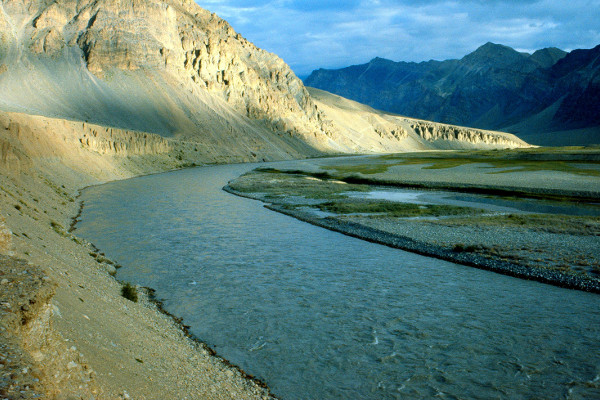
The Markha Valley Trek is one of the most spectacular and famous treks in the Ladakh region of India.
Located in the northwestern area of India, the Ladakh region is famed for its wildness and untouched beauty.
On this page, you will find a comprehensive and impartial guide to the Markha Valley Trek.
Markha Valley Trek
The Markha Valley Trek follows a stunning high valley with superb views across the mountain region and is one of the best ways to still experience the unique culture of the High Himalaya region . The Markha Valley trek follows the Markha River downstream taking in several high passes including Ganda La (15748 ft) and Kongmaru La, (17,060 ft). From both passes you get epic views across the landscape with the tall peaks of Kang Yissay and the 20,086 ft Stok Kangri coming into sight.
Not only is the trek one of mountain beauty, but it also takes trekkers through a landscape of ancient farming with many green irrigated fields and local villages being passed along the way. You’ll also experience several monasteries and meet the brightly dressed monks as they go about their daily lives. You’ll will be exposed to several waist-deep river crossings, high rocky canyons and explore many buddhists villages en-route.
Please Note: The trek is moderately difficult due to the length and high altitude of both passes. There will be several steep trek ascents and you may have to walk over slippery scree on occasion. You will need to have a good level of stamina and fitness to have a really good time. Accommodation will generally be camping.
Regional Map
The Markha Valley Trek is located between the Zanskar and Ladakh in the Himalaya region of North-west India.
Please see the map below for details.
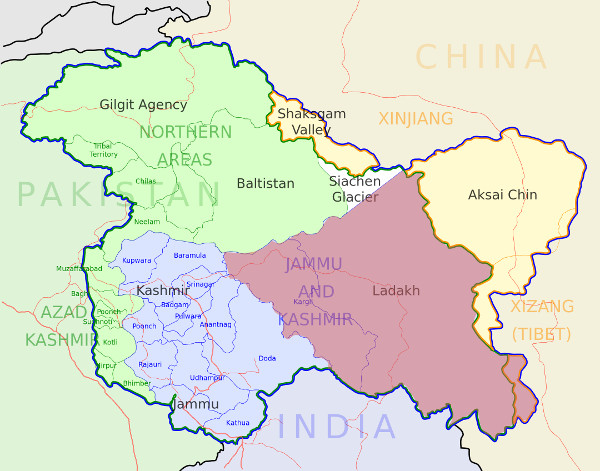
Markha Valley Hike Itinerary
Below is a detailed Markha Valley Trek itinerary. Please note that this is a typical itinerary that we would expect many operators to adhere to. However, some tour operators offer variations on this route.
For example, it is not uncommon to start from Spituk and follow the route that leads to Hemis.
Day 1-3: Arrive Delhi - Transfer to Leh
From Delhi International Airport, you will need to take a domestic flight to the city of Leh. It is worth spending a day in Delhi if you have the time, as well in Leh, where you can visit Leh Market, Leh Palace and Shanti Stupa.
If you have more time, it is worth getting a taxi to visit the Shey Palace, Likir, Basgo and Alchi Monastery, Sangam and Thickset. If you’re lucky, you’ll witness the Grand Hemis Festival at Hemis monastery.
Day 4: Leh to Chogdo via Martselang (4½ hours)
You will need to get a jeep from Leh to the starting point at Martselang (3600 m). As you drive, you may be given the opportunity to visit the Palace of Ladakh . The trek begins as one enters the Hemis National Park, where, if you’re lucky, you may glimpse endangered wildlife such as the elusive snow leopard, Tibetan wolf and the great Golden eagle. You will trek for several hours to the small village of Chogdo (4000 m).
Day 5: Chogdo 4000m – Nimaling 4700 m via Kongmaru La 5260 m (6-7 hrs)
Today begins with a steep ascent that leads to your first mountain pass – Kongmaru La (5260 m). The climb is worth it though as you get outstanding views of the north face of Kangyatse (6400 m), Zanskar and the epic Karakoram range . After taking in the view you then descend down towards the greener pastures of Nimaling. It is here that you will meet villagers who spend the summer months tending their herds. You camp the night here.
Day 6: Nimaling – Hankar – Markha 3650m (5-6 Hours)
From here, you begin the descent to the village of Hankar. You begin by walking through lovely green pastures whilst also taking in the Himalayan wildlife such as the Marmot, Mountain Vole and Weasels. You then cross a cool mountain lake. This is the perfect place to take lunch and enjoy the stunning scenery. As you continue down you reach the irrigated farmlands of Thochungtse. At the campsite there is a lovely spring that is well known throughout the region for its medicinal properties!
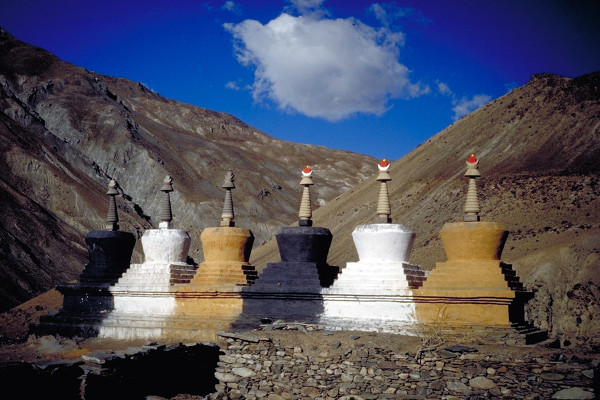
Day 7: Markha to Skiu
Today, you head for Skiu via Markha! Along the way you will make several river crossings. Once at Markha you will have time to explore the village before pushing on to Skiu. Once out of Markha you will descend through the small provinces of Nakdi , Sarah and Hamburjah and Pentre. Each province is only inhabited by 2 to 3 families roughly. After trekking through lush flatlands, you reach your campsite at Skiu where you bed down for the night.
Day 8: Skiu to Shingo 4125m (4-5 hrs)
Today, you follow the Zankar river upstream to the small village of Skiu. Here you will turn away from the main river and follow the stunning gorge up into Shingo. You camp overnight here.
Day 9: Treks to Rumbak 3800m (6-7hrs)
From Shingo, you climb gradually as you ascend over the Ganda La pass at 4850 meters. From there you pass Yurutse and continue down to your camp near Rumbak.
Day 10: Rumbak to Stok 4200m via Stok la 4900m (5-6 hrs)
Today is a big day. You begin your steady ascent up to the base of Stok la (4900 m). From there your trail becomes steeper as you climb ever higher to cross the pass. However, you’ll be rewarded along the climb with stunning views of the Indus valley and the incredibly colourful rock formations of Stok la. After crossing and taking in the amazing vistas you then begin your decent. You take the trail along the mountainside until you reach the village of Stok. From here you will need to arrange transport back to Leh .
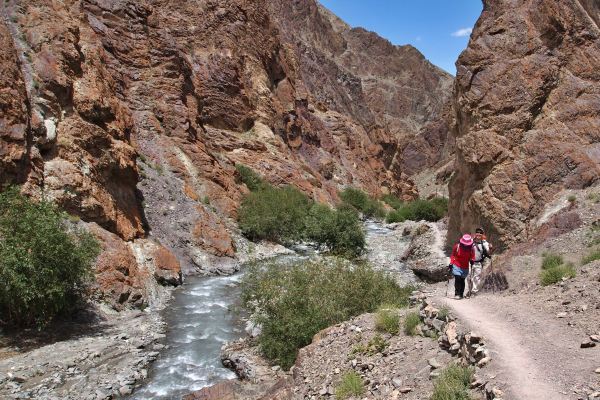
Photo by Kevin
Markha Valley Trek FAQ
How much does the markha valley trek cost.
The cost of an Markha Valley Trek varies depending on how you choose to operate your trek. If you decide to the trek the route without a guide, then your costs will be considerably cheaper. Here's a rough estimate: Tour Agency: ~$600 – 1,000 for a cheap local agency to ~$1,500 – $2,000 for a Western trekking agency. You could do an independent trek for $25 per day potentially once on the trekking route.
However, hiking independently does pose problems. Firstly, there are a number of routes and finding your way can sometimes be tricky. Your guide will also know the best places to eat, sleep and take rests whilst also introducing you to many local people along the way.
Other costs include:
- Visa, Vaccinations, Insurance etc: ~$300-$500
- Equipment (buying and hiring): ~$500-$800
- Flights to Leh: ~$1,000
- Tips: ~$100-$200
- Misc (additional food, unplanned travel / hotels ect): $200
How many miles is the Markha Valley Trek?
The Markha Valley trek takes around 6-7 days to complete, starting in Leh. Depending on the exact start and end point, the Markha Valley hike is approximately 50 miles (80 kilometres) in distance. Total elevation gain / loss is about 2500m / m, with a max elevation of 5260m.
Are permits required for the Markha Valley Trek?
No, permits aren't required for the Markha Valley trek.
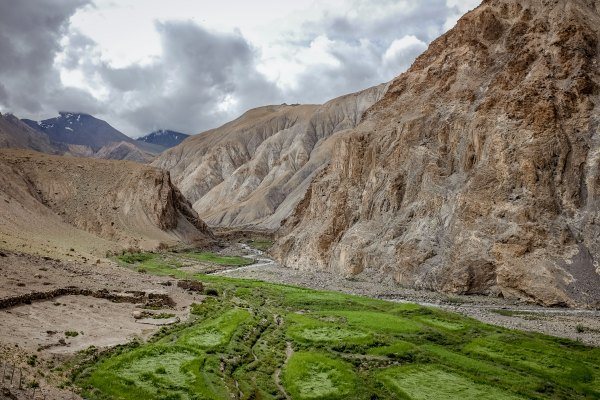
When is the best time to complete the Markha Valley Trek?
The best time to hike the Markha Valley trek is from June to October with the high season being in June and July. The monsoon season barely affects the region and you should experience little rain when trekking in this period. That being said, downpours do happen, and you must wear appropriate gear. During winter the trek experiences heavy snowfall and makes the area very isolated.
Is altitude sickness a risk on the Markha Valley hike?
Yes, the Markha Valley Trek is very much a high-altitude trek. At its highest point – Kongmaru La – you’ll be standing at 17,060 ft.
Whilst there are several high passes, the itinerary offered by all operators gives trekkers time to acclimatise to the altitude. Nonetheless, it is important to have a detailed understanding of the risks associated with high altitude trekking and how the body acclimatises.
We recommend you read our detailed article on Altitude Sickness and Acclimatisation .
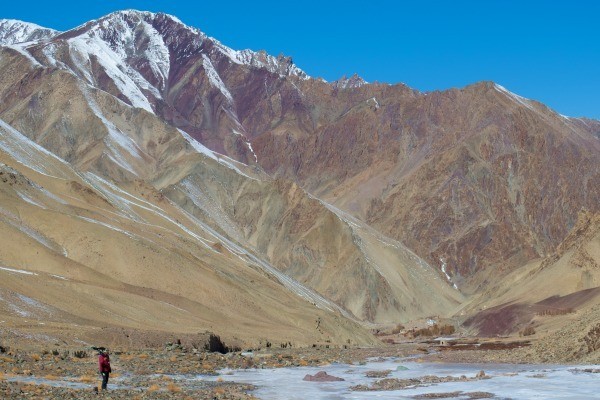
How difficult is the Markha Valley trail?
The Markha Valley Trek is fairly challenging. You will be trekking for 4-7 hours a day for over a week, so you will need to be in good physical condition. There are several high-altitude passes to cross and several steep climbs with the potential for slippery scree. The best way to prepare for this is to get as many miles under foot on hikes in your home country.
What gear do I need to hike the Markha trek in India?
Trekking in the Ladakh region requires a number of essentials like the following clothing and equipment:
- base layers
- hiking pants
- down jacket
- rain jacket
- hiking poles
- hydration bladder
The Markha Valley trek is both a fun and challenging trek that exposes you to a range of altitudes and fluctuating temperatures, especially between night and day.
Many pieces of equipment can be rented or bought in Leh, but we recommend bringing the most important pieces of gear with you. To help you plan and prepare for your trek, we have written a detailed packing list for multi-day treks .
Are there any recommended guidebooks for the Markha Valley hike?
There are a number of excellent guides we recommend for the Markha Valley Trek:
- Trekking in Ladakh by Radek Kucharski.
- Trekking in Indian Himalaya by Lonely Planet
- Trekking Guide to the Western Himalayas by Depi Chaudhry
- Ladakh: The Essential Guide by Partha S. Banerjee
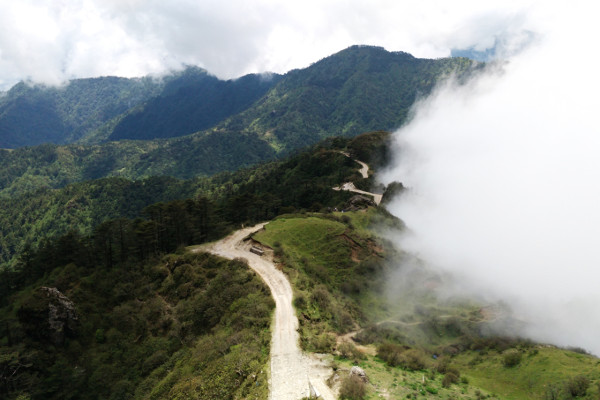
Are there other routes besides the Marhka Valley?
Absolutely. We also recommend doing the Chadar Trek , Singalila Ridge Trek and Ladakh Treks for unparallelled sightseeing and experiencing Indian culture and history first hand.
Continue browsing
See more information on India . Or check out these other Indian Hiking articles:
- Himachal Pradesh Hikes
- Uttarakhand Treks
- Trekking through the Roopkund
- Hiking the Arunachal Pradesh
- Best hikes in India
About the author
Mark Whitman
Mark has trekked extensively in Asia, Europe, South America and Africa. He founded Mountain IQ in 2014 with the sole aim to be the best online information portal to some of the most popular mountain destinations around the world. When not writing for Mountain IQ, Mark is out exploring the outdoors with his wife!
Leave a Reply
Your email address will not be published. Required fields are marked
Hey! Great info! I used your site to prepare the Anapurna trek and now heading to trek the Markha valley. I had som question about it: It seems you did it in reverse compared to other descriptions I have seen, what is the reason? I will do it in June, do you recommend taking a mattress or are the homestays on the way ok? Sleeping bag? Cheers Kevin
Hi Kevin, You can do the route either way, both routes involve going over high passes relatively early in the trek so make sure you are well acclimatised. Homestays have beds with mattresses, but you will want to take a 4-season sleeping bag as well. All the best!
UPDATE JUNE 2023 The small stream in the valley from Nimaling to Chogdo is overflowing with melting water at the moment. As there are 20+ river crossings it is extremely dangerous to descend that way. If you can avoid this part and have time to return the way you came up, do so! After a really nice and easy trek up to Nimaling, we attempted to climb down from Nimaling to Chogdo on the 25th of June via the Konmaru La East Pass. The first bit after the pass, was steep and a little sketchy but well manageable with some experience and sturdy footwear. Unfortunately after that we were facing massive amounts of water flowing down the valley to Chogdo. After crossing the river twice (slipping and falling, almost losing our backpacks and hiking poles) we decided to wait until the next morning as water levels were expected to go down during the night. Which means we got stuck halfway on the mountain at 4500 meters and ended up staying the night emergency bivouacing (sharing 3 sleeping bags and one emergency bivouac bag between the 7 of us). We were lucky to be a group of (semi-)experienced trekkers who could make it down safely the next morning starting at around 4.30 am. Moreover, travel agencies and locals in the camp in Nimaling do not seem to care or do not know any better, so do not expect warning from their side. Also there is no reception on the descend and even satellite phones do not work as they’re blocked in Ladakh. Stay alert and safe!
Thanks for the local insight Anna. Very helpful!
Thanks for the detailed information! I really appreciate it. Can I ask you a question? I'm planning to do this trek in August and am planning to bring my 64-year old mother along. She's very fit and healthier than most 50-year olds, but in combination with the pretty sharp increase in altitude, I'm not sure if the Markha Valley Trek is the best choice. May is ask you about your opinion about this? And if your advise is negative, is there another trek in Ladakh that you'd recommend?
Thanks a lot!
With kind regards,
Hi Merijn, I think you’re mum would be fine on the Markha Valley hike, but if you’re concerned there is an easier route that some operators offer inn te Nubra Valley. Hope that helps!
We work with local guides to offer great value adventures at unbeatable prices
.webp)
Markha Valley Trek
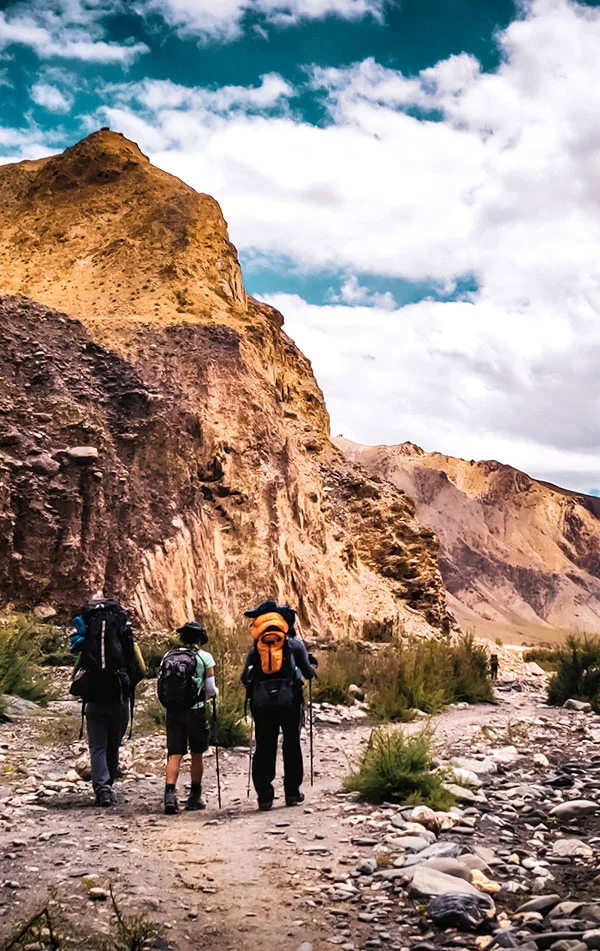
Ladakh | India
Max Altitude
Trekking Km
Moderate to Difficult
Get in Touch with Our Trek Expert
22500 /person $ /person.
- September-2024
- +5% GST (goods and services tax)
- Services Leh to Leh | Included Transport.
Offload 4200
Backpack offload is optional
Choose add-ons during booking. If missed, log in and add them later.
Book off-load at least 10 days before the trek.
For offline bookings at the base camp, a convenience fee of Rs. 4500 applies.
Cancellations made before the trip date will receive a full refund.
For more information. Please complete this form.
Trek Name: Markha Valley Trek
Adventure Type: Trekking
Base Camp: Leh
Season: Summer | Monsoon | Autumn |
Month: April | May | June | July | August | September | October | November |
Country: India
Altitude: 17100 Ft.
Grade: Moderate to Difficult
Rail Head: Manali is the nearest rail head to the base camp
Stay: Camping (Twin sharing) & Hotel/Guesthouse (Separate for male & Female)
Food: Meals while on trek (Veg + Egg)
Location: Ladakh
Distance: 46 Km.
Trail Type: Cross over trail | Start in one valley, traverse the pass, and ends in another valley.
AirPort: Leh (Kushok Bakula Rimpochee)
Located in the northern part of India, the union territory of Ladakh lies in the westernmost part of the Himalayas in the close vicinity of the Karakoram Ranges. The capital of Ladakh, Leh, the most desired adventure hub, is popular for its raw and arid thrill and a gateway to burned-out trails. With the Markha Valley trek , one gets to rediscover the parched region of the mighty Himalayas. The mysterious ride of 8 days, exhibiting lush green to yellow barren landscapes, passing alongside the Indus River will be borne in your mind for a lifetime.
Markha Valley is the largest valley in the region. Of course, Leh is the starting point of this trek, which is an added advantage to exploring the Buddhist monuments in Leh. You will be astonished to traverse through the tiny hamlets as you gain altitude. Surprisingly, these villages host cafes or tea houses serving to rejuvenate hot drinks when you are tired from the strenuous hike. One after another, Rumbak, Yurutse, Skiu, Markha, Hankar, and Nimaling settlements will revitalize you. Not only that, most of the villages have preserved monasteries, ruined forts, and temples. Amongst them, the Tacha monastery is an eye and heart catcher that lies between the mountains.
Though the trek goes through dry regions, the Indus, Markha, and numerous streams will come your way. Since the trail goes through Hemis National Park, all its treasured fauna, mountain sheep, arghali, rabbits, and snow leopards,
can be spotted at every camping site. Ganda La and Kongmaru La are the two cardinal passes to be crossed en route. These passes are known for the panoramic views of the infinite Karakoram and Ladakh ranges. The stunning sights of K2 mountain, Stok Kangri , and Kang Yatse peaks are fulfilling and the motivation of this trek. On clear days one can get to see the distant Tibet region. Just a small trek ahead of Markha Valley and you will reach the base of Kang Yatse Peaks .
This is not one of those typical treks that retrace the same path while descending. Therefore, you get a wider and non-repetitive insight into Ladakhi Himalayas. Each day reveals mesmerizing views concealed behind the mountains.
- Who can Participate
- Important Links
- How to Reach
- Trek Essential
Who Can Participate
- Age; 15 years.
- Experience of any high altitude trek, at least 1 treks of 4,000m/13,100ft.
- The climber must be fit and have sufficient stamina to cover 6 km of distance in 35 minutes without stress.
- The climber should be able to carry a 12-16 kg backpack.
Arrival in Leh
- Altitude: 3,500 m/11,500 ft.
- Check-in Hotel.
- Briefing about the trek at 5 pm (mandatory).
- Bring a copy of your ID proof and 2 photographs foreigner, a copy of your passport and visa.
- The network is available (only post-paid).
- ATM is available.
- Can purchase or rent trekking equipment from Leh.
- A visit to any very high altitude place or pass is not advisable.
- Consumption of alcohol and smoking is strictly prohibited.
- Stay in a hotel.
Markha Valley trek begins from Leh. Arrive in Leh by flight or train. Take it slowly once you arrive in Leh. Since it is at the hazardous height of 11,500 ft direct landing at this height may trigger AMS. Make sure you rest well and do not strain your body during your stay in the hotel. Leh has gained popularity as the adventure capital of India. It is quite famous amongst wanderers, which you can see as you roam here and there.
Cafes are loaded here which are hanging out places for adventurers. There is a good network connection in Leh and there are ATMs. Leh is a good option to fill up your things to carry list if you have forgotten any item. Although cafes are in close vicinity, try to stay away from alcohol and avoid smoking. Apart from that, Leh is also known for monasteries, palaces, and temples. Make sure to visit them as you enjoy your small treat in Leh. You can also explore the local market in Leh and try the local cuisine. Staying outdoors will help you acclimatize to the altitude. Reserve the evening for rest. Sleep well and let your body acclimatize to the altitude.
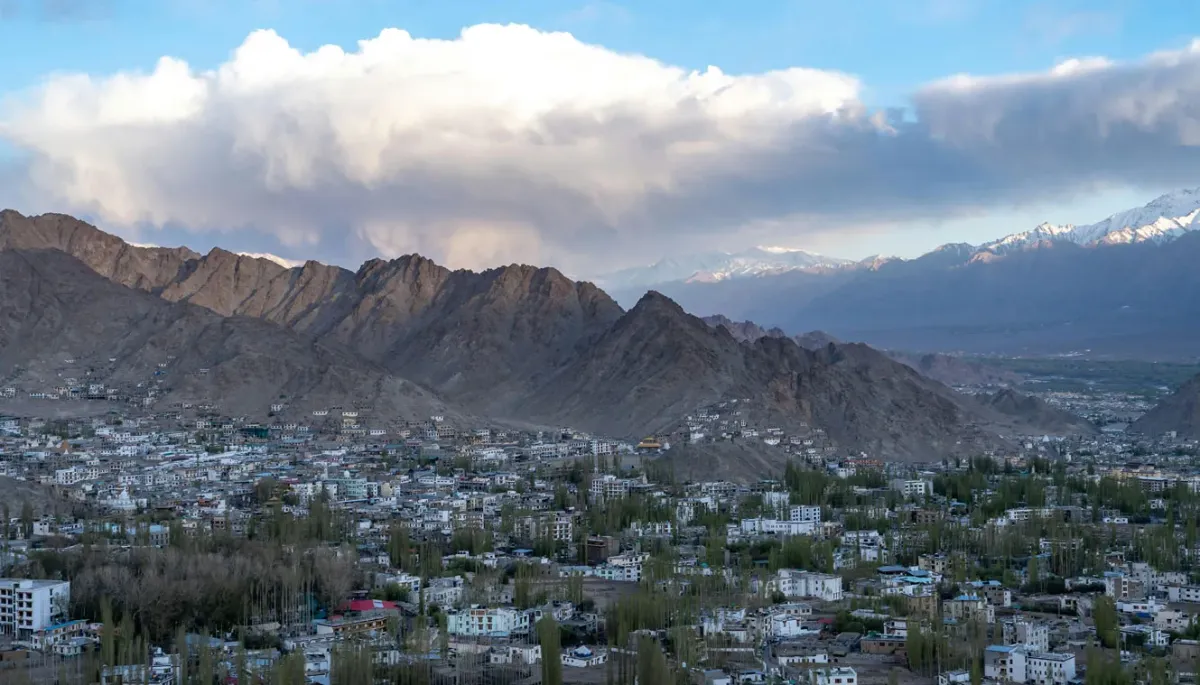
Acclimatization in Leh
- Acclimatization and sightseeing in Leh.
- Can visit monasteries: Shey, Thiksey, Sangam, and Hemis.
- Avoid river rafting, you can plan it after your trek.
- A visit to any high-altitude place or pass is not recommended.
- Stay in hotel.
Note: Downhill cycling tour around Leh without straining body.
This is an extra day added to the itinerary to help you get acclimatized better. Therefore utilize this day and try to stay outdoors. Acclimatization days in our treks are used to give your body time to adjust to the thinning air at high-altitude conditions. Several changes occur in your body while trekking in high-altitude regions and the purpose of acclimatization is to allow your body to operate optimally in a decreased oxygen level environment.
Leh is a major hub for adventure as well as a culturally rich center. It presents innumerable opportunities for sightseeing starting from the monasteries and temples, the local market as well as many places serving delicious local cuisine. Today, you can hike up to the Shey Palace, Thiksey Monastery, and Thiksey Gompa to experience the Buddhist culture. Thiksey Gompa is the largest in central Ladakh, located on a hill. Avoid gaining height by hiking to nearby passes or valleys. This is only to avoid stressing your body, as it may hinder the process of acclimatization.
Additionally, you can interact with the locals and fellow travellers to gain some knowledge about the adjacent areas. Roam in the Leh city and the Leh Bazaar. You can collect souvenirs from a variety of shops. You must spend the sunset at the Shanti Stupa, which is known for its dazzling lights in the evening. Say goodbye to the wonderful Leh and rest in your hotel. Your actual trekking day begins tomorrow.
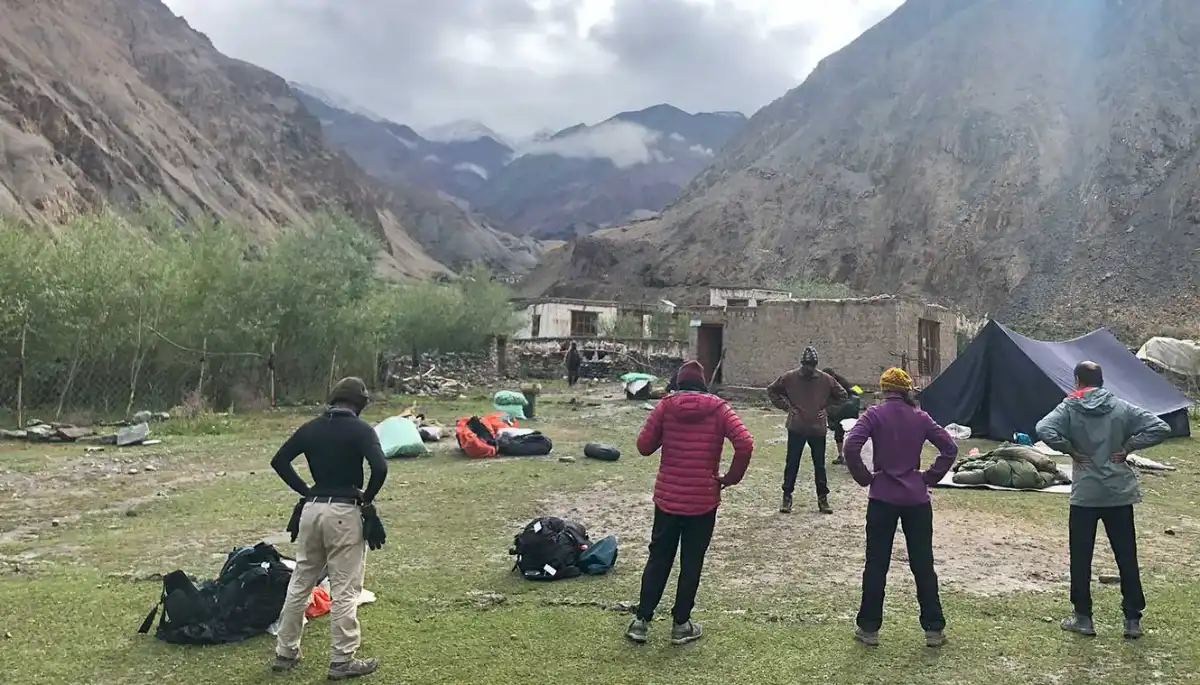
Drive From Leh To Skiu
- Altitude: Skiu - 3,400 m/ 11,150 ft.
- Drive Distance: 80 km | 4 hrs .
- Drive through Gurudwara Patthar Sahib, Magnetic Hill, and the confluence of Indus and Zanskar.
- Accommodation in homestay/ camping.
Get set as your real trek journey commences. You will be riding along the skillfully paved roadways crossing marvelous landscapes. Throughout the road, you will encounter military camps decorated with big rocks around the camps. Do not miss Gurudwara Pathar Sahib on the right and Magnet Hill on the left as you move ahead. The Stok Range remains on the right until it vanishes slowly when you reach Hemis National Park. You will be pleasantly surprised once you reach Sangam. Indus and Zanskar rivers, both bottle green, yet so unique, form the most spectacular confluence. This point is also famous as the starting end for rafting. Take a diversion here towards Chilling. The surrounding view henceforth changes magically. The open terrain beside the road enters into the closed valley. The valley has stunning purple, black, and grey shades of the mountains. Juniper and tall alpine trees will border the route as you cross the Zanskar River over green iron bridges.
Skiu will mark the first camping in the tents. It is located at the confluence of rivers Shgri Nala and Markha. Skiu village is largely divided into two sections, upper and lower village. Lower Skiu has 12 houses quite close to each other. A small trudge, old monastery, and ruins of a palace separate it from upper Skiu. There are small white stupas and mani stones laid towards the upper Skiu. Markha River lies on the right of the village.
Most of the places here offer homestays. Relax after a mini-trek, while looking forward to the upcoming trek.
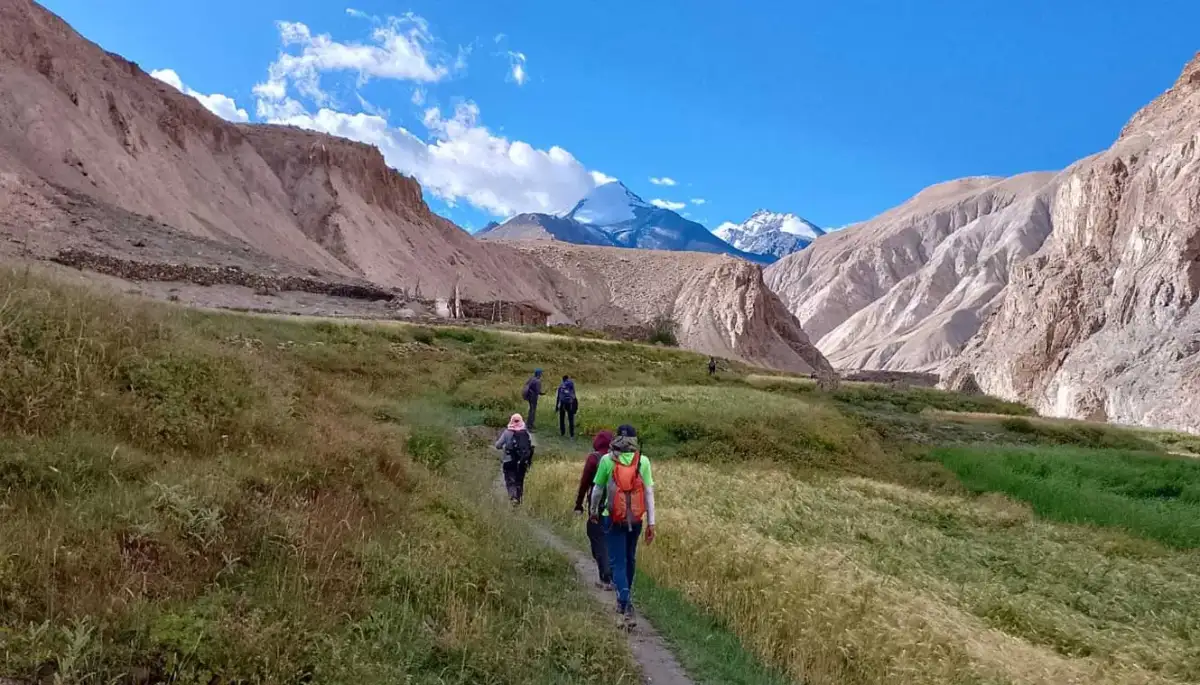
Skiu To Markha
- Altitude: 3,700 m/ 12,200 ft.
- Trek Distance: 16 km | 7 - 8 hrs.
- Altitude Gain: 500 m/ 1050 ft.
- Longest day but normal and plain slope.
- Markha is one of the largest villages in the valley.
- Cafes on the way.
- 2-3 river crossing.
- Monastery and palace visit at Markha.
Start fresh for the actual first trekking day. Be vigilant about birds and animals. Markha Valley harbors enormous wildlife. Magpie birds will be visible right after you step out of the house. The trail is quite evident and well-paved intermittently. The Markha River will remain escorting on the right, which incepts from Kang Yatse peaks. In an hour a cafe can be spotted, take a small break here and keep walking. The trail is enclosed by the valley that goes through sparse forest cover. After another hour’s trudge and the first wooden bridge comes to Zanpa Yoakma.
In about 25 minutes another coffee shop at Hamourja is waiting for you to rejuvenate. You will cross the Markha River a couple of times during the trek as you pass through various winter settlements containing Lhatos (religious shrines built for the local deities) as well as Mani walls (walls made of stone inscribed with prayers). Look out for black sheep, deer, and mountain goats on these banks. Keep walking straight to Nagding village for another 40 minutes. Right in front of the houses spot meditation caves at a height on the valley walls. These caves are believed to be having paintings from the 20th century. The banks of the Markha River get wider and you can find yourself stepping in the powdered sand. Enjoy the feeling of Himalayan sands.
After about 1 hour from Nagding village, a big entrance of Sara village appears. The entrance is decorated with skeletons of wild animals. Unlike Skui, Sara seems like an open area. Sara Village is also home to a monastery and ruins of an old castle which is believed to be the resting spot of the Royal families on their way to Srinagar in ancient times. You may also see wheat plantations and Bushoi (a cotton-like flowering plant and also a natural painkiller). Also, a unique thing that you will notice is that the entrance to Sara village is decorated with skulls of animals like Yak or Sheep. These animal skulls are perceived as a sign of pride for the locals.
From here, the first tea houses arrive immediately after 30 minutes at Chalak village. The Chalak Village comes after crossing a wooden bridge. The village has houses placed on small hills with stone protection shelters for domestic animals at the base. Visit any of the villagers and they will greet you with Namkin Chai and biscuits. Re-energize with affectionate talks and hot drinks. You will see Barley fields in the village. From Chalak, it is a gradual ascent up towards Markha and you will pass by the section of the trail marked by Bharal horns. The destination is 2 hours away from here.
At every small distance, you can find Mani stones laid around white stupas. These stones are engraved with Buddhist prayers, some of them in the Sanskrit language too. Be humble in front of these historic symbols. Do not dare to touch these stones. The villagers believe these stones are protected by some powers, and any harm to them will cause harm to that person. Do not forget to notice the ruins of the palace at every turn in the valley. This can be figured out by flags at a height on small temples. These palaces were considered viewpoints and signalling points during the reign of the Kings. Markha Village is considered the largest village, you can find numerous houses, scattered away. You will have to walk in the running stream of the Markha River to reach the Markha village. The water in the Markha River can be thigh-high at some points, so it is better to take off your shoes and socks and pull up your pants to cross the river. The cold water will bring back all the energy. In 20 minutes, you can see the hamlet. Markha is the biggest village in the entire valley and comprises 25 houses.
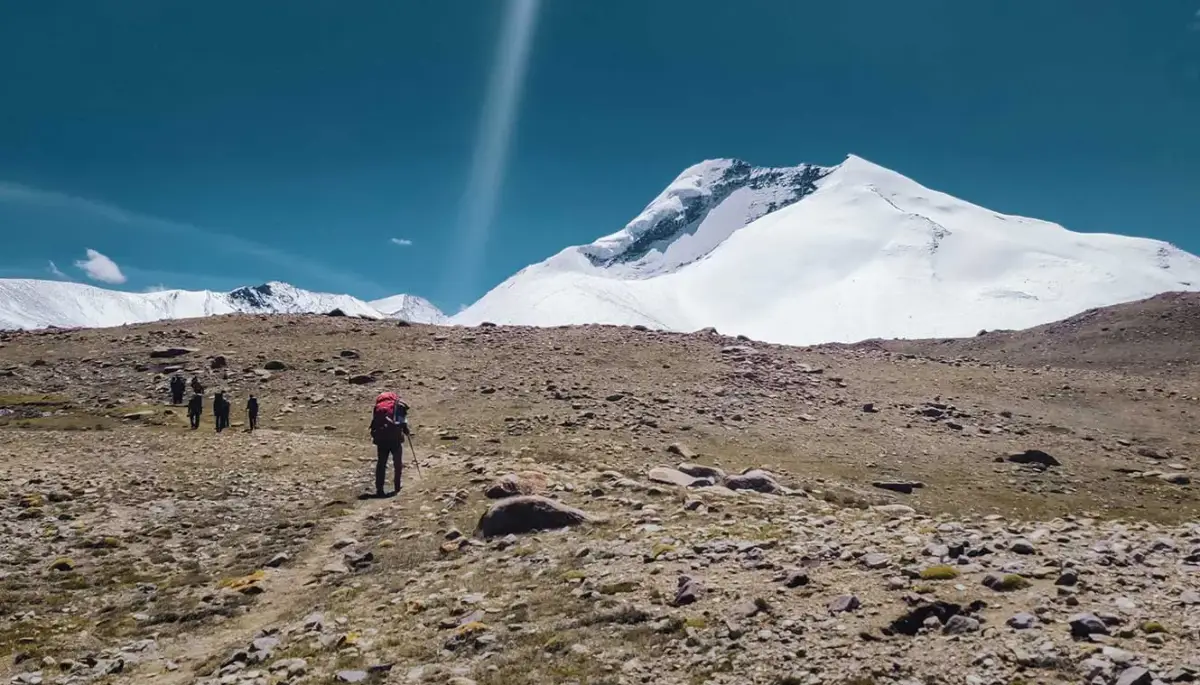
Markha To Hankar
- Altitude: 4,100m/ 13,400 ft.
- Trek Distance: 13 km | 8 - 9 hrs.
- Altitude Gain: 400 m/ 1200 ft.
- Teahouse at Umling Village.
- Last Village Of The Valley.
- View Of A Beautiful Monastery.
- The path will intersect the River a number of times.
- After Umlung, you will have the first look at Mt. Kang Yatse (6,400 m).
- Packed lunch on the way.
Take the most advantage of the innocence of the salient villages because today will probably be the last habitats on the route. Today is one of the most beautiful days of trekking and the views start opening up as you traverse the upper Markha Valley. The trail is beautiful and refreshing when it merges with flowing rivers and streams. These water bodies can also be crossed over a bridge. Umlung village is a small village and will serve as the last teahouse of the trek with yet another serene monastery to your sight.
After Umlung you can get the first sight of Mt. Kang Yatse(6400m). It seems as if the peak is calling you! Follow its voice, again overcome the river several times and enter the Hankar village. Try to spot the magically placed Tacha monastery on a mountain. It is the last hamlet of the trek and your refuge place.
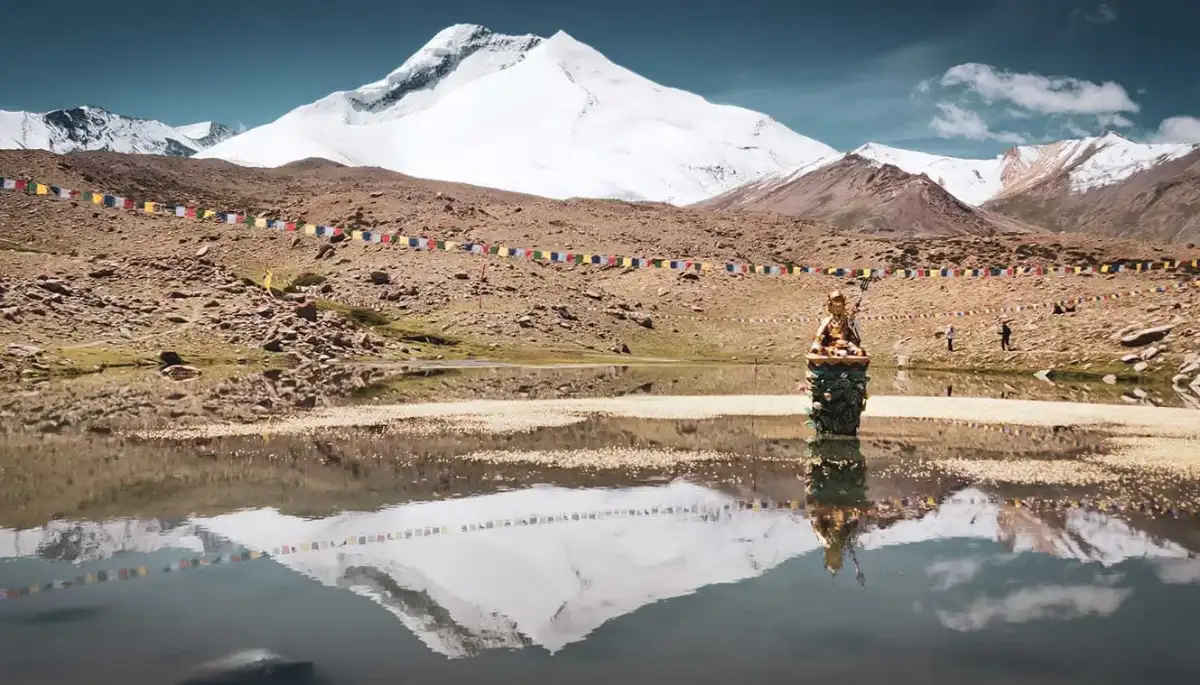
Hankar To Nimaling
- Altitude: 4,800 m/ 15,800 ft.
- Trek Distance: 7 km | 3 - 4 hrs.
- Altitude Gain: 700 m/ 2,400 ft.
- An easy trek.
- Amazing view of Kang Yatse.
- Amazing view of Tigu Lakes.
- Accommodation in a tent.
Get all enthusiastic, after yesterday’s tough trek, today will be an easy and short trek. Start walking and in 1 km you will find diversions or paths separating out. The other route goes to Rupshu and Zanskar. Keep walking on the left path until a stone bridge. This marks that you are on the right trail. Henceforth, you can see many diversions, please be careful and follow the trek leader/guide. In the next 2 hours, the pastures of Thochuntse become visible. There are camping sites and tea houses here. Thochnugtse also has some lovely green fields which are quite a contrast to the aridness of the desert in Ladakh. Keep walking slowly, enjoying the view. The trail is quite steep for like an hour after which becomes a gradual incline.
Try to engulf yourself in nature and move slowly just as you focus on the Kang Yatse peak. The peak seems to grow bigger and bigger. Surprisingly, tranquil twin lakes also come along the path. From the lakes, it is a long and gradual descent to the plateau of Nimaling. The trails enter into a huge grassland after a few fights crossing streams of high altitudes. Sheep, mountain goats, and sometimes rabbits are found grazing at Nimaling. It is a pleasant camping place. It is the highest point you will attain on this trek and being the highest campsite Nimalaing offers spectacular views of the Kang Yatse Peak on the right. There are instances of snowfall at this site hence we prepared for that. Above all that, just try to merge into the high world and sleep in peace.
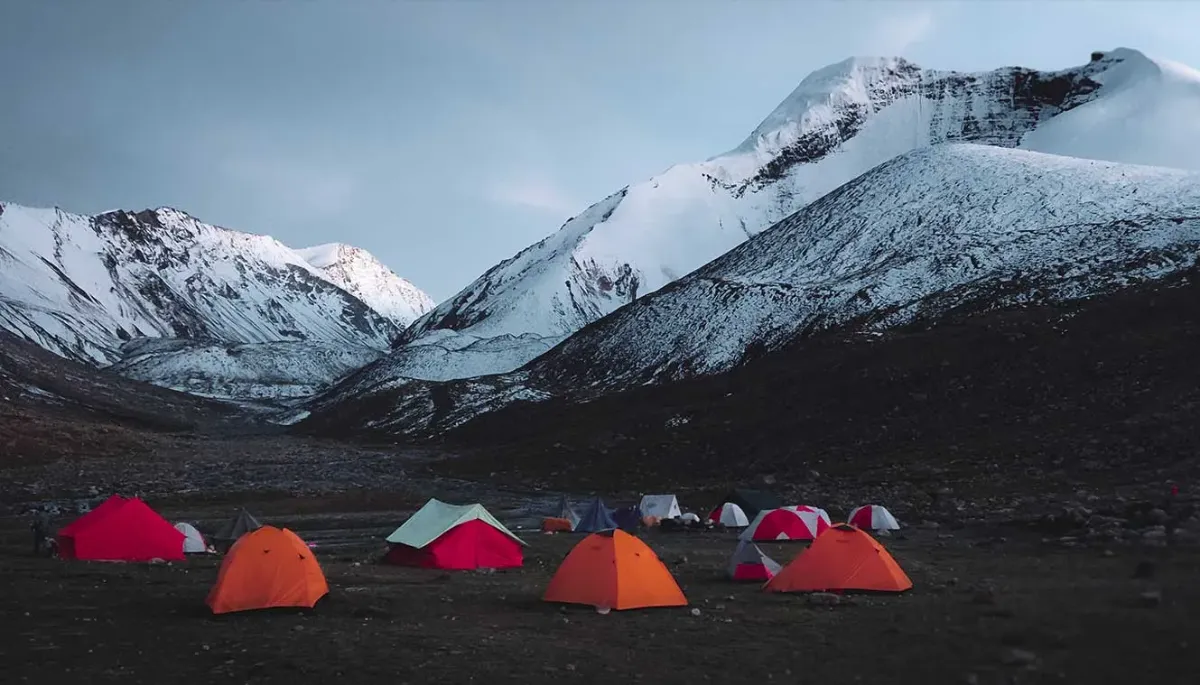
Nimaling To Chokdo via Kongmaru La And Drive To Leh
- Altitude: Kong Maru La - 5,200 m/ 17,100 ft | Chokdo - 3,700 m/ 12,100 ft.
- Drive to Leh: 60 km | 2 hrs
- Descent to Chokdo (Shang Valley) from Kongmaru La is a little long.
- The highest altitude pass crossing along the trek makes it a difficult day.
- Cross a stream terrain and proceed to the north.
- It will take 2 to 3 hrs of a hike for Kongmaru La Pass.
- Amazing views of the Indus and Ladakh Range.
- A steep descent and rocky terrain.
- From Chokdo drive to Leh 60 (2 hrs drive).
- Accommodation in a hotel.
This day will be nostalgic and exciting, as this is the last day of the trek landing at the highest pass of the trek. Kongmaru La is visible distinctly from Nimaling on your left. Also, this day will be filled with surprises. Cross the stream near the campsite and then you will have to follow the clear trail to reach the pass. After a strenuous climb of 2 hours to Kongmaru La pass, you will be pleasantly welcomed by the Karakoram Range Mountains and the excellent array of peaks. Hold your breath for the mind-blowing sight of the huge K2 Mountain, the second-highest peak in the world. There are prayer flags moving along the wind. To your surprise, there is a good network connection from the pass.
The trail then gradually descends, coinciding with villages to say goodbye. The immediate trail from the pass has a steep and narrow descent which later opens to Chikirmo village. The descent can be pretty hard on your knees as it is quite steep. Throughout the route, you can get indulge in the scenery of the Indus Valley and the Ladakh range. After a gradual climb down and rocky terrain, you will reach Chokdo. This is the last stop of the entire trek, which also has many homestays. Get into the pickup vehicle that will take you to Leh.
Take a sigh of relief in this village, as your next stop will be the last stop, Leh. The further road is descending showing the monastery and Hemis Gompa. Fill them in your eyes, heart, and mind. Close your eyes to rewind the entire Markha Valley diaries.
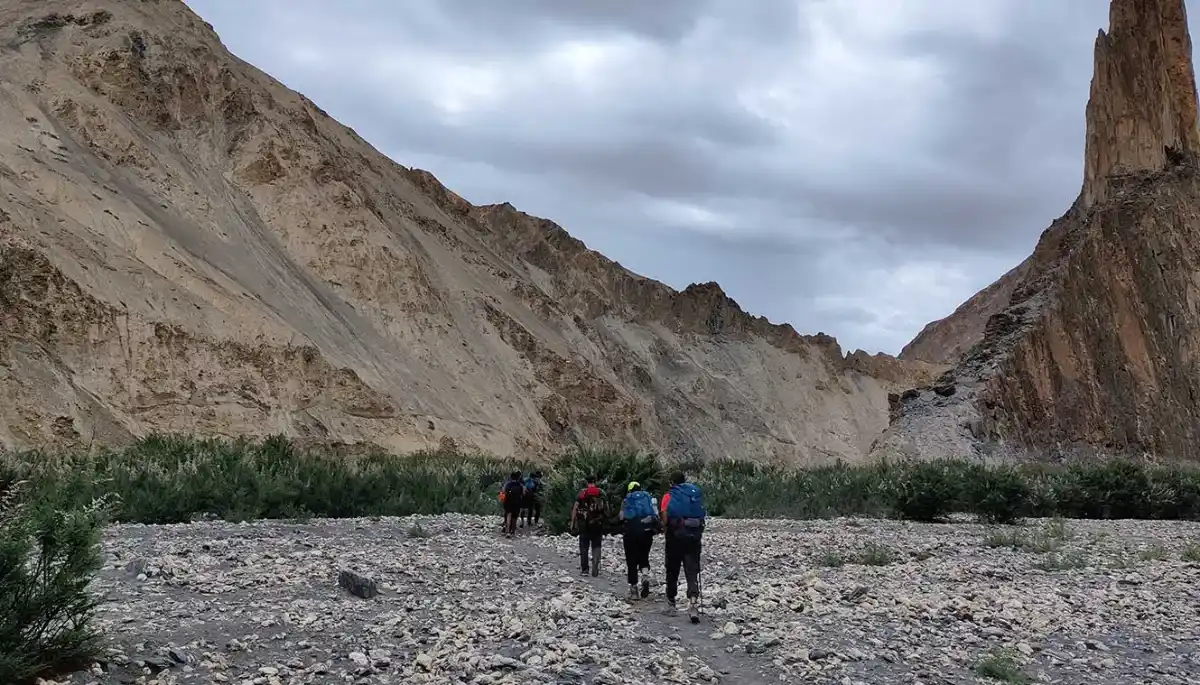
Day-1: Arrival in Leh
- Altitude: 3,500 m/ 11,500 ft.
NOTE: Markha Valley Trek is of 7 days and the highest altitude is of 17,100 ft. If you are looking for more challenging adventure in Leh try out the Twin Peaks Expedition . You can go for either Kang Yatse II or Dzo Jongo Peak as well.
Day-2: Acclimatization in Leh
Day-3: drive from leh to skiu.
- Altitude: Skiu - 3,400 m/ 11,150 ft.
- Drive Distance: 80 km | 4 hrs .
Day-4: Skiu To Markha
Day-5: markha to hankar, day-6: hankar to nimaling, day-7: nimaling to chokdo via kongmaru la and drive to leh.
- Trek Distance: 10 km | 5 - 7 hrs.
- Drive to Leh: 60 km | 2 hrs
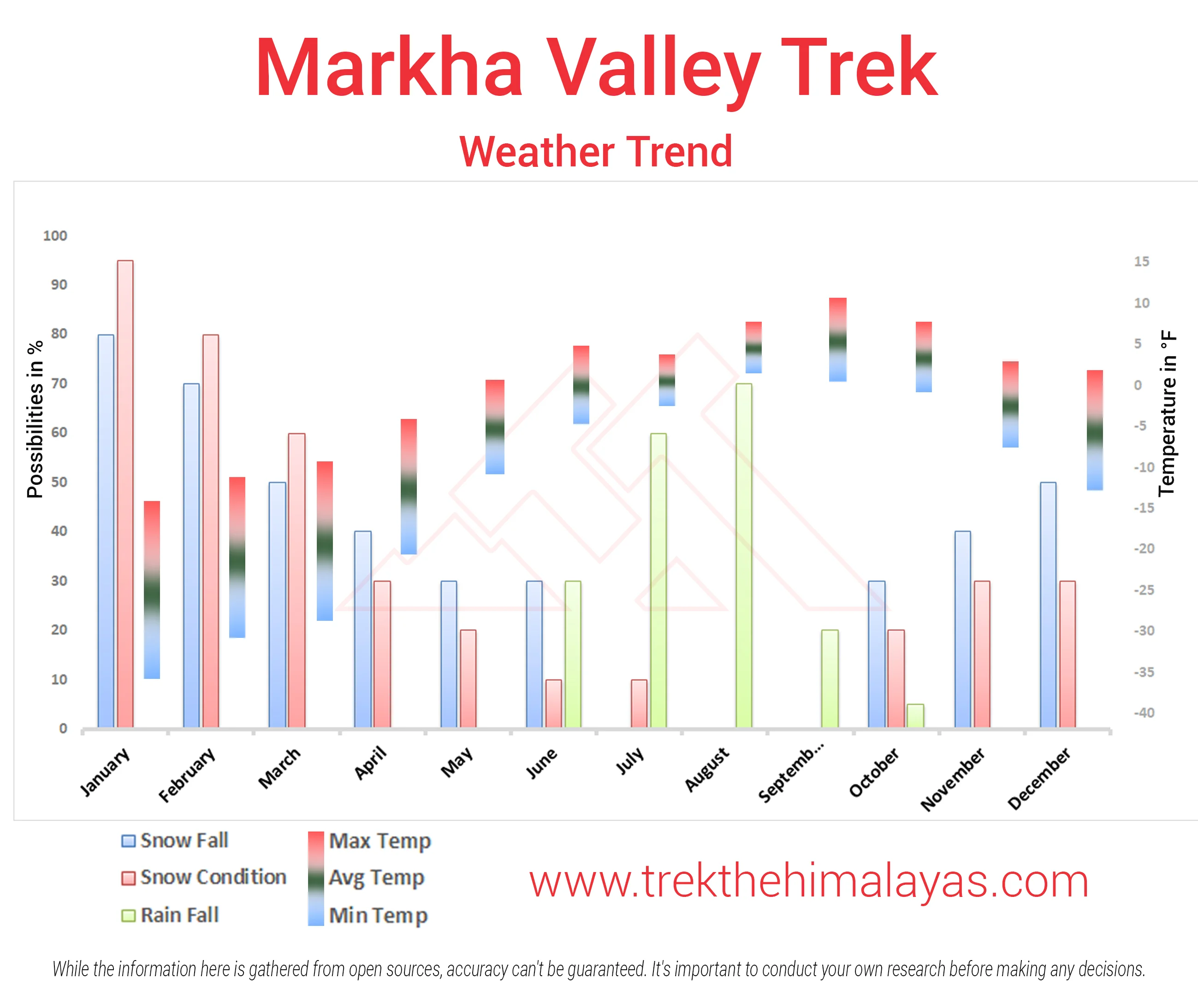
Pulse rate at rest must be in between (60 to 90 beats per minute).
Blood Pressure Reading must be in between (DIASTOLIC 70 – 90, SYSTOLIC 100 - 140 mm Hg).
Respiratory rate at rest must be in between (12 to 20 breaths per minute).
Should not have Liver and kidney issues.
Should not have Diabetes Mellitus, Bronchial Asthma, Heart problems, Hypertension, etc.
No pacemaker implant.
People with Sinus issues, Epilepsy please contact to trek coordinator before booking the trek.
If your BMI is not normal, Please contact our Trek coordinator before Trek booking.
Medical & Disclaimer Form (Mandatory Documents) Click here to download Medical & Disclaimer Form
- Government Employees can avail the benefit of Special Casual Leave (SCL) when they join us for a trekking expedition. As per the rules of the Pay Commission, Special Casual Leave can be availed for up to 30 days in a calendar year for trekking/mountaineering expeditions through a registered organization. Trek The Himalayas is a registered adventure tour operator by the Indian Mountaineering Foundation (IMF) and the Ministry Of Tourism (MOT).
- Trekkers have to apply for leave at least 20 days before the trek departure date.
- This service is exclusive to Indian government employees and is applicable only for treks within India.
- Do mail at info@trekthehimalayas to apply and mention your booked trek date and trek name.
Junior trekkers (below 15 years) should have a company of parents/guardians.
Trekkers between 15 to 18 years can come solo with the disclaimer form signed by parent/guardian.
- Medical & Disclaimer Form (Mandatory Documents) Click here to download Medical & Disclaimer Form
Exercise For Moderate to Difficult
Fitness Regime For:
Calculate Your Bmi
Your BMI value is
Congratulations, your body is in good conditions!
Medical & Disclaimer Form (Mandatory Documents) Click Here.
How To Reach
It is essential for everyone to arrive at Leh (01:00 pm)
Upon booking the trek, your trek coordinator will furnish you with the hotel details.
Choose any option to reach Leh
The easiest and best way to travel is to fly to Kushok Bakula Rimpochi Airport located in Leh. It is just 4 km away from the main city. The airport is well connected to Delhi and also receives flights from Mumbai, Srinagar, Jammu, Chandigarh, and other general destinations in India. Even international travelers can fly directly from major cities like Kolkata, Mumbai, and Delhi. You can find taxis outside the airport or book a cab to reach the required destination.
There are two road routes to Leh
Manali (Himachal Pradesh ) to Leh via Baralacha La, Lachulung La and Tanglang La and It covers a distance of 500 km.
Srinagar to Leh via Zoji La, Lamayuru Lunar Landscape and Kargil and It covers a distance of 450 km.
You cannot reach Leh directly by train as there is no train station in Ladakh. The nearest railway station is Jammu Tawi (700 km from Ladakh) which is well connected with Delhi, Kolkata and Mumbai.
For your return journey from Leh, you have the flexibility to choose between road or air transport options. Please note that our services extend only to the hotel, and the standard hotel check-out time is 11:00 am, if you opt for an air transport then please ensure an early check-out in the morning, as all flights operate during the morning hours
It's highly advisable to keep 2 buffer day in your travel plan. If the buffer day is not needed, it can be used to explore Leh.
.webp)
1. Accommodation (as per the itinerary):
- Guest house in Leh on Day 1, day 2 and day 7 as per the itinerary.
- Camping/Home stay during the trek.
2. Meals (Veg + Egg):
- All meals while on trek (Pure Veg) as per itinerary from day 3 lunch to day 7 packed lunch.
3. Support:
- 1 Versatile base camp manager handles communication and deploys extra manpower in emergencies.
- 1 Mountaineering & First aid qualified professional trek Leader.
- 1 Experienced high altitude chef.
- Local experienced guides (Number of guides depending on the group size).
- Enough support staff.
4. Trek equipment:
- Sleeping bag, Sleeping liners (if required), Mattress, Utensils.
- 3 men all season trekker tent (twin sharing), Kitchen & Dining tent, Toilet tent.
- Camping stool, Walkie talkie.
- Ropes, Helmet, Ice axe, Harness, Gaiters & Crampon (if required).
5. First aid:
- Medical kit, Stretcher, Oxygen cylinder, Blood pressure monitor, Oximeter, Stethoscope.
6. Transportation (as per the itinerary).
- Transport from Leh guest house to Zinchen and return from Chokdo as per the itinerary.
7. Mules/porters to carry the central luggage. 8. Clock room facility available at the base camp for additional luggage. 9. All necessary permits and entry fees, Upto the amount charged for Indian.
10. Trek Completion Certificate.
1. Insurance (Mandatory). 2. Food during the transit. 3. Any kind of personal expenses. 4. Mule or porter to carry personal luggage. 5. Emergency evacuation, hospitalization charge or etc. 6. Anything not specifically mentioned under the head Inclusion. 7. Airfare and pickup and drop from airport. 8. Environment fee/inner line permit : Rs. 600 per person.
Things can be provided on demand and availability (participant has to pay extra for these things).
1- Satellite phone/set phone - is a type of mobile phone that connects via radio links via satellites orbiting the Earth instead of terrestrial cell sites like cellphones. Therefore, they can operate in most geographic locations on the Earth's surface.
2- Gamow/PAC HAPO Bag (Portable Hyperbaric Bag) - is a unique, portable hyperbaric chamber for the treatment of acute mountain sickness (AMS), also known as altitude sickness.
3- AEDs (Automated External Defibrillators) - are portable life-saving devices designed to treat people experiencing sudden cardiac arrest, a medical condition in which the heart stops beating suddenly and unexpectedly.
Cancellation terms:
Cancellations prior to 25 days from the start of the Trip
Refund options
- 5% deduction of trek fee
- 100% cash voucher for any trip till one year
- Transfer your trek (any trek, any date) to your friend
Cancellation between 24 days and 15 days to the start of the Trip
- 30% deduction of trek fee
- 100% cash voucher for same trip till one year
- 85% cash voucher for any trip till one year
- Transfer your trek (same trek, any date) to your friend
Cancellation between 14 days and 10 days to the start of the Trip
- 50% deduction of trek fee
- 80% cash voucher for same trip till one year
- 70% cash voucher for any trip till one year
- Book the same trek, in the same season, with any other batch
Cancellation less than 9 days to the start of the trek
- No cash refund
- 20% cash voucher for the same trip till one year
- 10% cash voucher for any trip till one year
- Transfer your trek (same trek, same date) to your friend
Note- If a booking is made using a voucher or discount code, the policies related to vouchers and discounts cannot be modified.
In the unlikely event that TTH cancels a trek prior to the scheduled departure date:
While it is extremely rare for TTH to cancel a trek, we understand that unforeseen circumstances or natural disasters may occasionally require us to do so before the scheduled departure. These circumstances could include continuous rain or snow, thunderstorms, snowstorms, landslides, floods, earthquakes, or any other natural calamity that poses a risk to the safety of our trekkers. Additionally, unforeseeable events such as local riots, curfews, pandemics, lockdowns, government orders, or any similar situations that compromise the safety of the trekking experience may also necessitate a cancellation.
In the event of such a cancellation, TTH will provide you with a voucher equivalent to the amount you paid for the trek. This voucher can be redeemed for any of our treks within the next year, allowing you to still enjoy an adventure with us at a later date.
The issuance of a voucher is not applicable in situations where you are required to descend from the trek for any reason. The trek leader may make the decision to send you down from the trek due to factors such as insufficient fitness level, symptoms of Acute Mountain Sickness (AMS), high blood pressure, exceeding the designated turn-around-time, health concerns, or if you are found smoking, drinking, or violating the rules set for the trek. In such cases, the provision of a voucher does not apply.
In the rare event that TTH shifts a trek:
We would like to emphasize that weather conditions in high-altitude areas are highly unpredictable and can undergo sudden changes at any time, irrespective of the day. Additionally, circumstances beyond our control, such as natural disasters, political unrest, pandemics, and lockdowns, may impact the feasibility of conducting a trek. In cases where we are unable to proceed with an event due to such circumstances that are beyond our direct control, we will make every effort to provide you with an alternative trek that is safer and more suitable.
In such situations, we will issue a voucher to offset the cost difference between the originally scheduled trek and the alternative trek. This voucher can be redeemed at any time within one year from the date of issue. Please note that a refund fee or reimbursement of the cost difference is not applicable in these cases.
- Change of trek batch is dependent on the availability of seats in the batch
- In case of transferring a trek to a friend, he/she should satisfy all the mandatory requirements put forward by TTH
- TTH holds the right to change/cancel the policies, without prior notice
- Cash refund is applicable only in case of bookings made without using any promotional offer code or vouchers
Cash Voucher Terms:
- This is a non-transferable voucher
- The voucher cannot be merged with any other offer of Trek The Himalayas
- The voucher is valid for Trek booked directly with Trek The Himalayas in India
- To avail the voucher please use your register phone number or e-mail id
- All the other Terms of booking a trek with Trek The Himalayas are applicable to the voucher
- Trek The Himalayas holds rights to add/remove any of the Terms and Conditions without prior notice
Itineraries are based on information available at the time of planning and are subject to change. "Trek The Himalayas" reserves the right to change expedition dates, people or itineraries as conditions warrant. If a trip must be delayed or the itinerary changed due to bad weather, road conditions, transportation delays, government intervention, airline schedules, sickness, or other contingency for which TTH or its agents cannot make provision, the cost of delays and/or other changes are the responsibility of the participant. TTH reserves the right to decline, or accept, any individual as a trip member for any reason whatsoever.
Trek Essentials
PDF Of Trek Essential Download
Frequently Asked Questions(FAQ)
How to register/create an account with tth.
To register with TTH, visit our website - www.trekthehimalayas.com and create your account. To create your account you will need to use your email address and fill in all the details, set your unique password and your account is ready to use.
How to book a trek?
- To book a trek with TTH, you first need to register with us and create an account.
- Choose the trek that you want to do and click on available dates.
- You will land at the login page, fill in the required details.
- Add Participants, choose add-on services click on the Pay now button, choose your preferred payment method, and make the payment. TTH accepts multiple payment options, including credit/debit cards, net banking, and UPI.
- You will receive a confirmation email from TTH with all the necessary details about the trek, including the meeting point, transportation, accommodation, and other important instructions.
Click Here to watch Video
Made a payment but did not receive any confirmation.
please send an email to us at [email protected] or reach out to the numbers provided in the Help and Support section of your Trek Page. We will ensure that your issue is promptly resolved.
How to book off-load luggage and transportation?
To book services such as off-load luggage and transportation, you can find them listed as add-ons. These additional services can be booked at the time of your initial booking. If you miss booking add-ons during the initial reservation, you can log in anytime and easily book 4 days before the departure date add-ons through the platform.
If I have booked the wrong trek or date, how can I make changes?
In such a situation, please log in to your account and transfer your trek or date to the desired one within 12 hours or drop us an email at [email protected] 10 days before the departure date of the trek. After the initial 12-hour period, any changes will be processed according to the cancellation policy.
I am a beginner and confused which trek to book.
We recommend visiting our "Suggest Me a Trek" page. By filling out the form, our experts will contact you with the best possible trek options based on your preferences and experience level. Alternatively, you can reach out to us via email at [email protected] or give us a call using the numbers provided on our website for personalized assistance and recommendations.
How is family trek different from regular trek?
Family treks differ from regular treks by focusing on ease of difficulty, offering shorter durations for younger participants, Kid-friendly and easily digestible foods, child-friendly activities, maintaining a higher guide ratio for diverse age groups, and implementing additional safety measures for families.
Ideal treks for children.
Family Trek with Kids recommendation Only Dayara Bugyal and Chopta Chandrashila Trek.
Minimum age for children to trek with TTH.
Minimum age for TTH treks is typically 7 years, though this may vary depending on the specific trek.
Can we take children to high altitudes with their guardian?
Yes, you can take a kids to a high-altitude trek with a parent. Discuss with a trek expert before booking a trek.
Can we send kids without Parents/guardian?
Medical & Disclaimer Form (Mandatory Documents) Click here to download medical and disclaimer form
How to prepare a child for a high altitude trek?
Physical Fitness: Ensure your child is physically fit. Engage them in regular exercise, outdoor activities, and hikes to build stamina and endurance. Hydration: Emphasize the importance of staying hydrated at high altitudes. Encourage your child to drink water regularly, even if they don't feel thirsty. Proper Nutrition: Provide a well-balanced diet with sufficient carbohydrates for energy and foods rich in iron to prevent altitude sickness. Adequate Sleep: Ensure your child gets enough sleep in the days leading up to the trek. Quality rest is crucial for altitude adaptation. Educate on Altitude Sickness: Teach your child about the symptoms of altitude sickness, such as headache, nausea, and dizziness. Encourage them to communicate any discomfort immediately. Appropriate Clothing and Gear: Dress your child in layers to adjust to changing temperatures. Ensure they have appropriate trekking gear, including sturdy footwear. Positive Mindset: Foster a positive mindset. Encourage your child, and let them know it's okay to take breaks when needed. Medical Check-Up: Schedule a medical check-up before the trek to ensure your child is fit for high-altitude activities. Consult with a healthcare professional about any potential health concerns.
Kind of food will be served during the trek for children.
TTH takes special care to provide wholesome and nutritious food for children on treks. Here are some of the foods that are typically served for children: Breakfast: For breakfast, TTH serves a variety of options like porridge, cornflakes, bread, butter, jam, honey, boiled eggs, omelettes, and pancakes. Children can choose from these options to fuel themselves for the day's trek. Lunch: For lunch, TTH serves lunch which includes rotis, vegetables, rice, dal, and salad. The rotis are usually made fresh on the trek and are a good source of carbohydrates. The dal and vegetables provide protein and other essential nutrients. Snacks: TTH provides healthy snacks like fresh fruits, dry fruits, energy bars, cookies, and biscuits to keep the children energized throughout the day. Dinner: For dinner, TTH serves a hot and wholesome meal which includes soup, rice, dal, vegetables, and a non-vegetarian dish (if requested in advance). Children can also choose from a variety of desserts like custard, jelly, and fruit salad. Dietary requirements: If a child has any special dietary requirements, TTH can cater to those needs as well. For example, if a child is lactose intolerant or allergic to nuts, the kitchen staff can make arrangements to accommodate those requirements.
How to choose the right trek?
Choosing the right trek for a beginner can be a bit overwhelming as there are many factors to consider such as distance, elevation gain, terrain difficulty, weather, and time of year. Here are some tips that can help you choose the right trek for a beginner:
1. Determine fitness level: Assess the fitness level of the beginner to understand their physical capabilities. This will help you select a trek that is challenging but not too difficult.
2. Choose a well-traveled trail: A well-traveled trail will have more amenities such as signposts, water stations, and shelter. It is also safer as there will be other hikers on the trail.
3. Consider the length of the trek: For beginners, it is recommended to start with a shorter trek that can be completed in a day or two. This will help them get acclimatized to trekking and build their confidence.
4. Look for gradual elevation gain: Choose a trek with a gradual elevation gain rather than steep ascents. This will make the trek easier and more enjoyable.
5. Check the weather: Check the weather forecast before selecting a trek. Avoid treks during the monsoon season or winter when the trails can be slippery or dangerous.
6. Research the trail: Read about the trail to get an idea of the terrain, altitude, and difficulty level. This will help you select a trek that is suitable for the beginner.
7. Consult with an expert: If you are unsure about which trek to choose, consult our trek expert Mr. Nitin (+91 70600 59773) between 10 AM to 6 PM (Tuesday - Friday). Mr. Nitin will provide you valuable advice and guidance.
Overall, it is important to choose a trek that is enjoyable, challenging but not too difficult, and suitable for the beginner's fitness level and experience.
Can a beginner choose a tough trek?
It is not recommended for a beginner to choose a difficult Himalayan trek. Trekking in the Himalayas can be physically and mentally challenging, especially if you are not used to the high altitude, steep slopes, and rugged terrain. Choosing a difficult trek without the proper experience, fitness level, and preparation can be dangerous and put you at risk of altitude sickness, injury, and other hazards.
If you are a beginner, it is recommended to start with an easier trek and gradually build up your skills and experience. This will help you understand the challenges of trekking in the Himalayas, and also prepare you physically and mentally for a more difficult trek in the future. It is also important to choose a trek that matches your fitness level, experience, and interest.
What is the age limit for a beginner trekker?
There is no specific age limit for a beginner trekker. However, it is important to consider your physical fitness, health condition, and personal interests before embarking on a trek. Trekking in the Himalayas can be physically and mentally demanding, and requires a certain level of physical fitness and endurance.
If you have any pre-existing medical conditions or are above a certain age, it is recommended to consult with a doctor before embarking on a trek. It is also important to listen to your body and take breaks as needed during the trek to prevent exhaustion or injury.
If I am solo, can I join the trek in a group?
Yes, you can join the trek. We have fixed departure groups where you can simply book your trek and we will take care of curating a group.
How does my family get updated about my Trek?
Before you start the trek, it is recommended that you make all the necessary phone calls as during the trek you may or may not receive network coverage, once you come back to the Base Camp, you can reconnect with your family via phone once again. You can share your trek coordinator contact detail with your family members to get the latest updates about your trek batch.
What food can I expect?
At TTH, we provide wholesome and nutritious meals during the trek. The food is vegetarian and includes a variety of dishes such as rice, dal, vegetables, chapati, paratha, pasta, noodles, and soup. We also offer snacks such as biscuits, and salty, and dry fruits during the trek. Special dietary requirements such as vegan, gluten-free, or Jain food can also be arranged if informed in advance.
I am allergic to some foods.
If you are allergic to some foods, you need to let us know in advance so that we can make arrangements accordingly.
How safe is trekking with TTH?
TTH is a trekking company that prioritizes the safety of all its participants, including women trekkers. They have a comprehensive safety system in place, which includes a dedicated team of experienced and trained trek leaders and support staff who are equipped to handle emergency situations and provide first aid.
TTH also takes specific measures to ensure the safety and comfort of women trekkers. They have a separate tent accommodation for women trekkers, female trek leaders, and support staff. They also provide separate toilet facilities for women and encourage a safe and respectful environment for all trekkers.
Moreover, TTH has a strict policy against any kind of harassment and has a zero-tolerance policy towards such incidents. They have a designated Internal Complaints Committee (ICC) to investigate and address any complaints related to harassment or misconduct. Overall, TTH has a good reputation for safety and responsible trekking practices, and women can feel comfortable and safe while trekking with them.
How TTH will manage if I am the only woman in the group?
In case you are the only women in the group, we provide a single sleeping arrangement. Also, during the trek, the trek leader will always remain by your side to provide optimum safety and reassurance.
How can I know that other women are in the batch?
You can reach out to the trek coordinator to inquire about the number of female trekkers and their respective states who have booked the trek. Please note that the trek coordinator cannot disclose personal details of any trekker. Once you've confirmed your booking, a WhatsApp Group will be created for all the trekkers in your batch. This allows you to connect with fellow trekkers before the trek begins.
Can I know in advance, which trek is led by a women Trek Leader?
While many of our treks are led by female trek leaders, however, it is not possible to know which trek leader is assigned to which group. But nonetheless, whether the trek leader is male or female you can be completely assured of your safety and security with us.
Can I trek with periods? If yes, then where can I dispose of the sanitary pad?
Yes, it is possible to trek with periods. However, it is important to take some extra precautions and preparations to ensure a comfortable and safe trekking experience.
Here are some tips that can help you trek during your period:
1. Use menstrual hygiene products that you are comfortable with, such as tampons, pads, or menstrual cups. It is recommended to carry enough supplies for the entire duration of the trek.
2. Pack wet wipes, hand sanitizer, and plastic bags to dispose of used hygiene products.
3. Wear comfortable and breathable clothing that allows for easy movement and reduces friction. Avoid wearing tight or restrictive clothing that can cause discomfort.
4. Carry pain relief medication, such as ibuprofen or acetaminophen, in case of menstrual cramps.
5. Stay hydrated and maintain a balanced diet to support your energy levels and overall health.
6. Take breaks as needed and listen to your body. If you feel uncomfortable or experience any unusual symptoms, seek medical attention immediately.
It is also recommended to consult with a doctor before going on a trek during your period, especially if you have a pre-existing medical condition or are taking medication. By taking necessary precautions and being prepared, you can have a safe and comfortable trekking experience even during your period.
We provide proper disposal facilities for sanitary pad disposal during the trek.
How will the accommodation be during the trek?
We offer three person tents with twin-sharing for optimum comfort. A woman trekker will share a tent with another woman trekker and if you are the only woman in the group, you will be given a single accommodation for your comfort and privacy.
Are trek poles, Jackets and other equipment available for rent from Trek The Himalayas?
Yes, we do provide gears on rent. You can book it using you TTH account directly.
Who will be with us on the trek from Trek The Himalayas?
Mountaineering qualified Experienced and first aid certified Trek Leader, First Aid Certify local guide, Cook, helpers and supporting staff.
Who can not join the trek?
People suffering from Bronchitis, Asthma, High blood pressure, Epilepsy (got faints), TB , Heart problem or on higher BMI side are strictly not allowed to go on any Himalayan trek. Apart from this if you had any medical history, please let us know.
When it gets really cold can I consume alcohol?
No. Alcohol and smoking isn’t allowed while on trek. It is totally misconception that it will keep you warm. Your body need to acclimatize properly and for that eat properly and drink enough water; these things will keep you warm.
What type of toilet facility is TTH providing at the trek?
Toilet tents provide a convenient solution for answering nature's call in the great outdoors. Dry toilets, in particular, offer a highly sanitary approach. By digging a pit and utilizing mud and a shovel, you can easily cover up your waste. This method ensures cleanliness and hygiene while camping or exploring in the forest.
Remember to pack essential toiletries to complete your outdoor bathroom kit and maintain proper personal hygiene during your adventures. With these practices in place, you can enjoy nature while also respecting it.
How do I manage the negative temperatures on the trek at higher camps? Do I need special jackets?
Layer Up From Head To Toe Eat Full Meals, never sleep empty stomach You can keep warmee (if you’re more susceptible to cold). Use sleeping bag in right way and don’t leave free space in sleeping bag.
For upper body – Thermal layer – T-shirt (full-sleeves) – Fleece T-shirt (for extreme colds) – Fleece layer – Thick Jacket/Down Jacket – Waterproof or Windproof layer (outermost layer, when it is snowing or raining) - For Lower Body – Thermal layer – Hiking pants (normal) or Winter hiking pants
Based on how warm you feel you can skip any of the above layers. Your outer later should be windproof since it is windy at high altitude. The idea behind layering is that the more insulation you have the less cold you feel, and instead of wearing a very thick jacket if you wear multiple layers, your body will be better insulated against the cold.
Do you provide crampon/micro spikes and gaiters?
Yes, we provide micro spikes and gaiters, if required.
What documents need to carry on trek?
Mandatory documents: 2 xerox of ID having address (addhar card/driving license), 2 Passport size photographs, hard copy Medical form signed & sealed by doctor, disclaimer form sign by trekker and high altitude insurance.
If we come prior the trek date, Do you provide accommodation?
No. We don’t but we can suggest you good hotel/Stay nearby pick up location.
Do we get enough water for drinking?
Yes, trekker must carry 2 water bottles 1 litre each so they can refill it at campsite for drinking and keep themselves hydrate.
What kind of shoes we should buy for the trek?
You should buy shoes which has these three features –Good grip, Ankle Support and additional water resistant layers. Generally, we advise Quechua Trek 100, MH 500 and MH 100.
What happens if some members of the team need to turn back before the summit?
No one is forced to go on. There is always enough staff to split the party according to need and regroup later at the camp. Most people have no trouble reaching the highest campsite. If some members decide not to climb the final distance they can wait for the climbers to come back down the same way or take a lateral path to the descent route.
What makes Trek The Himalayas Best Trekking Company in India?
Trek The Himalayas is the safest and most trusted trekking organization in India. Our deep expertise and commitment ensure that each trekker can fully immerse in the Himalayan beauty while experiencing a well-organized and memorable journey. We are proud to be recognized among the best trekking companies in India and have been awarded the PHD Samman Award two years consecutively for Best Adventure Tour Operator . Our founders, themselves are proficient mountaineers and belong to the hilly states of India. At TTH we follow all the safety protocols. Our Trek Leaders are expertly trained in First Aid and Acute Mountain Sickness (AMS) management. The extensive experience is a key factor in establishing us as the best trekking company in India .
Explore the best trekking companies in India and see what sets them apart.
Is it necessary to hire a guide for the Markha Valley Trek?
While it is not mandatory to hire a guide for the Markha Valley Trek , it is highly recommended, especially if you are new to the area or inexperienced in trekking. A guide can help you navigate the route, provide information about the local culture and history, and ensure your safety throughout the trek.
What is the best time of year to do the Markha Valley Trek?
The best time to do the Markha Valley Trek is from mid-June to mid-September when the weather is relatively mild and dry. However, it is important to note that the weather in the mountains can be unpredictable, and trekkers should be prepared for sudden changes in temperature, precipitation, and other weather conditions.
What kind of physical fitness is required for the Markha Valley Trek?
The Markha Valley Trek is a moderately difficult trek that requires a good level of physical fitness. Trekkers should be able to hike for 5-6 hours a day, sometimes at high altitudes, and carry a backpack weighing up to 10 kg. Prior trekking experience is helpful, but not necessary.
Is altitude sickness a concern on the Markha Valley Trek?
Yes, altitude sickness is a concern on the Markha Valley Trek, as the highest point on the trek reaches an altitude of 5,212 meters. Trekkers should take proper precautions, such as acclimatizing gradually, staying hydrated, and taking medication if necessary.
What kind of accommodation is available on the Markha Valley Trek?
Accommodation on the Markha Valley Trek is primarily in basic guesthouses and homestays, with limited options for camping. Trekkers should be prepared for rustic conditions and bring their sleeping bags and other camping gear if they plan to camp.
What kind of wildlife can be seen on the Markha Valley Trek?
The Markha Valley is home to a variety of wildlife, including ibex, blue sheep, marmots, and various species of birds. While sightings are not guaranteed, trekkers should keep an eye out for these animals and respect their habitats.
Are permits required for the Markha Valley Trek?
Yes, permits are required for the Markha Valley Trek , as it passes through the Hemis National Park. These permits can be obtained from the park office in Leh or through a trekking agency.
What kind of equipment do I need to bring for the Markha Valley Trek?
Trekkers should bring appropriate clothing and footwear for trekking in mountainous terrain, as well as a sleeping bag, camping gear (if camping), and a backpack. Other essential items include sunscreen, sunglasses, a hat, a water bottle, a first aid kit, and any necessary medications. It is also important to bring cash for food, lodging, and other expenses along the way.
How do I get to the starting point of the Markha Valley Trek?
The starting point of the Markha Valley Trek is the village of Chilling, which can be reached by road from Leh. Private taxis and shared taxis are available for hire, and some trekking agencies also offer transportation services.
Can the Markha Valley Trek be done in reverse?
Yes, the Markha Valley Trek can be done in reverse, starting from the village of Shang Sumdo and ending in Chilling. However, this route is less popular and may require additional planning and preparation.
Explore Most Informative Articles on Markha Valley Trek
Trekking in india and the himalayas.
Explore Indian Himalayan monsoon treks like Markha Valley, Hampta Pass, Valley of Flowers. Amid COVID, trekking offers solace, attracting more enthusiasts seeking mental wellness in nature's embrace.
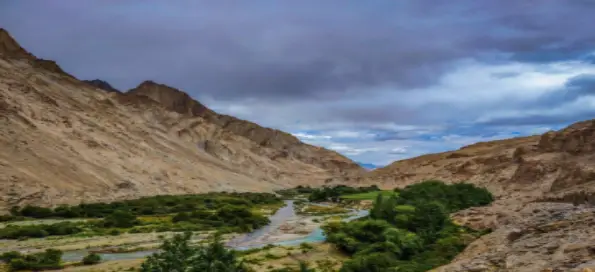
Top summer Himalayan treks never to miss
Top Himalayan treks: Rupin, Goechala, Har ki Doon, Buran Ghati, Gaumukh Tapovan, Kedartal, Pangarchulla, Kashmir Great Lakes, Markha Valley, Pindari, Bali Pass, Chopta Chandrashila.
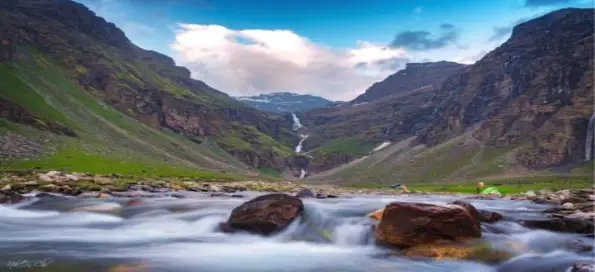
Make incomplete Stok Kangri trek complete with Markha Valley trek
Elevate your adventure: Complete Stok Kangri trek with Markha Valley. From summiting peaks to traversing vibrant valleys, experience the best of the Himalayas in one epic journey.
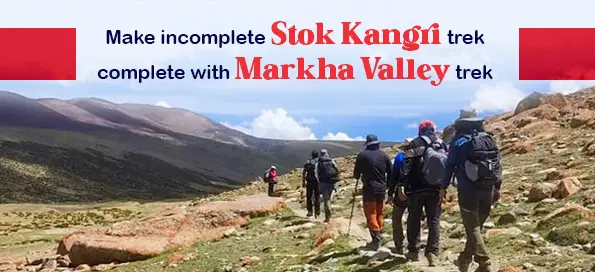
Discover the thrilling adventures of Ladakh
Ladakh is a land of immaculate natural beauty and a hub for trekking and adventure activities.Embark on the thrilling adventures of Ladakh, a land of unparalleled natural beauty and adrenaline-pumping activities. With our exclusive offer of 10% off on packages, dive into the heart of Ladakh's magic. Discover the Ladakh Multisports Adventure, a journey through stunning landscapes and heart-racing activities like white water rafting and treks to iconic spots like Khardung La and Pangong Tso. For the daring, tackle the Kang Yatse II Peak Trek, a challenging ascent offering breathtaking views of the Karakoram and Zanskar ranges.
Or, immerse yourself in the allure of Dzo Jongo Peak, a majestic trek amidst picturesque villages and stunning vistas of Stok Kangri. For the ultimate adventure, opt for the Twin Peak Expedition, conquering both Kang Yatse II and Dzo Jongo in one thrilling journey. Don't miss this chance! Book now and seize the adventure of a lifetime in Ladakh. Offer valid till 20th May .
.webp)
11 Best Himalayan Treks in India witness the Himalayan local culture
Discover the 11 best treks in India and their charming base villages. Jhaka Village on the Rupin Pass Trek clings to a cliff, offering stunning views and rich local culture. Natin on the Dayara Bugyal Trek showcases clear Himalayan vistas and colorful homes. Markha Village on the Markha Valley Trek is remote yet vibrant with Buddhist heritage. Tugasi on the Pangarchulla Trek features lush fields and friendly locals. Osla on the Har Ki Doon Trek preserves ancient wooden architecture and traditions. Sankri, the winter jewel of the Kedarkantha Peak Trek, transforms seasonally from snowy wonderland to blooming paradise. Sonmarg on the Kashmir Great Lakes Trek is a picturesque paradise. Kibber on the Kanamo Trek offers snow-covered arid landscapes and wildlife. Yunam near Keylong is a biker’s haven. Khati on the Pindari Glacier Trek offers Kumaoni culture and forest beauty. Sari on the Chopta Trek provides clear summit views and vibrant rhododendrons. These villages enhance the trekking experience with their unique charm and beauty.
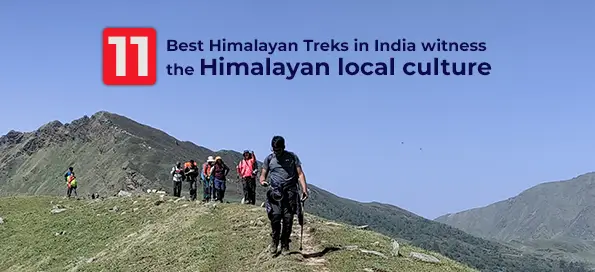
40 Best Himalayan Treks in India for 2024
Discover the 40 Best Himalayan Treks in India for 2024! The Himalayas, stretching across India’s northern frontier, offer a stunning array of trekking adventures suitable for all skill levels. From the iconic Everest Base Camp to the serene Valley of Flowers, each trek unveils unique landscapes, diverse flora, and vibrant cultures. Whether you're seeking challenging climbs, scenic hikes, or cultural experiences, the Indian Himalayas have something for every adventurer. Explore these top treks to embrace breathtaking views, ancient trails, and unforgettable journeys in one of the world's most majestic mountain ranges. Gear up for an extraordinary trekking experience in the Himalayas.
.webp)
Markha Valley Trek - Snow Leopard Valley
Embark on the Snow Leopard Valley - Markha Valley Trek with Trek The Himalayas, an extraordinary odyssey through Ladakh’s rugged and awe-inspiring beauty. This trek takes you through a diverse array of stunning landscapes, from barren high-altitude deserts to lush green valleys nestled between towering peaks. Along the way, witness ancient monasteries that offer a glimpse into Ladakh's rich spiritual heritage. The trek provides a unique opportunity to spot elusive wildlife, including the majestic snow leopard, as you traverse remote regions of the valley. Marvel at panoramic views of snow-capped mountains, serene meadows, and intricate rock formations that define this enchanting landscape. Each day of the trek unveils new wonders, combining natural beauty with cultural richness. Join Trek The Himalayas for an unforgettable adventure that immerses you in the heart of Ladakh’s pristine wilderness and spiritual allure.
.webp)
Best Summer Treks in India - Trek The Himalayas
Experience the thrill of summer with Trek The Himalayas' exclusive offer on the best summer treks in India. Our summer treks provide an opportunity to discover hidden gems in the mountains, offering stunning natural landscapes and exhilarating adventure. Whether you're seeking serene meadows, lush forests, or breathtaking mountain views, our treks are designed to immerse you in the beauty of the Himalayas. With our affordable trekking packages, you can enjoy a memorable adventure without breaking the bank. Book now to take advantage of our special savings and embark on a journey that combines adventure, natural beauty, and the joy of summer exploration. Join us for a summer trek that will leave you with lasting memories and a deeper appreciation for India's majestic landscapes.

Top Monsoon Treks in India: Experience the Beauty
Experience the magic of India's top monsoon treks with Trek The Himalayas. As the rains transform the landscape into a vibrant tapestry of lush greenery, our treks take you through some of the most breathtaking trails in the country. Wander through mist-covered forests, cross streams swollen with fresh rain, and marvel at cascading waterfalls that come alive during the monsoon. From the Valley of Flowers in Uttarakhand to the Hampta Pass in Himachal Pradesh, each trek offers a unique blend of adventure and natural beauty. The mist-laden mountains, blooming wildflowers, and serene lakes create a picturesque setting that captivates the soul. Whether you're an experienced trekker or a nature lover seeking a refreshing escape, our monsoon treks promise an unforgettable experience. Join Trek The Himalayas and immerse yourself in the enchanting beauty of India's monsoon trails.
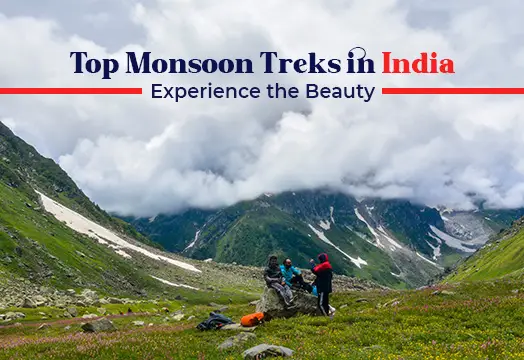
Trekking in Ladakh, Ladakh Treks
Experience the raw beauty of Ladakh with Trek The Himalayas through exhilarating treks that showcase the region's majestic landscapes. Our Ladakh treks take you along remote trails, crossing high passes and exploring breathtaking vistas. Traverse through rugged terrains, ancient monasteries, and serene high-altitude lakes. Each trek offers a unique perspective on the diverse landscapes of Ladakh, from arid mountain ranges to lush valleys. As you hike through these stunning environments, you'll encounter a rich blend of natural beauty and cultural heritage. Whether you're ascending challenging passes or strolling through tranquil meadows, our expertly guided treks ensure an unforgettable adventure. Join Trek The Himalayas to immerse yourself in the grandeur of Ladakh and experience the true essence of this Himalayan gem.
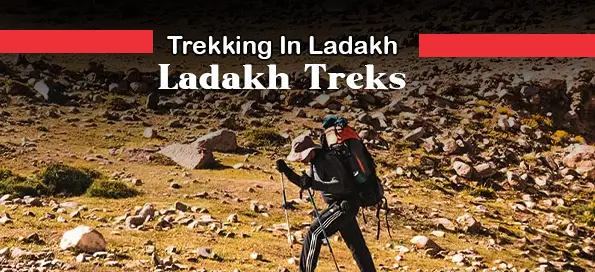
- Date and Price
Rent A Gear
Trek Articles
Quick Links
Trekking & Hiking
Mountaineering
Multi Sports
Himalayan Pilgrimage
Website Privacy
Terms & Condition
Contact Info
Get in touch with us. E-mail us Monday-Saturday (10 AM to 6 PM)
Address: Trek The Himalayas 7/2/1, Convent road, Near SBI Main Branch Dehradun-248001,Uttarakhand
Phone: 8191004846
Email: [email protected]
2024 Trek The Himalayas. All rights reserved
Markha Valley trek: How to do it independently
By Joan Torres 29 Comments Last updated on April 1, 2024
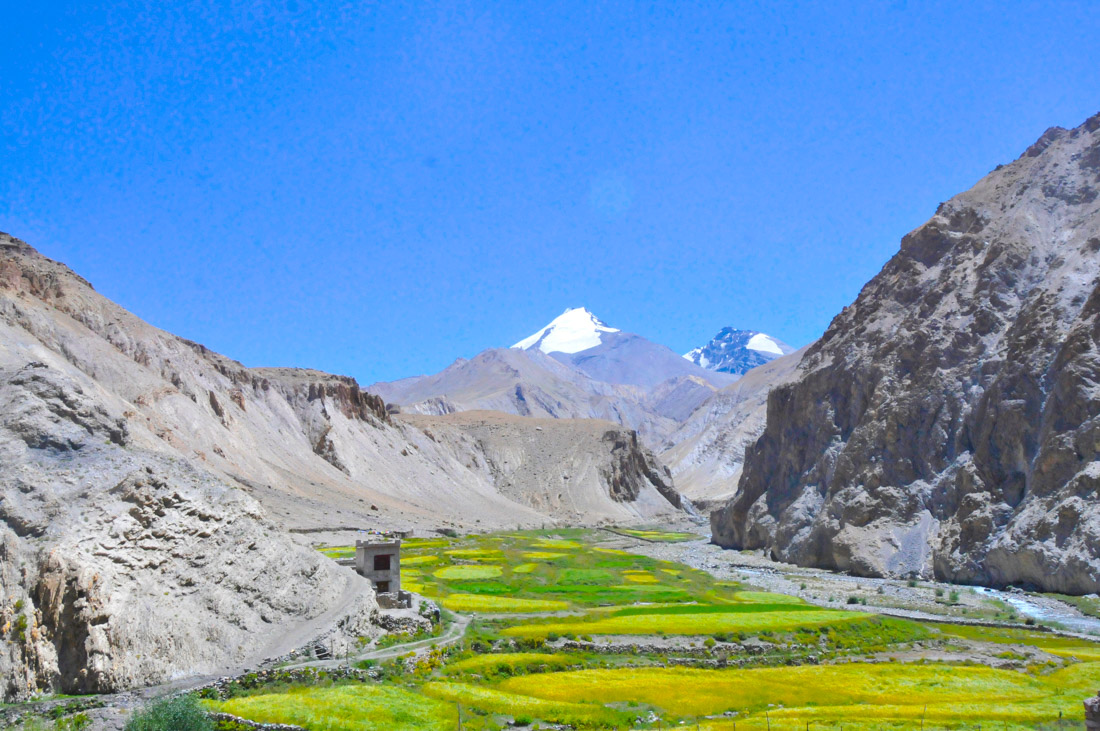
Yaks grazing on green plains at an altitude of 5,000m, white snow-covered peaks higher than 6,000m, extensive valleys surrounded by huge, rocky mountains and a strong Tibetan culture with deep roots: the Markha Valley trek is the perfect hike for those seeking both stunning Himalayan landscapes and experience real Tibetan culture .
Markha Valley is one of the most popular treks in Ladakh, but it’s still a hundred times more authentic than the popular treks offered in Nepal.
Tourism in Ladakh is still emerging and, today, you can walk around Markha for hours and yet not meet any soul apart from Tibetan shepherds.
Keep reading: A travel guide to Ladakh
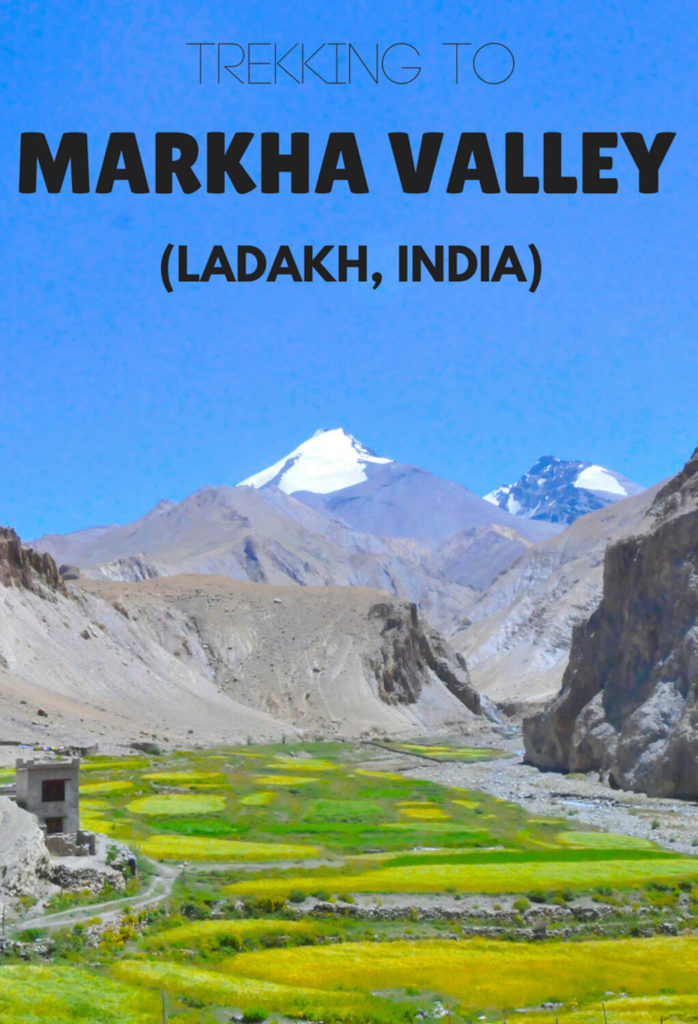
The Markha trek goes alongside a river called Markha, a tributary of the Zankskar. This river is surrounded by big, rocky mountains which give shape to the valley.
Along the valley, there are numerous Tibetan settlements that have turned into small villages, made of mud-brick houses, and Buddhist gompas .
For centuries, this region was totally isolated from modern society, until it was discovered in the 19th century.
Today, Tibetans from Markha Valley make a living from the few trekkers that pass by during the summer months.
What are you going to find in this guide?
Table of Contents
Trekking details
- How many days are needed?
- How much does the Markha trek cost?
- Do you need a guide?
Transportation: How to get there and back?
- Markha Valley trek map
- Itinerary day by day
Accommodation
- Food and water
- Packing list
Length: 96km / 50km Duration: 4-9 days When to go: June to September Highest point: 5,200m Lowest point: 3,200m Difficulty: Medium (experienced beginners)
How many days are needed to complete the Markha Valley hike?
You need a minimum of 4 days and a maximum of 9 , depending on where you start from:
Spitok – Starting from Spitok involves walking for between 6 and 9 days. During the first 2-3 days (40km), you walk through rocky areas until you cross Ganda La pass, at 4,970m. From there, you start descending until you get into the actual Markha river.
Chilling – This place is located on the Markha river itself, which means that you skip the first 2-3 days needed to get there. From Chilling, trekkers take between 4 and 6 days to complete the trail. That’s the option I chose.
Read: A beginner’s guide to trekking in Kyrgyzstan

Do you need a guide to complete the Markha Valley trek in Ladakh?
No, you don’t need a guide at all. You can do it independently without any problem. Let me tell you why:
The key is to follow the horse shit – It seems like a joke but, actually, there is plenty of horse shit along the trail, which will tell you the route to follow. Locals use these animals as a way of transportation when moving between villages.
Shepherds and local Tibetans – If animal manure disorientates you, don’t worry because, along the way, you will meet loads of shepherds, with their herd and their horses, who you can ask for directions.
Tibetan villages – Additionally, you will encounter villages every 2-4 hours, where you can also ask whether you are going in the right direction or not.
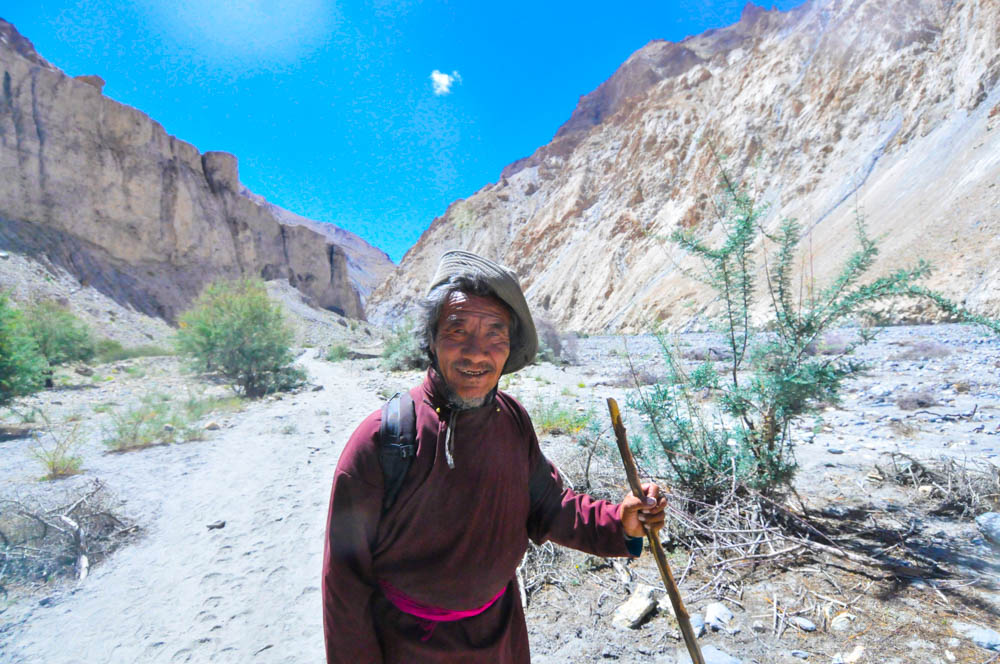
Markha Valley trek cost: Price with guide vs price by yourself
Price with guide.
I asked several trekking agencies in Leh and, as an average, this would be the price for one person. If you were with more people, it would decrease slightly, obviously:
4 days x 4,000INR per day = 16,000INR (240USD)
It includes:
A guide Round trip transportation Accommodation in either homestay or tent 3 meals a day
Price without a guide
Transportation from Leh to Chilling – A taxi costs around 2,800INR (43USD). If you don’t have anyone to share it with, I suggest you find a local who can you take there by motorbike. I paid 1,500INR (23USD).
Accommodation and food – Both homestay and tents cost 1,200INR (16.50USD), including dinner, breakfast and a picnic lunch box.
Transportation back to Leh – Taxis from Shang Sumdo (the ending point) to Leh cost 2,500INR (40USD). However, occasionally, early in the morning, you can find local transportation. I paid 500INR (8USD).
Total Cost = 1,500INR + 4 days x 1,200INR + 500 = 6,300INR (87USD)

From Leh to Chilling
Chilling is located 65km from Leh and it takes around 1 hour and 20 minutes to reach it. Taxis can easily be booked for 2,800INR ($43).
If you can’t find anyone to share it with, unofficially, you can find a motorbike taxi. How? Just ask at the different agencies.
Most of them will tell you that they don’t offer this service but keep asking until you find one. I paid 1,500INR ($23).
From Shang Sumdo to Leh
Shang Sumdo is the ending point of the Markha Valley trek and the first village which vehicles can reach. There are taxis expecting to take you to Leh for 2,500INR ($43).
Once again, if you are just by yourself, you can either wait for other trekkers to come or go back to Leh by public transportation.
Occasionally, there are local taxis leaving at 6am. You just need to be lucky. Ask anybody around for this information.
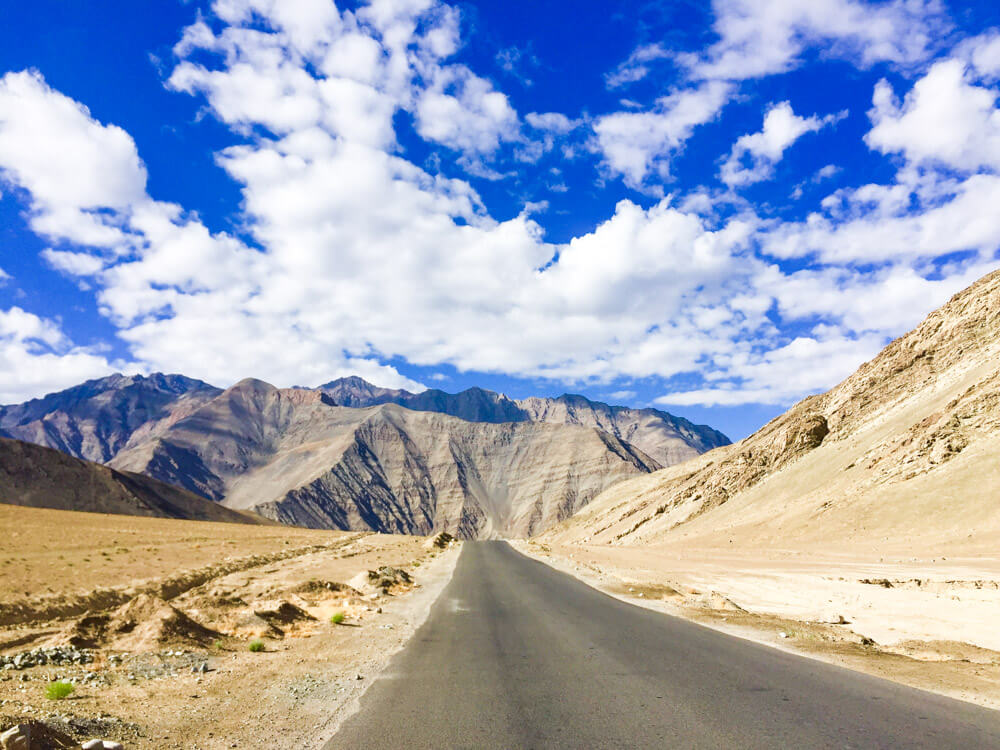
Markha Valley trek map (Ladakh)
Markha Valley trek itinerary: Day by day route
Please note that the following day by day itinerary starts from Chilling, which is the one I followed.
Day 1: Chilling – Sara
Length: 19km Duration: 8hr Highest point: 3,710m Lowest point: 3,200m
On the first day, the tough part is only during the first 5km, where you need to climb until you reach the Markha Valley itself. Afterwards, it becomes completely flat.
You’ll pass some villages, the biggest one being Skyu , where you can get a cooked meal.
The river flows through a valley which becomes greener as you keep going, but the aggressive surrounding mountains are brownish and arid.
Sara is a village comprised of just a few houses where you can find a few homestay options. However, I didn’t sleep there, but in a beautiful campsite located just a few kilometers before. It was set up on a green plain, the perfect spot to spend the night, chill out and meet other trekkers.

Day 2: Sara – Markha
Length: 8km Duration: 4hr Highest point: 3,850m Lowest point: 3,710m
This is the shortest, flattest and most relaxing part of the whole hike. The landscape is pretty similar to that of the previous day, but the mountains are sharper.
Honestly, you could easily continue walking to a further village, but Markha is sort of a special place, worth spending half a day in.
It’s the capital of the valley, hence the village with more things to do and see, from a couple of Buddhist gompas , to peasants working in the fields, playing with children or admiring the landscape.
By the way, don’t expect Markha to be a metropolis, as it is composed of no more than 20 houses spread around a big area.
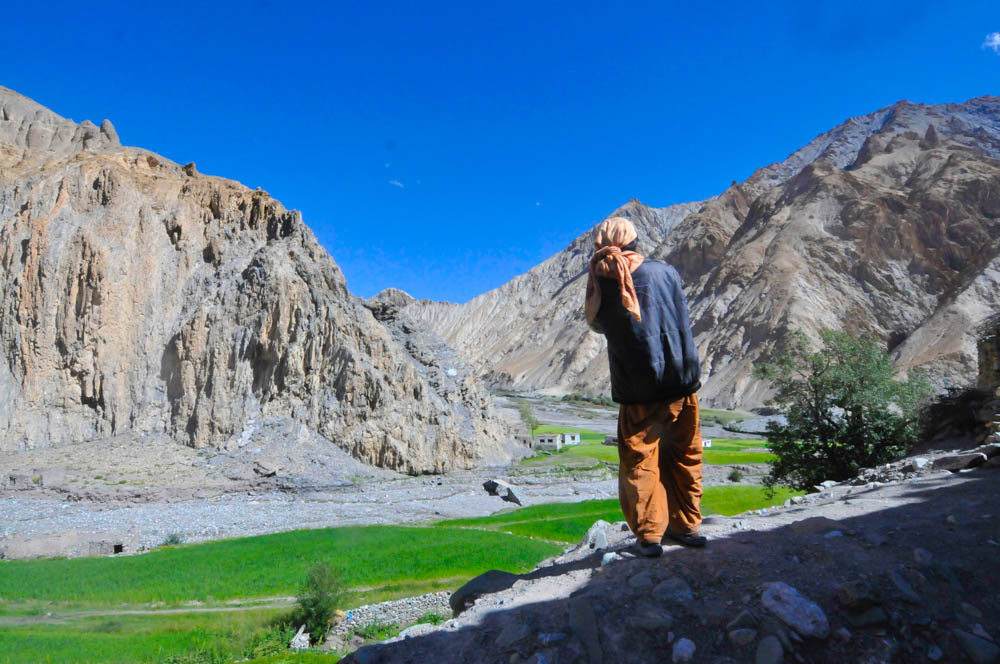
Day 3: Markha – Thachungtse
Length: 12.5km Duration: 6hr Highest point: 4,300m Lowest point: 3,850m
On the third day, things start to become really interesting. Just a few hours after Markha, you can make out Kang Yaze peak, a mountain 6,150m.
If you are lucky, you can also spot some Himalayan deer. You need to keep following the valley until Hankar , situated at the half-way point, and where you can also get a warm meal (or spend the night if you like).
When you leave Hankar behind, you need to get off the valley by turning left at some point. Don’t worry, you can’t miss it.
From there, the trail becomes tougher than ever. You will have to ascend 500m in just a few kilometers before reaching Thachungste .
The views are superb, especially because you are getting closer and closer to Kang Yaze.
Thachungste is a camping site at above 4,300 meters, placed just next to a mighty river and where hundreds of strange, tiny rabbits wander all over the place.
Day 4: Thachungste – Nimaling – Shang Sumdo
Length: 20km Duration: 11hr Highest point: 5,200m Lowest point: 3,810m
The toughest part of the whole trek but, at the same time, the most rewarding. Most hikers split this stage into two and spend one night in Nimaling . I decided to do it in one day. It depends on you.
The first stretch from Thachungste to Nimaling is breathtaking.
You ascend from 4,300m to 4,800m in just 9km, passing herds of yaks and hairy Himalayan horses and very authentic Tibetan shepherds.
The landscape has loads of contrasts and, at one point, you can look to your left and see a green field with Kang Yaze in the background and to the right, gray and purple rocky mountains.
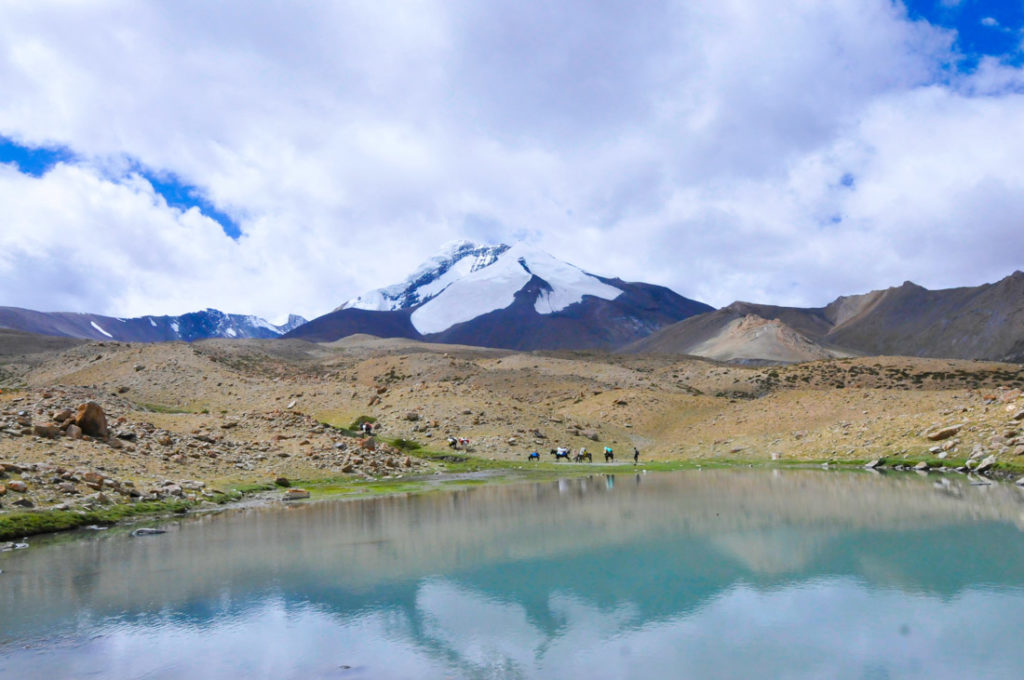
Nimaling is located in a huge green plain, full of yaks. There’s quite a big campsite set up. At a normal pace, you might reach Nimaling in 3hr. You can either spend the night here or continue walking.
As soon as you leave the plains of Nimaling, you start directly going up to Gongmaru La pass , located at 5,200m and the highest point of the trek.
The ascent is hard but the views you get both right and left are impressive. When you finally reach the top, recover your breath, rest for an hour and enjoy the views.
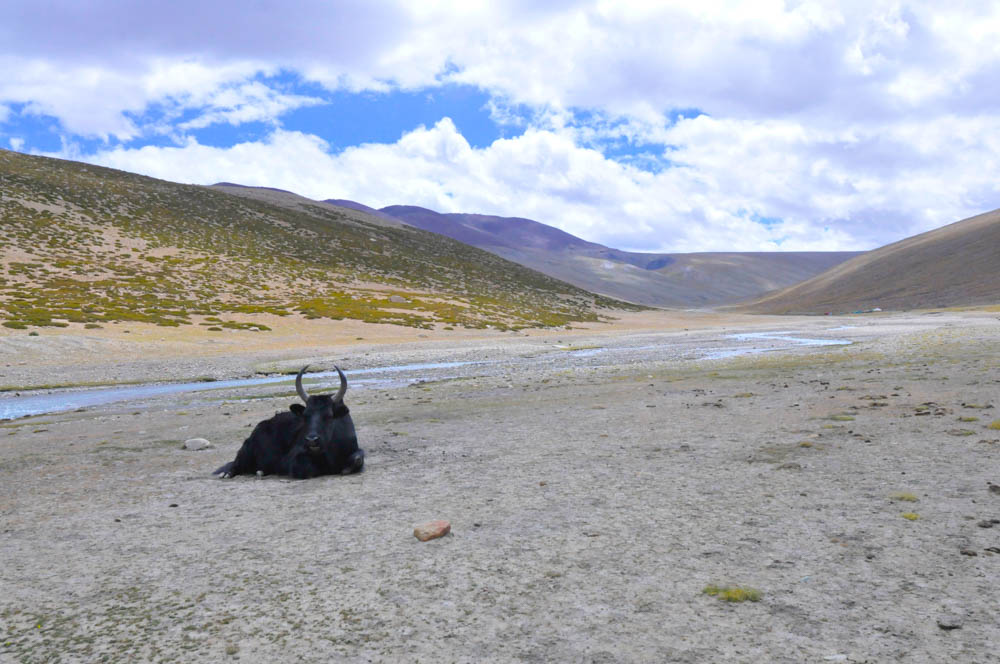
After the pass, you just need to go down. The way is extremely steep and you have to descend 1,500m in just 4hr. At the end of the trail, you get to a river which flows through a valley.
Follow it and, after 4hr, you should reach the end point, Shang Sumdo .
The trail is a bit confusing since sometimes, the way is blocked and you need to go over the valley but then go down again.
Once you are in Shang Sumdo, have a rest over a couple of beers. From here, you can go to Leh by car.
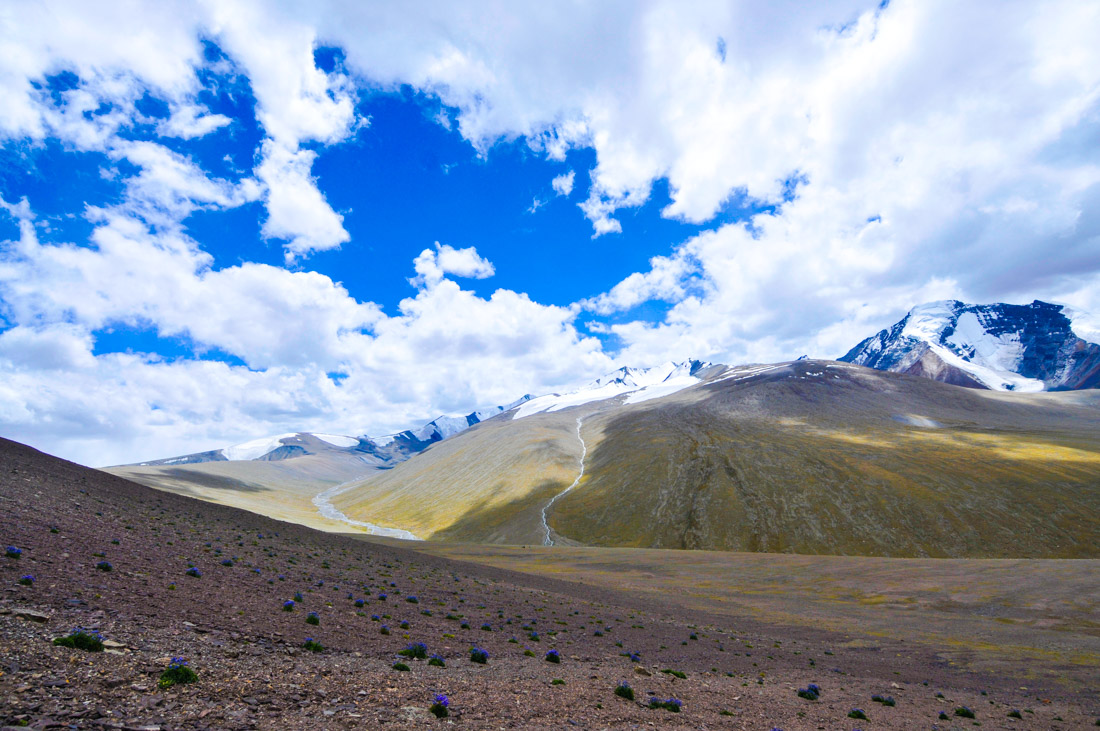
Unless you are bringing your own tent, there are two types of accommodation:
Homestays – Most Tibetans have a spare room with 3 to 4 mattresses on the floor for trekkers. They charge you 1,000INR ($15) including dinner, breakfast, a picnic lunch box and all the tea and cookies you want. If you are lucky, the family will invite you to sit with them for dinner. Some of them will make the effort and try to start a conversation, even though their English is not good.
Camping sites – Along the route, Tibetans have set up exclusive campsites for trekkers. The price is also 1,000 rupees per tent, including meals as well. Tents are well-prepared and have a thick mattress and blankets.

Food, water, and showers
Food – As you would expect, food is, definitely, not the highlight of this trek. In homestays, they will always serve you dal (lentils) and rice and chapati (flat Indian bread) with jam and butter for breakfast. The picnic lunch box consists of a slice of bread, some cheese, a potato and one piece of fruit. If you are very lucky, you might get some eggs for breakfast. In the villages, you can get some extra dishes, such as instant noodles or skyu , a traditional Tibetan dish consisting of stew with flour balls.
Water – Bottled water is not sold across Markha Valley, but they drink from the river. The water you buy has previously been boiled and filtered by the locals. It costs 15INR (23¢) per liter. Bring your own bottle.
Shower – There are no showers. If you want to wash, you should go to the river. Furthermore, the few toilets you find are holes on the ground. Personally, I prefer going into the bushes.
Markha Valley trek: Packing List
Travel Insurance – In the mountains, accidents do happen. Remember to always have insurance. I strongly recommend buying World Nomads .
A backpacking tent for high altitude mountains – If you don’t want to pay for accommodation, bringing your own tent, will make things much cheaper. I recommend a Freelite 2 , which is the one I bought in 2017.
A warm sleeping bag – At high altitudes, nights can be freezing. I recommend a Kelty Cosmic 20º , which I bought in 2017, as well.
A camping stove – To save yourself from buying non-tasty meals, bring your own cooking equipment and stock up on supplies in Leh. If I was you, I would get a multi-fuel stove, which works with any kind of flammable liquid, such as white gas, pure alcohol, gasoline, and diesel. I recommend you buy the MSR XGK EK multi-fuel stove .
For purifying water – Supposedly, the water sold by the locals is boiled but, if you are not entirely sure about it or you just don’t want to pay for mountain water, you should always bring purifying tablets or a Steripen .
Warm clothes – From proper hiking pants to a warm jacket and thick socks. As I said before, nights can be freezing at above 4,000 meters.
A Kindle – If you don’t have a Kindle, perhaps, it’s time to buy one. At night, you will have nothing to do but read and you know that books are heavy to carry.
Solar protection – As you keep on ascending, you also get closer to the sun, hence its rays become more lethal. Please note that in August, the sun is extremely strong.
A hat or a cap – The sun is extremely harsh, especially in summer.
Diamox – High altitude sickness is very common among travelers who go to Ladakh. Why? Because most of them reach Leh by plane, which is already at 3,500m. The altitude change is too drastic and some hikers don’t have enough time to acclimatize. Before going to Markha Valley, I would spare 3 or 4 days resting in Leh. For the trek, bring Diamox with you, which is a medicine that helps to fight against altitude sickness.
Keep reading:
The ultimate guide to travel to Ladakh Top 100 outdoor blogs
If you like my website and found this post useful, remember that, if you book any service through any of my links, I will get a small commission at no extra cost to you. These earnings help me maintain and keep Against the Compass going! Thanks 🙂

29 comments
How about that dude living solo at 4500 meters?
I always appreciate folks who live alone in remote outposts. They have mastered this fear of being alone, and lonely, as we are social creatures who crave connection, at least after a few weeks or months.
I lived 3 hours away from civilization in the jungle a few years ago. Nothing like these remote spots you write of up top, but still, the 1 dude who lived down the road was someone I admired. He spent most of his life in the jungle with animals, versus in town with humans, save 1 day a week. Impressive.
Brilliant pictures Joan.
Hey! Just some news one year later about that Valley, I did the trek the last week of September. Some more info for readers coming till that comment part 🙂 Pros: we were no more than 3-5 foreigners sleeping in the main villages(sky, Markha, nyimaling camp), perfect for talking to locals. No organise group anymore! Cons: it’s getting cold (-5 nyimaling) and camps are closing About itinerary, I skipped a day too, but by walking from Markha to nyimaling in a day(7.5hrs) witch is hard but doable Something else, if you have time, don’t skip the part between zinchen and skyu, the first pass is incredible and the way down to skyu too! Hoped I helped some.
Hi Leroy, thanks for your tips man! Yes, it was definitely useful. Good to know that they are starting to close camps the last week of September. And yes, perhaps I should encourage people to do the first pass 🙂 I hope you enjoyed man!
Just reading through these lines really have me excited about my upcoming trip to Leh! Is there a specific guide/company you would recommend? Is it better to book in advance or only once on site? Thanks so much for your help!
Hi Val, I went there independently so can’t recommend a specific tour company. However, in order to know the prices which are shown in this article, I asked several agencies and all of them were asking for the same price, more or less. You MUST book it once you are in Leh. You will save 50% of your money and don’t worry, because there are dozens of different trekking agencies. Go there and, on the first or second day, just ask at 4 or 5 agencies and choose your favourite one :9 Cheers,
Hi, thank you for the great summary of the trek! I am going to Leh during my world travel and therefor I wanted to ask if you brought all your equipment from home or did you buy it in Leh (I heard you can get everything there for a fair price). I would be travelling in warm regions before going there, so I am not that much into carrying everything with me for months… Thank you, Mario
Hi Mario, yes, you can buy it in Leh but the quality won’t be as good. For example, you can buy a super warm sleeping bag which could keep you warm at -8ºC but it is going to weight 5kg. It’s always better to buy the brands you like in your home country. Cheers!
Thank you for this great description! We are gonna do this trek in June. We won’t bring a tent en would like to spend the nights at the homestays as you described. Do we also need a warm sleeping bag over there? Or do they have enough blankets? I would like to go with a light down sleeping bag and a fleece liner. Do you think that will be okay?
Thank you so much! Loore
Hey Loore, they have extremely warm blankets, no need to worry about that 😉
We are also doing this trek in June! Do you have an itinerary yet? I am so excited. Can’t wait till June 🙂
Hi Teresa, in June we will be around the Caucasus. You meant my itinerary, right? Otherwise, the trekking itinerary in on the post, if that is what you were asking 😉
Hello. This has been a very interesting and informative read. Can this trek be joined at Chilling through the Hemis National Park?
I am not sure to be honest
Hi Really nice information about trek. I just want to ask if your tips and advice are valid for longer version of Markha Valley Trek (7-8 days from Spituk). I would like to walk a longer option sleeping in homestays. As I understand no GPS needed. Just a map. Thanks. Darius
Hey Darius, yes, they definitely are valid for the longer route
Hey! Thanks for the detailed info. Just some question about what to bring and where to sleep. I plan to do the Markha valley independently in early June but in reverse to go up to Stok at the end. Are home stays comfortable or should I bring a lightweight mattress? (I saw in another comment that warm blankets were no problem). And I don’t need to bring a tent right?
Als for the food should I bring a stove? From what I understood the food there is not amazing. Cheers Kevin
Hi Kevin, there are homestays and campsites along the way, so you should be fine. As per the food, well, it is very simple food, like daal and rice mainly, but I don’t think you are going to cook much better with a simple camping stove
My gf and I are planning a trip to Leh to hike Ladakh in july. We are vers confused abort the weather as we read a lot of different infomation and advice when and when not to travel. How will the weather usually be in july and can you recommend the Markha Valley in this month?
Hi John, July is the best month of the year to trek the Markha Valley
Hello, From my research, Mid-June to september are treakking seasons in Leh. Can you do the Markha Valley trek in and around last week of August ? Also about the guide availability, can you get a guide for just one indiviual ? I tried asking around a few agencies over email and they were only doing “group tours”, not that I have a problem with that.
Hi Jimmy, if you look for an agency once you are in Leh, you’ll be able to find them. End of August is very doable.
Hi, we’re going to Ladakh at the end of August – do you think, there will be enough capacity in the homestays or in the campsites to stay , even though it will be the tourist season? Because I think Ladakh’s treks have become more popular these days… And one more question – is it necessary to bring our own mosquito net? Thanks 🙂
Hi, there should be enough capacity. I don’t think they would allow someone sleep outside, if that person didn’t have a tent. As per mosquito net, they didn’t provide you with one, so you can bring one along
Unfortunately the packing list is a bunch of hogwash.
The great thing about this trek is, you dont need a tent or a stove or food. You only need a thick sleeping bag in peak season, otherwise everywhere including Nimaling will have enough blankets.
I was mislead by this list and envied 95% of other trekkers who had much lighter load. At 5000m every kg makes a difference.
The packing list clearly states that if you don’t want to pay for accommodation, bringing your own tent will make things much cheaper and, to save yourself from buying non-tasty meals, bring your own cooking equipment and stock up on supplies in Leh.
Never said that those items were a must, so the fault is yours.
Hey Joan, thanks a lot for the great description! My gf and I are planning to do the trek in June. I am wondering, do you need to reserve homestays (can you even?), or do just show up? You said in a previous reply that you think capacity would not be an issue, do you think that’s true in late June? Many thanks 🙂
UPDATE JUNE 2023
The small stream in the valley from Nimaling to Chogdo is overflowing with melting water at the moment. As there are 20+ river crossings it is extremely dangerous to descend that way. If you can avoid this part and have time to return the way you came up, do so!
After a really nice and easy trek up to Nimaling, we attempted to climb down from Nimaling to Chogdo on the 25th of June via the Konmaru La East Pass. The first bit after the pass, was steep and a little sketchy but well manageable with some experience and sturdy footwear. Unfortunately after that we were facing massive amounts of water flowing down the valley to Chogdo. After crossing the river twice (slipping and falling, almost losing our backpacks and hiking poles) we decided to wait until the next morning as water levels were expected to go down during the night. Which means we got stuck halfway on the mountain at 4500 meters and ended up staying the night emergency bivouacing (sharing 3 sleeping bags and one emergency bivouac bag between the 7 of us). We were lucky to be a group of (semi-)experienced trekkers who could make it down safely the next morning starting at around 4.30 am.
Moreover, travel agencies and locals in the camp in Nimaling do not seem to care or do not know any better, so do not expect warning from their side. Also there is no reception on the descend and even satellite phones do not work as they’re blocked in Ladakh. Stay alert and safe!
You keep refering to them as Tibetans. They are not Tibetans, they are Ladakhi people from Ladakh, India. Culturally though they are similar to Tibetans.
Hola, Tenemos solo 4 día spara hacer el trekking. ¿Ves viable lo siguiente? Dia 0 – Llegada a Leh Day 1 – 18th of August: Coche Leh – Skiu. Trek Skiu – Markha Day 2 – 19th of August: Markha – Hankar Day 3 – 20th of August: Hankar – Nimaling Day 4 – 21st of August: Nimaling – Kongmaru La – Chokdo
Desde Chokdo se puede ir en coche hasta Leh, verdad? ¿Nos recomiendas alguna agencia o guía? Muchas gracias!
Leave a Comment Cancel reply
Your email address will not be published. Required fields are marked *
Notify me when new comments are added.
Join our Expeditions
From Syria to Iraq in Pakistan, Against the Compass is finally running expeditions to the most epic and off-the-beaten-track countries.
We have scheduled expeditions for every month of the year.
Latest posts
- How to travel to Eritrea in 2024
- How to travel to Svalbard in 2024
- How to travel to Afghanistan during Taliban rule (2024)
- How to Travel to Libya in 2024
- Backpacking Venezuela Travel Guide (2024)
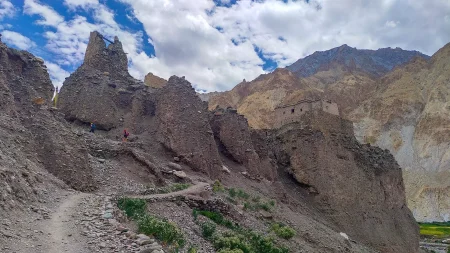
Markha Valley Trek
Revisiting the ancient silk route with a world lost in time.
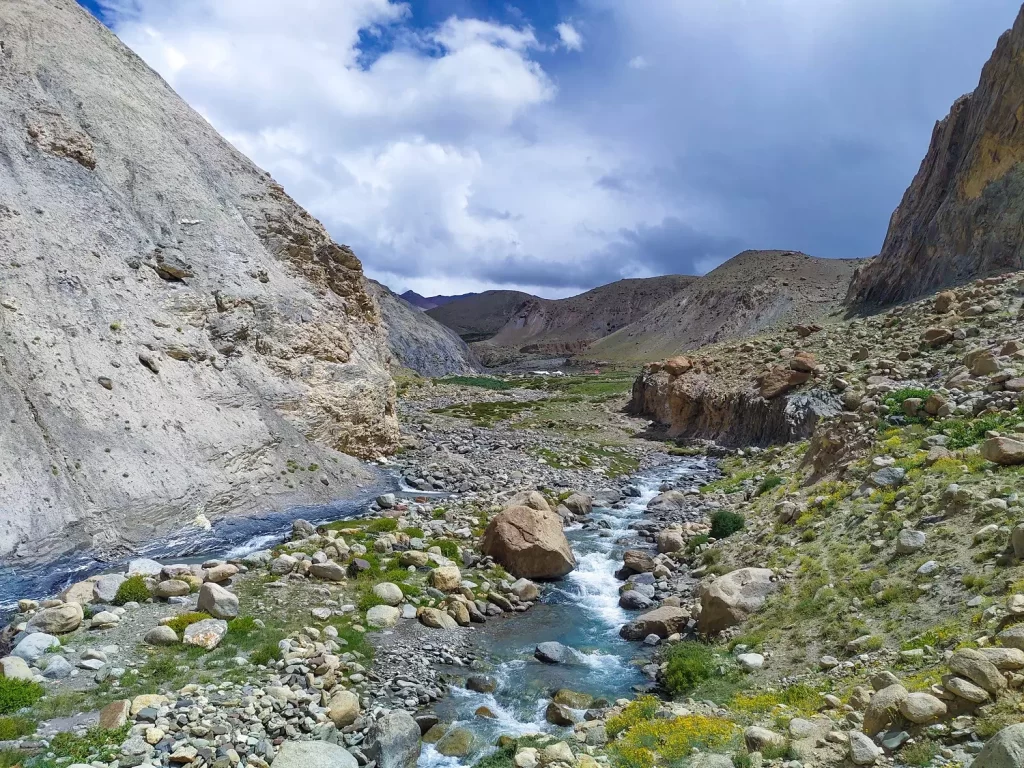
How difficult is the Markha Valley trek?
How is the weather at markha valley trek.
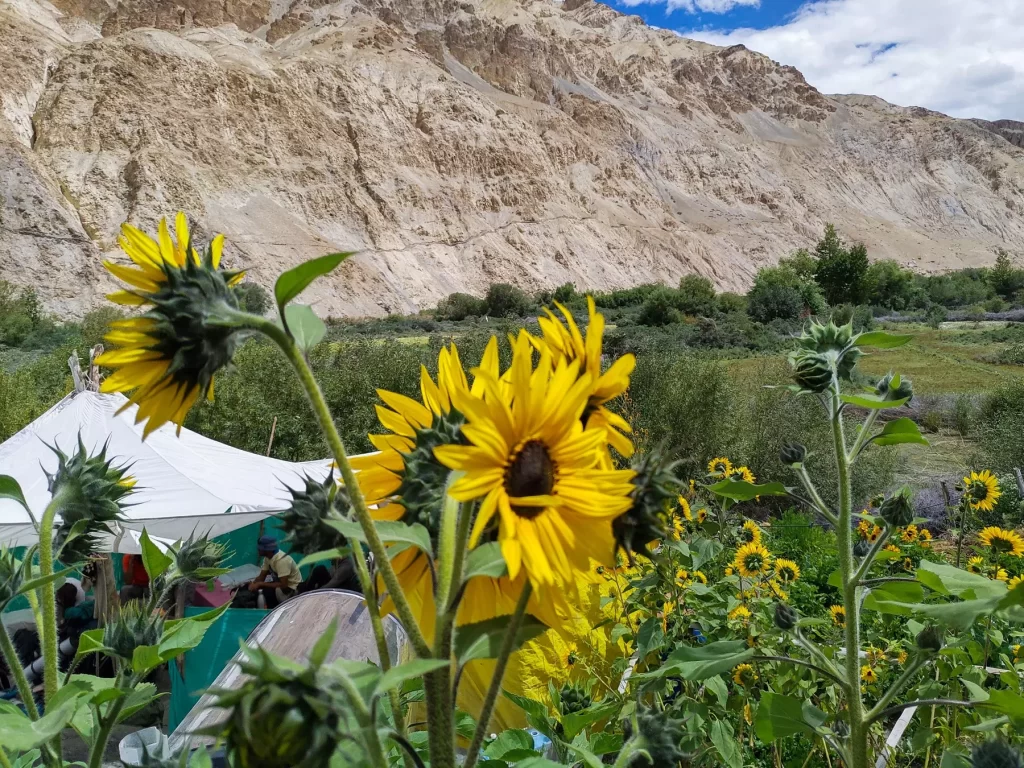
What are the top attractions of the Markha Valley trek?
- Every trek leader at Himalaya Shelter is not only passionate about mountains but also highly qualified. They have done intensive training such as Basic Mountaineering Course, Advanced Mountaineering Course, Search and Rescue Course, and First Aid Course. This wide range of training prepares them with the required knowledge and experience to handle any situations that may come up while trekking.
- Our trek leaders have been to the trails multiple times before and know the local landscapes, weather conditions, and people well. You can trust that you are in capable hands with leaders who are not only passionate about the mountains but also equipped with the necessary expertise.
- The kit we provide consists of all the necessary medical supplies and equipment for altitude trekking. From emergency first aid training to dealing with altitude-related symptoms and so much more, we are ready to respond quickly to different medical situations.
- We know the difficulties of high altitude and to avoid any risks, we carry oxygen cylinders in every trek. This equipment proves to be a lifesaver in cases of altitude sickness or emergencies, giving instant relief to trekkers.
- Our commitment to keeping group sizes small, with a maximum of 12 trekkers, is rooted in the belief that this approach enhances the overall safety and well-being of every participant. Thus making our trek leaders experts who provide individual attention to each trekker and ensure incident prevention and safety protocols are followed thereby creating a more engaging and enjoyable trekking experience.
- Himalaya Shelter is known for its high-quality trekking equipment and gear. From tents to safety harnesses, we make sure that all the equipment is of international safety standards and therefore reduce potential risks through the trek.
Markha Valley Trek Itinerary
Day 1 arrival in leh, rest & acclimatization.
- Location – Leh
- Altitude – 3,500 meters | 11,480 feet
- Accommodation – The Bodhi Tree
After arrival at Leh Airport, our cab will pick you up and transfer you to the hotel. You will be spending the night at The Bodhi Tree, one of the best rated accommodation in Leh.
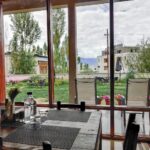
Relax and rejuvenate at the Hotel. Tomorrow we set out to explore near Leh.
Day 2 Acclimatization Day - Explore near Leh
After a sumptuous breakfast at the hotel restaurant, we set out to explore in and around Leh.
We start with the Leh Monastery , which is an age old monument, also known as as the Lhachen Palkhar . King Sengge Namgyal built the Leh Palace during the 16th Century and it was completed by the 17th century.
The facades of the Leh palace resemble that of the Potala Palace in Lhasa.
In the evening we can visit the Leh Market and drive to Shanti Stupa for a vivid sunset.

Dine in a local restaurant with some local chamomile tea and a variety of local cuisine.
Day 3 Drive from Leh to Chilling, drive for 3 hours; Trek from Chilling to Skiu in 4-5 hours
- Location – Skiu
- Altitude – 3,400 meters | 11,150 feet
- Accommodation – Homestay
- Trek – 9 KM
- Drive – 65 KM
The day starts with a drive from Leh, early in the morning, along the Leh – Srinagar highway which runs parallel to Indus river. After 35 KM on this well paved beautiful road, we arrive at the confluence of Indus and Zanskar rivers , where we take a discourse towards south, parallel to river Zanskar, which now runs right along the road, and will continue to, until we arrive at Chilling. From chilling we are to cross the river, by taking the recently constructed bridge. The route ahead is an unpaved road, running now along the Markha river. Having already come across 3 different rivers, it sure is a delight.
We arrive at Skiu in 3 hours . After initial climb through hairpins, the route is very gradual, henceforth. Halfway we arrive at Village Kaya, and Skiu is another 3 KM up ahead. Skiu is a beautiful village tucked amidst tall mountains, with options for Homestay, as well as camping, but the recently constructed motorable road has provided the option to trek Further up to Sara, a hamlet, as if an Oasis in a desert. We rest and relish a warm meal, preferably a dish that goes by the name of this village, i.e. “Skiu”.
Day 4 Trek from Skiu to Sara in 4-5 hours
- Location – Sara
- Trek – 11 KM
After breakfast, we start our trekking journey to Sara, which is around 11 KM ahead. We continue along this well marked trail running parallel to the river Markha. Halfway along the route we come across a Sole Tea Shop, which is women run . You can rest here, enjoy a cup of Tea or Coffee, but our favorite happened to be the fresh apricot juice which they happen to serve, although in limited quantities. A stream cuts across the trail here, which can be used to refill your water bottles. The trail offers practically no shade except slightly ahead of the Tea Shop, where a short section of young trees render much need cool to the warm environment. To supplement yourself with water continuously is very important.
After around 3 KM we come across a bridge and cross over to the other side of the river, into a small forest patch, before the trail clears up again. The route is straight ahead along the river with only mild ascent all the way up the hamlet of Sara. The Hamlet will only appear once we are very close to the settlement, less than half a KM, where a hump in the landscape obstructs the view ahead. Once atop the feature, which is lined with a Stupa and prayer flags, we can see the beautiful settlement with 3-4 houses which all offer the option for Homestay, as we as camping. Green Fields, blossoming trees surrounding these houses are in stark contrast to the landscape all around.
Day 5 Sara to Markha village trek in 4-5 hours
- Location – Markha
- Altitude – 3,700 meters | 12,140 feet
- Trek – 10 KM
The trail from Sara to Markha is again a gradual one, with no steep ascent and can be easily covered in 3-4 hours at a slow pace. After less than 2 KM from Sara we cross a bridge to our left which takes us to the true right of the river (i.e. river is now flowing on our right hand side).
Slightly further up we come across fields alongside a small village settlement, against backdrop of a steep mountain face. We continue along the trail, which slightly ascends to a higher open ground with a Stupa and Prayer stones (Mani stones), carved intricately. Take due note that you always cross these religious marking from the left (the stupa or prayer stones being on your right hand side). We quickly go downhill near the river and cross a small stream over a bridge of wooden logs.
Almost 2 KM prior to Markha village we again cross the river to our right with two bridges, one of which may be broken and will need some effort to traverse. With 1 more KM to go, we arrive at a Tea shop & Homestay with sunflowers blooming in their vicinity, offering a splendid sight with a stark contrast. A few more homestays and a campground are scattered ahead along the route, which hints at the proximity of Markha village. The last few hundered meters stretch to the village is a steep climb, which concludes in the arrival at the Monastery, followed by the village with its houses spread across the lush fields. We can spend some time at the Monastery before we continue inwards. The village has a vivid historic past and unique culture, and the day can be spent exploring these.
Day 6 Markha to Hankar Village trek in 6 hours
- Location – Hankar
- Altitude – 4,000 meters | 13,120 feet
The trek from Markha village to Hankar goes through a Monastery – the Tacha Gompa and a small settlement called Umlung. There are very few houses here with a couple of tea houses. You will see a large white canvas tent from far away as you approach Umlung.
The Tacha Gompa is inhabited by a sole Buddhist monk, who resides in the Gompa situated atop a steep cliff. A very steep staircase leads to the monastery situated a few hundred feet high above the valley below.
The last stretch to the village Hankar requires crossing a couple of more tea houses and then climbing up a steep section of trail that cuts through a cliff. As we reach the top we are welcomed by panoramic views of the Hankar village and its fields to the left, as well as a millennia old fort remains on a mountain top to the right.
Day 7 Hankar to Nimaling alpine ground trek in 4-5 hours
- Location – Nimaling
- Altitude – 4,700 meters | 15,420 feet
- Accommodation – Camping
Day 8 Nimaling to Kongmaru La (5,250 m) and descend to Chogdo in 8-9 hours; drive to Leh in 2-3 hours
- Location – Chogdo, drive to Leh
- Altitude – 5,250 meters | 17,200 feet, descend to 3,500 meters | 11,480 feet
- Accommodation – The Bodhi Tree, Leh
- Trek – 16 KM
- Drive – 51 KM
Day 9 Checkout from hotel in Leh
After breakfast you may checkout from Hotel to either return from Leh or you may extend your travel for a guided/unguided tour of Ladakh including visiting places such as Khardunga La, Pangong Tso, Tso Moriri, Nubra Valley etc.
Day 2 How difficult is the trek & what are the challenges?
Markha valley trek images.
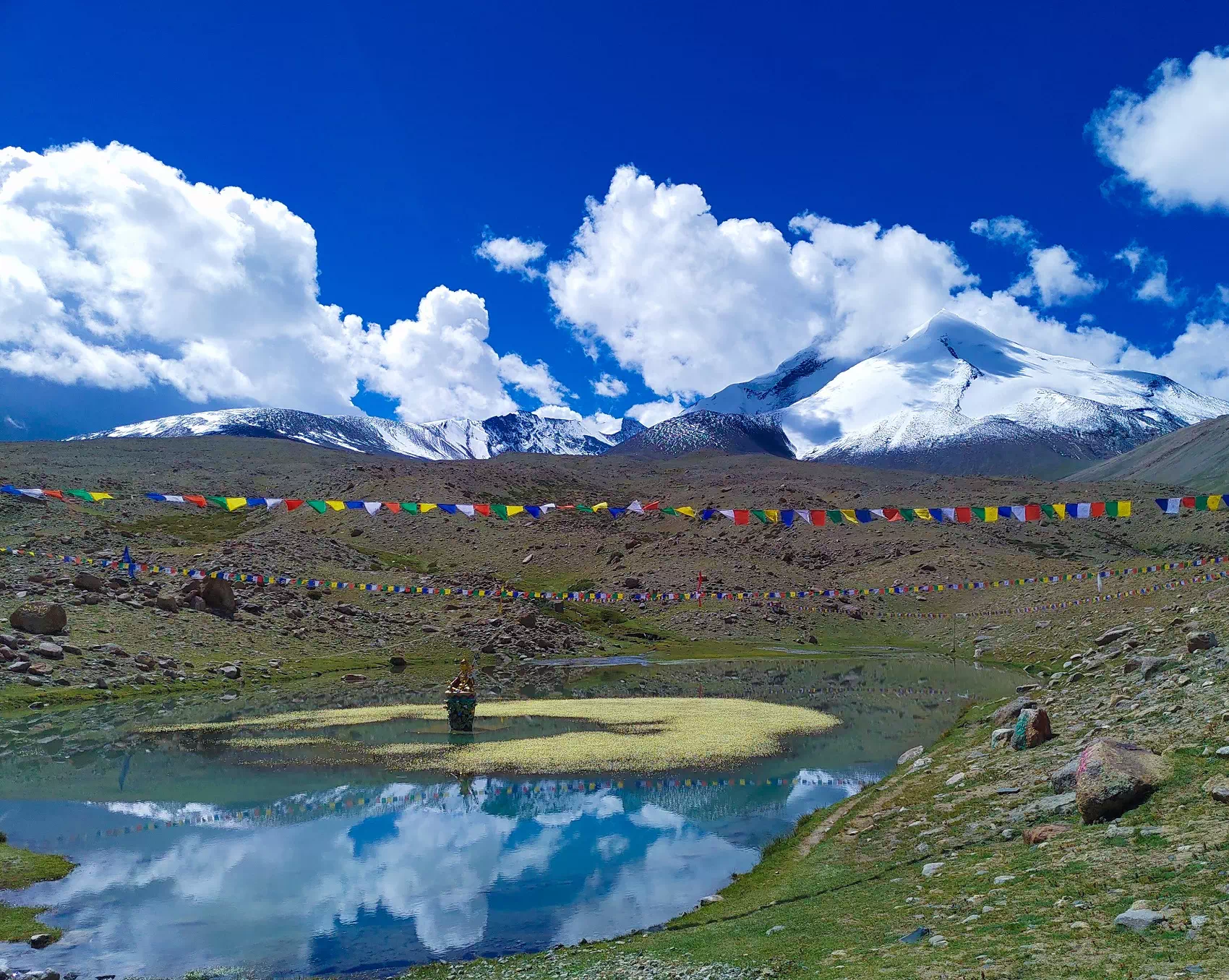
Upcoming Treks
- August 28, 2022 open
- September 11, 2022 open
- October 13, 2024 open
Frequently Asked Questions about Markha Valley Trek
What is the markha valley trek.
The Markha Valley trek is a well-known trekking route in the Ladakh region of northern India. It takes you through the stunning landscapes of the Hemis National Park, with views of snow-capped peaks, ancient monasteries, and remote villages.
How long is the Markha Valley trek?
The trek usually takes about 6 to 8 days to complete. This includes trekking, acclimatization, and rest days.
What is the best time to do the Markha Valley trek?
The best time for the Markha Valley trek is from mid-June to mid-September. During this period, the weather is relatively mild, and the trails are accessible.
Do I need a permit for the Markha Valley trek?
Yes, a permit is required for trekking in the Hemis National Park, which encompasses the Markha Valley. This permit can be obtained in Leh.
Is it necessary to hire a guide for the Markha Valley trek?
It’s not mandatory to hire a guide, but it’s highly recommended, especially if you’re not experienced in high-altitude trekking. A guide can help with navigation, and acclimatization, and provide valuable local knowledge.
What is the level of difficulty for the Markha Valley trek?
The trek is considered to be moderately challenging. Trekkers will face high altitudes, river crossings, and some steep ascents and descents. It’s important to be in good physical condition and have some prior trekking experience.
What is the highest point on the Markha Valley trek?
The highest point on the trek is the Kongmaru La Pass, which is situated at an altitude of approximately 5,100 meters (16,732 feet) above sea level.
What kind of accommodation can I expect during the trek?
Accommodation along the trekking route usually consists of homestays, guesthouses, and camping. The facilities are basic, and you’ll need to carry your own sleeping bag.
What should I pack for the Markha Valley trek?
Some essentials include warm clothing, a good quality sleeping bag, trekking shoes, a raincoat, a water bottle, a first-aid kit, and personal toiletries. It’s important to pack light but ensure you have all the necessary gear.
How do I get to the starting point of the Markha Valley trek?
The trek usually starts from a village called Spituk, which is about a 30-minute drive from Leh. You can reach Leh by air from major Indian cities like Delhi, or by road from Srinagar (in Jammu and Kashmir) or Manali (in Himachal Pradesh).
Are there any risks or challenges associated with the Markha Valley trek?
The main risks include high altitude sickness, sudden changes in weather, and rough terrain. It’s crucial to acclimatize properly, stay hydrated, and be prepared for varying weather conditions.
How to reach Leh?
The Chadar trek can only be done during the months of January till February, therefore the roads to here are blocked due to heavy snowfall. The way to reach here through the air is very convenient and Ladakh is accessible by air as well. One can easily schedule a flight to Leh Kushok Bakula Rimpochee Airport.
The cheapest way to reach from New Delhi to Leh is train to Jammu Tawi, then flight to Leh Kushok Bakula Rimpochee Airport and takes 13h 45m. The fastest way to reach from New Delhi to Leh is flight to Leh Kushok Bakula Rimpochee Airport and takes 1h 15m.
Do you think I should bring some medicines along with me while on the trek?
Yes, it’s recommended to have your personal medicines and a simple first aid kit during any trek.
What are the best places to explore in Leh-Ladakh?
Explore leh-ladakh.
Pangong Lake: Journey 160 KM from Ladakh to reach the tranquil Pangong Lake. This world-famous tourist spot offers a range of activities, from camping to boating, against a backdrop of mesmerizing natural beauty.
Nubra Valley: Nestled between the Nubra and Shyok Rivers, Nubra Valley, often called the ‘Valley of Flowers,’ captivates visitors with its scenic vistas and cultural richness. From the ancient Diskit Monastery to charming Hindu temples, there’s much to explore.
Hemis Monastery: Hemis Monastery, situated near Hemis National Park, is one of India’s most renowned Buddhist monasteries. It’s famous for the annual Hemis Festival, a five-day celebration honoring Padmasambhava. Getting to this monastery is an adventure in itself, with breathtaking scenery and thrilling pathways along Pangong.
Shanti Stupa: Perched on a Chanspa hilltop, the white Shanti Stupa features a large Buddha sculpture. Part of the Peace Pagoda Mission, it’s renowned as one of the world’s top Buddhist sites. Inaugurated by the 14th Dalai Lama, it exudes serenity and a sacred atmosphere.
Gurudwara Pathar Sahib: This revered place is associated with Guru Nanak Dev Ji. Legend has it that a demon threw a rock at the Guru while he was meditating, and the boulder with imprints of his body parts is enshrined here.
Thiksey Monastery: Perched on a hill, this beautiful monastery belongs to the Gelug sect of Tibetan Buddhism. Dating back to the 1400s, it houses small temples, Buddhist relics, and nunneries. It’s not just a place of worship but also a spiritual haven for over 500 meditating monks.
Local Markets: Leh’s local markets are a treasure trove of souvenirs. Visit the Tibetan Market in the Main Bazaar to shop for spices, handicrafts, snacks, and more.
Khardungla Pass: For a scenic mountainous escape to Nubra and Shyok Valleys, journey along the 47.2 km Khardungla Pass, perched at an elevation of 17,852 feet. Marvel at panoramic views of the Himalayas and the Karakoram Range.
What is the best time to do the trek and how is the weather?
What are the top highlights of the trek.
- Transfers from Leh city to the base-camp and return drop to Leh city - Toyota Innova
- All Meals from Day 1 Dinner to Day 9 Breakfast - Traditional Meals, Vegetarian Meals, Egg Preparations will be served Dinner on Day 2 is excluded as the same is recommended in a restaurant in Leh.
- Accommodation in Leh in The Bodhi Tree (Best Rated Accommodation in Leh - 3 Star Hotel) for 3 Nights
- Accommodations for 5 nights during trek in Tents (Nimaling) & Homestays (where possible - Skiu, Sara, Markha, Hankar)
- Certified trek leader, knowledgeable about flora, culture and history of the region
- Camping equipment as needed (Tents, Sleeping Bags, Mattresses etc)
- Trek Insurance for Medical Evacuation, Illness, Injuries with hospitalization expenses
- Your designated hotels may not reopen by the time you reach there. While we are making alternate arrangements, do understand that things may not be as “tip-top” as our designated hotels.
- The gurudwara, Hemkund Sahib may not be open. While we are trying to take permission to go to Hemkund Sahib, if it does not happen, then do understand that the pandemic has put restrictions beyond our control.
- Tips, Personal expenses during the trek, or any inclusions not shared above, and cost arising due to bad weather or due to roadblocks
- Cost arising due to unforeseen incidents like bad weather, medical evacuation, roadblocks etc
- Accommodation apart from the trek
- Personal Porter for Baggage can be arranged
- lunch box for packed lunch/breakfast. To avoid using polythenes and Aluminium foils. Keeping the Himalayas clean is our own responsibility. Reduce the use of Plastic when you are in the abode of the Sacred Himalaya
- 17-07-2021 to 23-07-2021 open
- 17-07-2021 to 23-07-2021 close
Send Request
Your query has been successfully registered. we will contact you within 24 hours., something went wrong.try after sometime..

Moderate to Difficult
Highest Altitude
June, July, Aug to Mid Sept
Markha Valley Trek
Located in the River Valley of Ladakh, the charming Tea House Trail in Markha offers a picturesque and adventurous trek through the arid, cold desert landscape of Hemis National Park. This trail features numerous river crossings, some waist-deep and reaches a height of 17,060 feet when crossing the high pass of Kongmaru La. Along the way, trekkers are treated to breathtaking views of Mt Kang Yatse (21,300 feet) and encounter stunning rocky canyons and diverse wildlife. The most enchanting aspect of this trek is the quaint villages of Markha Valley, with their humble mud houses surrounded by green fields amidst the rugged Ladakh mountains. These villages showcase Tibetan culture with traditional ornamented kitchens and Buddhist prayer flags. What sets this trek apart is the opportunity to stay in village homestays along the trail, making it one of the rare tea-house treks in India. This allows trekkers to enjoy a rewarding experience without needing camping logistics. For those with limited time in Ladakh looking for a memorable trekking experience, the Tea House Trail in Markha Valley is an ideal choice.
On the third day of your trek, you will catch sight of Kang Yatse for the first time as you make your way towards the upper Markha valley. As you ascend from Umlung, the impressive pyramid-shaped peak of Kang Yatse dominates the landscape, creating a captivating and enchanting scene. This mountain serves as a serene and majestic presence during your journey, offering stunning views from various points of the trek, until you reach the Kongmaru La pass.
Nestled in the heart of a desolate, high-altitude desert, the villages of Markha and Hankar present a breathtaking anomaly – vibrant green landscapes that thrive in an otherwise arid environment. The juxtaposition of the harsh desert mountains sheltering a verdant haven of civilization is a sight to behold. Markha stands out as one of the largest villages encountered on the trek, while Hankar embodies a more untouched, rugged beauty, adding to the diversity of Ladakh’s natural beauty.
From the summit of Kongmaru La, the breathtaking panorama unfolds as a sweet payoff for the arduous ascent. When the skies are clear, this vantage point offers a stunning introduction to the Indus Valley and the majestic Ladakh ranges. As you pivot, the towering form of Kang Yatse comes into view, standing sentinel over the landscape. The spectacle is nothing short of awe-inspiring.
The Markha Valley trek is popularly known as a ‘tea house trek,’ where travellers can expect to find lodging in parachute tents at many villages. In addition to the captivating experience of trekking through a cold, arid desert valley, participants are treated to breathtaking views of the Ladakh and Zanskar mountain ranges and the impressive peaks of Kang Yatse and Stok Kangri. The route passes through the picturesque Hemis National Park, offering a glimpse of its beauty. The trek features thrilling waist-deep river crossings along the Markha River, passes through charming Buddhist villages, and navigates rocky canyons, contributing to its distinctive appeal. With its convenient proximity to Leh, easily reachable by a short flight from most major Indian cities, the Markha Valley Trek is a compelling option for any traveller visiting Leh.
- Stay will be on a twin-sharing basis in tents
Pickup time 12 P.M from TRC Taxi Stand, Srinagar, in front of Tourism Office Building
- Inclusions & Exclusions
- Food Provided Trekup India
- Safety With Trekup India
Call Our Mountain Experts
Fix Diparture Dates
Markha valley trek videos.
Videos by experts watch these videos to prepare well for a Successful Trek

Want To Trek Like Pro?
Check out the following videos if you want to trek like a pro trekker and improve your skills. These videos contain helpful tips, tricks, and techniques to help you trek like a pro. Whether you’re a beginner or an experienced trekker, these videos can provide valuable insights to enhance your trekking experience. So, watch the videos below by Trekup India experts to take your trekking skills to the next level.
Know Everything About Acute Mountain Sickness
Acute Mountain Sickness is a medical condition that can occur when individuals travel to high altitudes, typically above 8,000 feet. It is caused by the decrease in air pressure and oxygen levels in the air as altitude increases. Symptoms of Acute Mountain Sickness may include headache, nausea, vomiting, dizziness, and difficulty sleeping. To avoid Acute Mountain Sickness, it is important to gradually adjust to high altitudes and seek medical attention if symptoms worsen. To learn more about this condition, check out the videos by Trekup India.
Day Wise Detailed Itinerary of Markha Valley Trek
Day 1: arrival in leh.
- Stay: overnight stay at the hotel,
- Meal: Lunch and Dinner
- Altitude: Leh (11,500 ft / 3500 meters.)
You will arrive in Leh from other parts of India on this day. You can travel there by flight or road. You would need to rest, as you would be coming to an altitude of 11,500 ft, which creates Acute Mountain Sickness (AMS) for some. Make sure you get enough rest at the hotel. Once you have rested enough, you can explore Leh. Also, you have network availability along with ATMs so that you can enjoy the ambience of cafes.
Day 2: Rest at Leh
- Stay: overnight stay at the homestay,
- Meal: Breakfast, Lunch and Dinner
This morning after you have had your breakfast, you can enjoy another day to acclimatize your body. You can take this day to get accustomed to the place and have a good time outdoors. You can visit the Buddhist culture by visiting Thiksey Monastery, Thiksey Gompa, and Shey Palace. Visit the famous market of Leh, Leh Bazaar, and enjoy the mesmerizing view from the Shanti Stupa. And talk to local people or fellow travellers to find out about the nearby area.
Day 3: Leh to Chilling by Road, Chilling to Skiu by Trek
- Trek Distance : Leh to Chilling by Road – 65 km, Chilling to Skiu by Trek – 9 km,
- Time Taken: Leh to Chilling by Road – approx. 3 hrs, Chilling to Skiu by Trek – approx. 5 hrs.
- Altitude: Leh (11,500 ft / 3500 meter.), Chilling (10,500 ft / 3200 meters.), Skiu (11,150 / 3400 tr.)
- Altitude difference: Leh to Chilling – 1000 ft / 300 meter.)11, Chilling to Skiu (650 ft / 200 meter.)
- Trek Grade: Leh to Chilling by road, Chilling to Skiu by trek – Gradual.
After breakfast at Leh, you will begin your journey by road; you will enjoy beautiful hills and rivers on the way. A trail leads from here on until you reach the flatlands. You must climb up until you reach another road. You will be walking along the side of the Markha River till you arrive at Skiu and through Kaya Village. The village lies between the big Rocky Mountains.
Day 4: Skiu to Markha by Trek
- Stay: overnight stay at the homestay,
- Meal: Breakfast, Lunch and Dinner
- Trek Distance: 20 km,
- Time Taken: approx. 7 hrs.
- Altitude: Skiu (11,150 ft / 3400 meter.), Markha (12,360 ft / 3767 meter.)
- Altitude gain: 1210 ft / 367 meters.
- Trek Grade: Gradual – Moderate
A delicious breakfast will kick off your day and begin your trek. Many wildlife birds are found there, which you might get to see; the trail will lead through the riverbed. You will cross the Markha River once or twice but still walk by the river. After crossing the bridge, you will reach the village of Narding, followed by a campsite called Sara. After going across another bridge, you will reach the village of Chalak, after which lies Markha Village.
Day 5: Markha to Hankar by Trek
- Trek Distance: 11 km,
- Time Taken: approx. 5 hrs.
- Altitude: Markha (12,360 ft / 3767 meters.), Hankar (13,990 ft / 4264 meter.)
- Altitude gain: 1630 ft / 497 meters.
- Trek Grade: Gradual – Moderate
Start your morning with breakfast with hot tea and enjoy Kang Yatse’s view. After walking for a few kilometres, you need to cross the river, and you will reach a small settlement, Umlung, once you have walked through the picturesque village of Hankar.
Day 6: Hankar to Nimaling by Trek
- Trek Distance: 10 km,
- Time Taken: approx. 6 hrs.
- Altitude: Hankar (13,990 ft / 4264 meters.), Nimaling (15,380 ft / 4689 meter.)
- Altitude gain: 1390 ft / 425 meters.
Upon waking up the next morning, you will be greeted with a spectacular view. The trek from Hankar will be a steep climb. After that, you will pass through a pass called Zalung Karpo La; you will then be walking through the lower trail till you arrive at the campsite of Thochuntse. From Thochuntse, the trek gradually ascends till you reach the picturesque Kang Yatse Pond. From the pond, you will go downhill till you reach Nimaling.
Day 7: Nimaling to Chokdu via Kongmaru La by Trek
- Meal: Breakfast, Lunch and Dinner
- Trek Distance: 12 km,
- Time Taken: approx. 6 hrs
- Altitude: Nimaling (15,380 ft / 4689 meters.), Kongmaru La (17,050 ft / 5197 meter.), Chokdu (12,800 ft / 3901 meter.)
- Altitude difference: Nimaling to Kongmaru La (1670 ft / 508 meters.), Kongmaru La to Chokdu (4250 ft / 1296 meter.)
Today the trek will take you to the highest point. You will be climbing a steep hill till you reach Kongmaru La Pass. From there, you will catch sight of the huge, beautiful K2 Mountain, the second-highest mountain peak in the world. The trail then gradually descends through a narrow pass till you reach Chikirmo Village. On the way, you will be mesmerized by the view of the Indus Valley and Ladakh ranges. And from there, climb down through the rocky terrain till you reach Chokdu.
Day 8: Chokdo to Shang Sumdo by Trek and Shang Sumdo to Leh by road
- Stay no stay,
- Meal: Breakfast and Lunch
- Trek Distance: Chokdo to Shang Sumdo by Trek – 5 km, Shang Sumdo to Leh by road – 50 km,
- Time Taken : Chokdo to Shang Sumdo by Trek – approx. 2 hrs, Shang Sumdo to Leh by road – approx. 2 hrs,
- Altitude: Chokdu (12,800 ft / 3901 meters.), Shang Sumdo (12,130 ft / 3697 meter.), Leh (11,500 ft / 3500 meter.)
- Altitude gain: Chokdo to Shang Sumdo (670 ft / 204 meters.), Shang Sumdo to Leh (630 ft / 197 meter.)
- Trek Grade: Chokdo to Shang Sumdo by Trek – Gradual, Shang Sumdo to Leh by road
On the last of the trek, you will be trekking from Chokdo to Shang Sumdo and walking through the riverbed, which will be an easy walk back. Upon reaching Shang Sumdo, you will go from there by road to Leh. This is your last stop from there; our Trekup India team will bid you farewell, and then from Leh, you will be on your own. You will have the option to travel from there anywhere you like.
Markha Valley Trek Route Map
We’ve prepared a comprehensive Trek Route Map for your upcoming adventure to Markha Valley Trek , which outlines the entire journey including all stops and trails. This map provides detailed information on the terrain, distance between points of interest, and estimated travel time to help ensure a safe and enjoyable trek. We’ve carefully curated the map to ensure that you have all the necessary information at your fingertips. Please take a moment to review it thoroughly, and don’t hesitate to reach out if you have any questions or concerns.
Markha Valley Trek Altitude Chart
The Trek Altitude Chart is a useful tool for Trekkers to monitor their altitude changes during their rides, allowing them to plan their routes more efficiently and track their progress over time. This Markha Valley Trek chart is beneficial for both casual and experienced Trekkers, helping them make the most out of their Trek experience.
Trek Cost Inclusions
- Stay 7 Nights of tented accommodation at individual campsites of Trekup India on sharing basis.
- Meals: Trekup India provided cooked meals during the trek starting with Dinner on Day 01 to Lunch on day 08 (Meals are simple, nutritious, and vegetarian and non-repeated meals)
- Transport: Leh to Chilling and Shang Sumdo to Leh on sharing jeeps
- Trek Insurance (Optional): Trekup India recommends that all trekkers consider getting trek insurance. This is optional, but highly recommended. Trek insurance covers unexpected events that may occur during your trek. The cost of the insurance starts from INR 210. Please read more about what is included in the coverage and why it is mandatory on treks.
- Trek Equipment: Sleeping bag, Sleeping tents, Kitchen tent, Dining tent, Toilet Tent.
- Amenities: All utensils, sleeping mattresses (Black foam mats), Crampons, and Gaiters for snow.
- Health & Safety: First Aid Box, Oxygen Cylinders, Stretchers, Oxi meters, BP Machines, health.
- Permits: Forest Permits and Camping Permission Fee
- Trek Crew: High Altitude Chef, Helpers, Trek Leader & Guides, and other support teams.
- Potters & Mules: Potters and Mules are to carry all trekking equipment, ration, and vegetables.
Trek Cost Exclusions
- GST 5% (it is Mandatory)
- Any Meals/accommodation beside the itinerary or not mentioned in the program.
- Any Bus / Airfare to/from trek start/end point
- Personal Medical expenses do carry your medication.
- Any personal services such as Laundry, phone calls, liquors, mineral water, etc.
- Any still / video camera fee
- Any Entrance fee Monuments, Monasteries, Museums, Temples – Pay directly on the spot.
- Mules or porter charges to carry private baggage (Offload Charges for bag 365 per day, per bag if paid online (at base camp 2,550). Note: Bag weight should not be more than 10 kg.
- Any emergency evacuation charges
- Any services that are not mentioned in the cost inclusion section.
What should you pack for the Markha Valley Trek
Markha Valley Trek is a high-altitude trek. The trekking gear you have to have for this particular trek differs from normal treks. Thus, read this whole segment. There is an important question that the trekker who is doing trek asks, like what all things to carry while trekking. Below, we have provided the details on everything you should take; an easy way to remember is by Head to foot or foot to head. We have prepared from Head to foot.

When trekking it's important to carry headgear to protect your head and face.
Heading out for a trek? Don’t forget to carry headgear to protect your beautiful face and head from the sun, wind, and dust! It’s an essential accessory that keeps you safe and comfortable throughout your adventurous journey. So, make sure you pack it before you step out into nature!
- Head Lamps – When trekking at night, headlamps are essential to illuminate your path while keeping your hands free. Headlamps come in different sizes and lumens, so it is essential to choose one that suits your needs.
- Hats or Cap – Caps or hats are also necessary when trekking in different weather conditions. Caps protect your head from the wind and freezing temperatures at night, while hats provide shade and protection from the sun during the day. It’s essential to ensure that your hat has a strap to prevent it from being blown away by the wind.
- Sunglasses – Sunglasses are also essential for trekking. Your sunglasses should protect your eyes from harmful UV rays and fit your face perfectly to avoid falling off while climbing, jumping, or crossing obstacles. The glass of your sunglasses should also be designed for different weather conditions to provide optimal visibility.
- Buff / Balaclava – Lastly, a buff or balaclava is a must-have to protect your mouth or neck from extreme temperatures and keep them warm. Buffs and balaclavas come in different materials, thicknesses, and designs, so it’s important to choose one that suits your needs and preferences. Depending on the weather conditions and your activities, you can wear them as neck warmers, face masks, or headbands.
When trekking in high altitudes, prepare for cold weather by wearing layers. Layering traps heat, keeps you warm, and allows you to easily adjust your clothing as temperatures fluctuate.
Layering is important for different seasons when trekking. When planning a high-altitude trek, it is important to prepare for the cold weather. Wearing layers is the best approach as it provides both protection and flexibility when the weather changes frequently in the mountains. Layering helps to trap heat and keep your body warm, while at the same time allowing you to easily adjust your clothing as the temperature fluctuates. By wearing layers, you can enjoy your trek comfortably and stay safe in the unpredictable mountain weather
- For spring, summer, and monsoon treks , consider wearing three layers: a woollen sweater, a fleece, and a padded jacket.
- For autumn treks , add one more fleece layer to make it four layers.
- For winter treks , you may need five layers with thermals, a woollen sweater, two fleeces, and a padded jacket.
- T-shirt/sleeve shirt – Bring three T-shirts and two quick-dry trek pants, wearing one and carrying the others. Long sleeve shirts help to protect from sun UV rays. We recommend synthetic T-shirts as they get dry quickly when they get wet.
- Hiking / Trekking Jacket – down jackets (-5 to-10 C) or two-three-layer jackets.
- Thermals – at least two pairs of thermals help keep the body warm during cold weather.
- Undergarments – you can carry them according to your habitual and hygiene requirements.
- Gloves – 1 pair of gloves will keep your hand warm and nice.
- Trek Pants – Bring 2 to 3 comfortable trekking pants. Trekking pants play a significant role, as they are designed for comfort and mobility, making trekking easier. It should be Synthetic so that it gets dry quickly when wet.
- Rain Wear – you can carry a raincoat or Poncho. During long rains and snowfalls, the waterproof jackets start leaking. Still, the Poncho and raincoats keep you dry, so choose accordingly.
Tip: If you choose a raincoat on your trek, carry a small waterproof cover so things inside your backpack can’t get wet. If you carry a Poncho, you don’t need to worry. It protects both you and your backpack.
When it comes to planning a trek, one of the most important aspects is to ensure that you have the right kind of foot gear.
- Trekking shoes which are waterproof and have ankle support. Walking / Hiking sandals which can be used off the trek, i.e., in the morning and evening hours when you reach the campsite, basically to get your feet rest from heavy boots, sometimes used for crossing streams and rivers, it’s more comfortable and safer than crossing barefoot or wetting your shoes. Sneakers (Optional) can be worn for normal driving days or used around the camp.
- Socks – you should at least carry 3 to 4 pairs.
- Microspikes & Gaitors will be provided by Trekup India when required. You don’t have to carry them.
Personal First Aid Kit
Don't forget to pack your personal first aid kit! It's always better to be safe. So, make sure you're prepared for any unforeseen circumstances.
Below are some common medicines generally required/used during your adventure trip; however, please consult your doctors prior.
- Antiseptic towel or water syringe (to clean the wound)
- Butterfly bandage for a small cut
- Cotton and elastic bandages and sterile gauze pad for larger wounds
- Latex gloves are used when the wound bleeds.
- Medicine for Diarrhea (Upset stomach)
- Medicine for cold, flue/fever, headache
- Some pain killers
- ORS pouches
- Quick pain relief spray (External use)
- Any personal medicine prescribed by your doctor
- Dimox / Similar for high altitude sickness
- Bug Repellent
- Carry some nutria/energy bars and drinks (non-alcoholic)
- Note: Kindly consult your doctor before purchasing or taking any medicine.
Gadgets and Other Items
You might also consider bringing a camera, binoculars, portable charger, and snacks. Be well-prepared and tackle any trail with confidence.
- Trekking Poles
- Mobile phone
- Spare batteries for phone and camera, power bank
- Lightweight flashlight or headlight
- A waterproof bag made of plastic is used for the camera.
- Plug/converter for electrical items
- 1-litre water bottle
- A journal with a pen would be a good idea to keep your notes.
- Some book of your interest for the ideal time
- Get into the habit of maintaining a Map and guidebook of the region.
Hygiene & Personal toiletry
Remember to pack hygiene and personal toiletry items such as soap, shampoo, toothbrush, toothpaste, deodorant, and toilet paper.
- Sunscreen with UV protection to shield your skin from harmful rays
- 1 or 2 small quick-drying towels to help you dry off quickly in case of rain or sweat
- Toilet paper, tissues or wet wipes for maintaining hygiene while on the trek
- Toothbrush, toothpaste, and mouth freshener to keep your mouth clean and fresh throughout the journey
- Deodorant or talcum powder to help you stay fresh and odor-free, especially during hot and humid climates
- Shampoo to keep your hair clean and healthy
- Sanitary pads or tampons (for female trekkers) to manage menstrual cycles
- Lip-gloss or salve to protect your lips from dryness and chapping
- Bio-degradable soap to keep yourself clean and hygienic while on the trek
- Nail clipper and other personal items that you use daily
Compulsory Documents to Carry
There are certain documents that you should always carry with you. These documents are not only necessary for your safety and security, but they may also be required by local authorities.
These files must be submitted to the Forest Department before your trek. With none of these, you will not be permitted to trek—original and photocopy of government photo identity card. Carry IDs like Aadhaar, voter ID, etc.
How To Plan Your Trek & Reach Leh
Leh is the largest town in the Ladakh region of India, in the northernmost state of Jammu and Kashmir. It is a popular destination among adventure seekers and nature enthusiasts. Here are a few ways to reach Leh:
- By Air: Air is the easiest and fastest way to reach Leh. Leh has its airport, Kushok Bakula Rimpochee Airport, which is well connected to major cities like Delhi, Mumbai, and Srinagar.
- By Road: Leh is connected to the rest of the country via two major roads – the Leh-Manali Highway and the Leh-Srinagar Highway. These roads remain closed during the winter months due to heavy snowfall. You can hire a taxi or bus from Manali or Srinagar to reach Leh.
- By Train: The nearest railway station to Leh is Jammu Tawi Railway Station, about 700 km away. From there, you can take a taxi or bus to reach Leh.
- By Bike: Riding a bike to Leh is popular among adventure enthusiasts. The journey is quite scenic, but the roads can be challenging due to the high altitude and rough terrain.
Markha Valley Trek Photos
Fitness required & preparation guide for markha valley trek.
If you’re preparing for a Markha Valley Trek, Trekup India recommends jogging as part of your fitness routine. Jogging helps work out the same muscle groups that you’ll use during trekking and can help you build endurance. You don’t need any special equipment to get started.
Fitness Target
Trekup India has put the Markha Valley Trek into an moderate to difficult grade-level trek.

For Moderate – Difficult Treks – In order to be well-prepared for your upcoming trek, it is recommended that you focus on building your endurance by aiming to cover a distance of 4.5 kilometers in less than 40 minutes. This will help you to develop the necessary stamina and strength required to successfully complete your journey.
How to Achieve This Fitness Target?
To start preparing for your trek:
- Try jogging for at least five days every week.
- If you find 5 km too difficult at first, begin with 2 km and gradually increase over 2-3 weeks.
- Once you feel more comfortable running 5 km, focus on improving your speed gradually on a daily basis.
It is important to ensure that you can consistently complete 4.5 km in under 40 minutes for at least two weeks before your planned trek. Allow yourself 6-8 weeks to prepare physically for the journey.
Strength Training exercises that benefit Trekking
Trekking is an activity that demands a good level of strength.
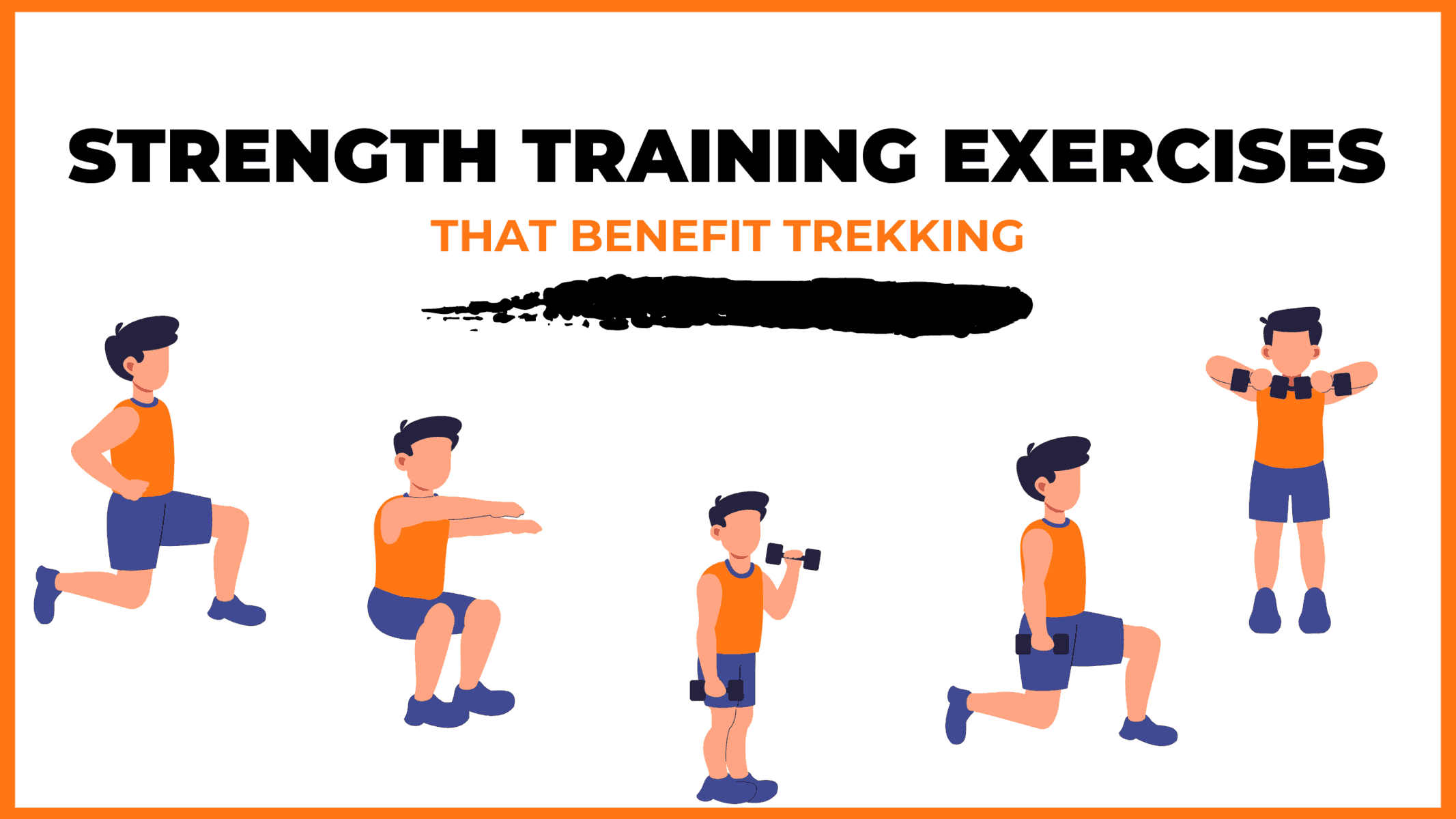
Trekking is a demanding activity that requires good cardiovascular endurance, muscular strength, and overall fitness. To help you prepare for your trek, incorporating bodyweight exercises into your training routine can be an effective way to build strength, improve stability, and enhance endurance, all of which are crucial for a successful trek. In this regard, here’s a breakdown of body weight exercises categorized by the specific body parts they target and the benefits they offer during trekking.
1. Lower Body Exercises
Lower body exercises like squats and lunges are great for building lower body strength, essential for trekking.
Squats are an excellent exercise for building lower body strength, essential for trekking. They target the quadriceps, hamstrings, glutes, and calves. Solid quadriceps and glutes provide power for ascending and tackling uphill climbs, while vital hamstrings aid stability during descents. This is particularly helpful in navigating uneven terrain during trekking.
How to perform Squats Exercises:
- Stand with feet shoulder-width apart, toes pointing slightly outward.
- Lower your body by bending your knees and hips, keeping your back straight.
- Lower until your thighs are parallel to the ground or as low as comfortable.
- Push through your heels to return to the starting position.
Lunges target the quadriceps, hamstrings, glutes, and calves. They improve lower body strength, balance, and stability, crucial for maintaining control on rocky trails and steep slopes. Additionally, they enhance flexibility, reducing the risk of injury while trekking.
How to Perform Lunge Exercises:
- Stand with feet hip-width apart, hands on hips or sides.
- Take a step forward with one foot, lowering your body until both knees are bent at 90-degree angles.
- Push through the heel of your front foot to return to the starting position.
- Repeat on the other side, alternating legs.
2. Upper Body Exercises
Upper body exercises such as push-ups and pull-ups effectively strengthen the upper body, especially the chest and shoulders, which are essential for carrying a backpack during treks.
a. Push-Ups
Targets: Chest, shoulders, triceps, and core.
Benefits for Trekking: Push-ups are an effective exercise to strengthen the upper body, especially the chest and shoulders, essential for carrying a backpack during treks. Improved upper body strength will also help maintain posture and stability while traversing challenging terrain.
How to Perform Push-Ups Exercises:
- Start in a plank position with hands shoulder-width apart and body in a straight line from head to heels.
- Lower your body by bending your elbows until your chest nearly touches the ground.
- Push through your palms to return to the starting position.
- Keep your core engaged throughout the movement.
b. Pull-Ups/Bodyweight Rows:
Targeting the back, biceps, and shoulders can significantly benefit trekking. You can strengthen these muscle groups by performing pull-ups or bodyweight rows and improve your posture and balance while carrying a backpack. Additionally, more muscular back muscles can help reduce the risk of back strain and fatigue during long treks, making your journey safer and more comfortable.
3. Core Exercises
Core exercises like planks and Russian twists can help strengthen the core muscles, which are crucial for maintaining stability and balance while trekking on uneven terrain.
Targets: Abdominals, obliques, and lower back.
Benefits for Trekking: Planks are an effective exercise that helps strengthen the core muscles. These muscles are crucial for maintaining stability and balance while trekking on uneven terrain. A strong core also helps improve posture, reducing the risk of back pain and fatigue during extended hikes.
How to Perform Planks Exercises:
- Start in a plank position with elbows directly under shoulders and body in a straight line from head to heels.
- Engage your core and hold the position, avoiding sagging or arching the back.
- Keep breathing steadily and hold for the desired duration.
b. Russian Twists
Targets: Obliques, abdominals, and lower back.
Benefits for Trekking: Russian twists engage the core muscles, particularly the obliques, improving rotational stability and balance. Enhanced core strength helps prevent injuries and improves overall performance during trekking.
How to Perform Russian Twist Exercises:
- Sit on the ground with knees bent and feet flat, leaning back slightly to engage the core.
- Clasp hands together and twist the torso to one side, bringing the hands towards the ground beside the hip.
- Return to the centre, then twist to the other side.
- Continue alternating sides for the desired number of repetitions.
4. Full Body/Cardiovascular Exercises
Full-body/cardiovascular exercises like burpees and mountain climbers are excellent for improving cardiovascular endurance, strength, and agility.
Burpees are an excellent full-body exercise that targets your legs, chest, arms, and core. This exercise dramatically benefits trekking enthusiasts, improving cardiovascular endurance, strength, and agility. Regularly incorporating burpees into your workout routine can enhance your overall fitness level, which can help you endure long hikes and rugged terrains with ease.
How to Perform Burpees Exercises:
- Start in a standing position.
- Squat down and place hands on the ground.
- Jump feet back into a plank position.
- Perform a push-up.
- Jump feet back to the squat position.
- Explosively jump up into the air, reaching overhead.
- Land softly and repeat the sequence.

b. Mountain Climbers
Mountain climbers target the core, shoulders, chest, and legs. This dynamic, full-body exercise can significantly improve cardiovascular endurance and agility. It is an excellent functional workout for trekking preparation as it engages both the upper and lower body muscles while strengthening the core muscles.
How to Perform Mountain Climbers Exercises:
- Drive one knee towards the chest, then quickly switch legs, alternating in a running motion.
- Keep the core engaged and the hips stable throughout the movement.
- Continue at a moderate to fast pace for the desired duration.
Incorporating bodyweight exercises into your training routine can help you build strength and endurance and prepare your body for the physical demands of trekking. Consistency and proper form are crucial to maximizing the benefits of these exercises and ensuring a safe and enjoyable trekking experience. Engaging your core muscles, including obliques, abdominals, and lower back, with Russian twists can improve your rotational stability and balance, preventing injuries and enhancing overall performance during trekking.
When incorporating strength training exercises into your workout routine, it’s essential to maintain proper form and technique to avoid injury. Start with lighter weights and gradually increase the intensity as you progress, focusing on compound exercises targeting multiple muscle groups simultaneously. Some examples of practical strength training exercises for trekking include squats, lunges, deadlifts, and pull-ups.
Remember to give your muscles time to recover between workouts, and remember to stretch before and after your workouts to prevent injury and improve flexibility. Combining strength training with jogging and proper stretching allows you to take your fitness to the next level and confidently tackle even the most challenging treks.
Our Trekkers Reviews And Expreinces
Food provided by us during trek.
We provide only Indian vegetarian food, and your meal will mainly consist of Indian bread, vegetables, lentils, rice, and a delicious dessert. During your trek, we will serve three meals a day, including breakfast, lunch, and dinner. You will also be served tea, snacks, and lip-smacking soup in the evening before dinner. If it is a long day of trekking, you will be given a packed snack.
After extensive research on the trekkers’ nutritional requirements, we prepare the menu. Before putting all the meals together, we also consider the altitude and the weather.
The meal we serve during the trek is perfectly balanced with calories, carbohydrates, vitamins, protein, fibre, and minerals. You need to know that all our cooks have great expertise in cooking and have undergone thorough training. So, get ready to enjoy delectable and lip-smacking dishes during your trek. You will be served with lemon tea in the tent to start your day with a refreshed feeling. Before leaving the campsite for trekking, you will be given a hot finger-licking breakfast like upma, Aallu Prantha, Besan Chilla, Poha, Daliya, Corn flakes, and Maggie, along with tea or coffee.
If your trek is longer, we also offer some fresh local fruits such as apples and healthy drinks like Frootie or Maaza. In the afternoon, you will be served a simple & healthy lunch, while at around 04:00 pm, you will be given tea and a light evening breakfast. After you reach your campsite at night, you will be served a hot and delightful dinner.
After reading this, you must have understood the food we provided on the trek; you don’t need to worry about food. Many trekkers repeatedly trek with us because of the food we provide. Thus, we will give you unforgettable experiences.
Safety During Markha Valley Trek

Trekking with us for the Markha Valley Trek is entirely safe because we have a team of trek leaders qualified in Wilderness first-aid and complete information about the high-altitude glitches. During the trek, we carry a full first-aid kit that contains all the essential medicines. Before trekking with us, you must ensure that you are medically fit for the trek; for us, your medical fitness is more important than anything else.
Right from our establishment, we at Trekup India have been continuously introducing new safety practices into Indian trekking to ensure the safety of voyagers. Trekup India introduced microspikes and made emergency bottled oxygen mandatory for all treks. Our trek leaders take your daily Pulse oximeter reading. We at Trekup India introduced the radio walkie-talkie as a safety communication device.
How can we ensure that your trek is safe with us?
We have noticed that most trek-organizing organizations do not follow these systems, but with time, they are following us; several competing companies are adopting these practices and organizing great, safe treks.
We ensure complete technical safety in the mountain. Our company has a vast team of more than 100 guides and trek leaders who serve on Himalayan treks. One of the best things about our team is that all the members are trained professionally by the Nehru Institute of Mountaineering, Indian Mountaineering Foundation Delhi, and Hanifle Center Outdoor Education Mussoorie.
Explore our New Safety Protocols
To ensure a perfect Trek, we have introduced some new safety checks to ensure excellent safety for our trekkers.
Our On-trek safety checks include:
- Daily oxygen saturation, along with pulse readings
- Stretchers team appointed on every trek
- Trained mountain staff and complete safety
- Additional oxygen cylinders
- Special medical kit for high-altitude treks
- Microspikes on all types of snow treks
- Experienced Trek leaders, as well as safety
- Technical team on all snowy slopes
For Us, Your Safety Is the Top Priority
At Trekup India, you will find a team with local knowledge and fluency in English and Hindi. This helps ensure that you have a fantastic trek. Not only this, but we also pay attention to your health and safety because this is something we cannot ignore. All the team leaders involved in trekking have already undergone several professional courses in first aid, portable altitude chamber training, CPR, environmental awareness training, and advanced wilderness emergency medicine.
We also carry a complete first aid medical kit on every trek and trip we organize. Apart from the medical kit, we take a portable altitude chamber (if needed) and medical oxygen for all high-altitude treks. Our company has significant expertise in organizing all sorts of group adventure holidays for family groups, school and college groups, and friend groups. We have many travel options that suit different fitness levels and travelling styles.
Regardless of the group size, we value each and every member of our trekking groups. Our commitment to personal attention ensures that your needs and safety are always our top priority.
Who we are?
Trekup India has been a stalwart in the Adventure Tourism industry for 30 years. Since our inception, we have been dedicated to providing top-notch treks, voyages, trekking programs, and high-altitude expeditions. Our extensive experience is a testament to our commitment to your adventure and safety.
We organize treks in Uttarakhand, Kashmir, Sikkim, and Himachal while being part of the trekking community; we feature more than 75 documented Himalayan treks. In addition to other outdoor activities, our company also organizes trips for schools, colleges, and families.
Therefore, we maintain the quality of services offered to our valuable customers.
Must Read These Information Of Markha Valley Trek
Why you should do markha valley trekk.
When you think of Markha Valley Trek, Wilderness Mountain comes to mind. The trail takes you through barren mountains with unique sights. Along the way, you’ll pass through traditional Tibetan villages like Kaya and Skiu, where you can experience the traditional culture of the Tibetan people and see how they make mud and stone huts. Markha Valley is like a hamlet in the middle of barren and dry mountains, surrounded by greenery. Take the chance to visit Leh Palace while in Leh. You may have seen photographs of this building-like structure overlooking the town. As you trek through Markha Valley, you’ll also see Kang Yatse Hill, a mesmerizing throne-shaped hill in Hemis National Park.
Best time to doMarkha Valley Trek
The best time to do this trek is in June and September, the summer season in Ladakh. The weather remains pleasant throughout the trek as the temperature does not rise too high during the day or too low at night. July and August are the most suitable time for trekking because, in these months, Manali – Leh and Srinagar – Leh highways are open to private vehicles.
Similar Treks
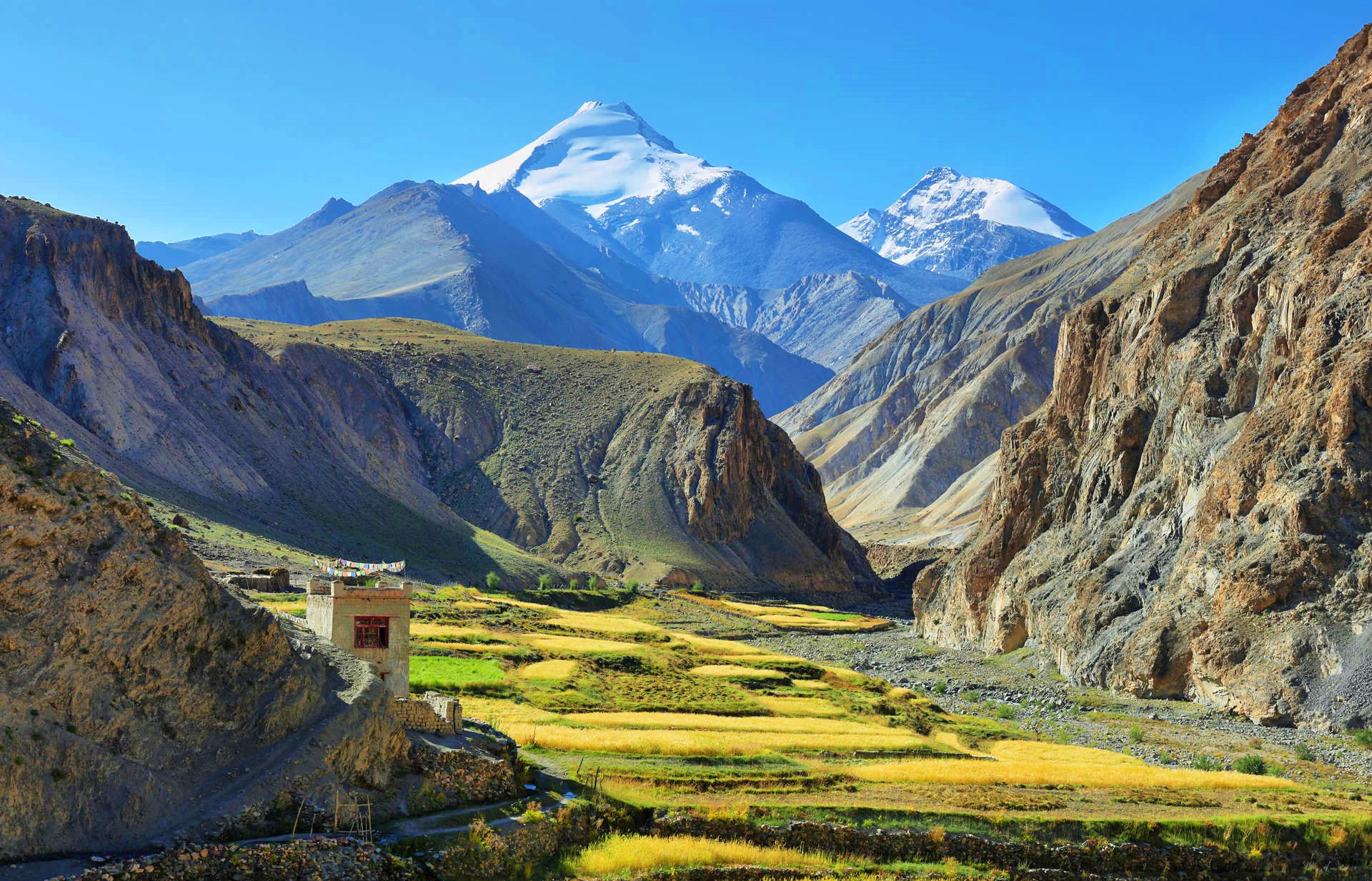
Kang Yatse 2 Trek

Nafran Valley Trek

Valley Of Flowers Trek

Hampta Pass Trek

Kashmir Great Lakes Trek

Markha Valley Trek
Markha valley in leh ladakh.
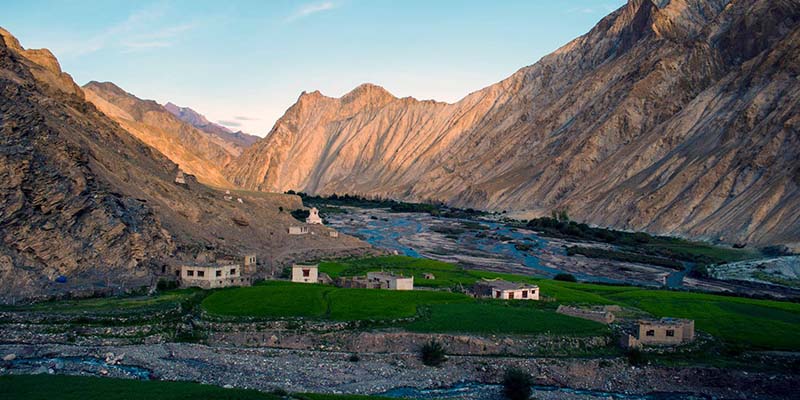
Description
Reviews (0), things to take, available dates, include / exclude, the markha valley trek is a popular trekking route located in the ladakh region of india.
Location : The Markha Valley Trek is situated in the Ladakh region of northern India, in the state of Jammu and Kashmir . The trek starts from the village of Chilling, which is about a 2-3 hour drive from Leh, the main city of Ladakh.
Altitude : The trek involves varying altitudes, with the highest point being Kongmaru La Pass at approximately 5,100 meters (16,732 feet) above sea level. It’s important to acclimatize properly due to the high altitude to avoid altitude sickness.
Route : The typical route for the Markha Valley Trek spans around 80 to 100 kilometers (50 to 62 miles) and usually takes around 6 to 8 days to complete. Here’s a rough itinerary:
- Chilling to Skiu : The trek usually starts from Chilling, and the first day involves hiking to Skiu, a small village along the Markha River. This is a relatively easy day of trekking.
- Skiu to Markha : The second day usually involves trekking from Skiu to Markha village. This part of the trek offers beautiful views of the surrounding landscapes and passes through several small villages.
- Markha to Hankar : On the third day, trekkers typically continue from Markha to Hankar. This part of the trek involves crossing the river multiple times and offers stunning views of the valley.
- Hankar to Nimaling : The fourth day usually involves trekking from Hankar to Nimaling, which is a high altitude pastureland. This part of the trek offers panoramic views of the surrounding mountains.
- Nimaling to Shang Sumdo via Kongmaru La Pass : On the fifth day, trekkers usually trek from Nimaling to Shang Sumdo via the challenging Kongmaru La Pass. This is the highest point of the trek and offers breathtaking views of the Himalayas.
- Shang Sumdo to Leh : The final day usually involves trekking from Shang Sumdo to the road head where vehicles will be waiting to take trekkers back to Leh.
Difficulty : The Markha Valley Trek is considered moderately difficult. While the terrain is not extremely technical, the high altitude and long hours of trekking each day can be physically demanding. Proper acclimatization and physical fitness are important for completing the trek safely.
Best Time to Trek : The best time to undertake the Markha Valley Trek is from mid-June to September when the weather is relatively stable and the trekking routes are accessible. However, it’s essential to check local conditions before planning your trek as weather patterns can vary.
Overall, the Markha Valley Trek offers a wonderful opportunity to experience the breathtaking landscapes and rich culture of the Ladakh region.
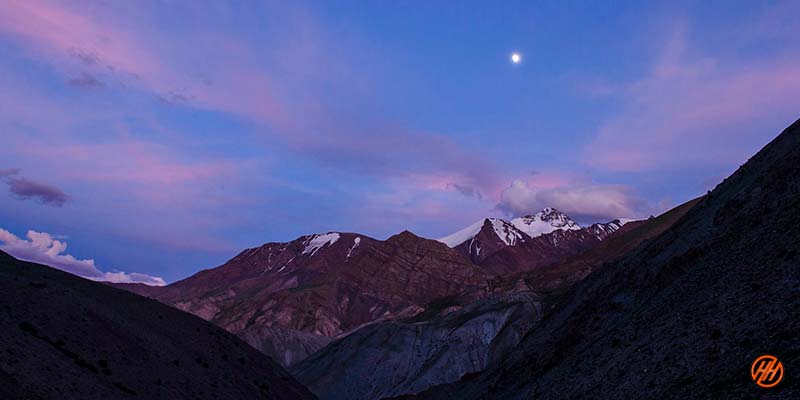
About Markha Valley Trek
The Markha Valley Trek has a history deeply intertwined with the cultural and geographical landscape of Ladakh, a region known for its remote and rugged terrain. While specific historical records of the trek may be scarce, the route itself follows ancient pathways that have been used by local inhabitants for centuries for trade, travel, and migration.
- Historical Trade Route : The Markha Valley, like many other valleys in the Himalayan region, has historically served as a crucial trade route connecting the remote villages of Ladakh with neighboring regions such as Tibet, Kashmir, and Central Asia. Merchants and traders would traverse these routes, transporting goods such as salt, wool, tea, and other commodities.
- Cultural Exchange : Along the trekking route, one can encounter Buddhist monasteries, ancient forts, and traditional villages that speak to the cultural heritage of the region. These sites reflect the historical interactions between the Tibetan Buddhist culture of Ladakh and the broader Himalayan and Central Asian cultures.
- Nomadic Pastoralism : The high-altitude pastures of the Markha Valley have long been used by nomadic herders for grazing their livestock, including yaks, sheep, and goats. The trek passes through several grazing grounds where nomadic families still maintain their traditional way of life, herding their animals across vast stretches of the Himalayan landscape.
- Modern Trekking Era : While the historical use of the route was primarily for trade and local travel, the modern era has seen the emergence of trekking as a popular activity in Ladakh. In the mid-20th century, adventurous travelers began exploring the region on foot, seeking to experience its pristine natural beauty and unique cultural heritage.
- Tourism Development : Over time, the Markha Valley Trek gained recognition as one of the premier trekking routes in the Himalayas, attracting trekkers from around the world. Local communities have adapted to the influx of tourists by establishing homestays, guesthouses, and other facilities along the route, contributing to the region’s economic development.
- Conservation Efforts : As tourism in Ladakh has grown, there has been increasing awareness of the need to balance conservation with development. Efforts have been made to promote responsible tourism practices and preserve the fragile ecosystems of the region, including initiatives to minimize waste, protect wildlife habitats, and support sustainable livelihoods for local communities.
Overall, the history of the Markha Valley Trek reflects the enduring connection between humans and the natural environment in the Himalayan region, as well as the ongoing evolution of Ladakh’s cultural identity in the modern era.
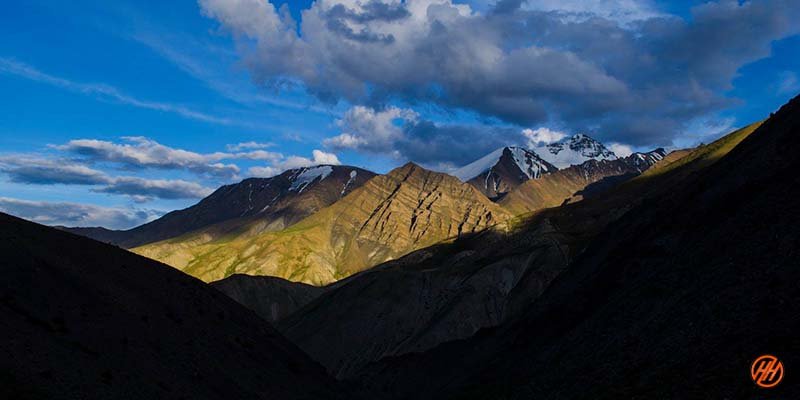
Short Itinerary of Markha Valley Trek Leh Ladkh
- Day 01 – Arrive in Leh. Rest & Acclimatization.
- Day 02 – Acclimatization in Leh city
- Day 03 – Drive to Skiu . (1/2 Hour). Same day Trek to Skiu Camp (1 hours)overnight stay Camp
- Day 04 – After breakfast trek Skiu to Sara – 3500 m (10 km) 5/-6 hours overnight stay Camp
- Day 05 – Trek from – Sara to Markha 3710 m (10 hours) 5-6 hours overnight stay Camp
- Day 06 – Trek – Markha to Lower Hunkar 3968 m (6 hours) overnight stay Camp
- Day 07 – Trek from Lower Hunkar to Nimaling – 4535 m (6-7 hours)overnight stay Camp
- Day 08 –Trek from Nimaling to Leh 3500 m via Kongmaru las pass 5336m (8 hours trek) same day drive to leh 3 hours overnight Hotel
- Day 09 – Departure from Leh
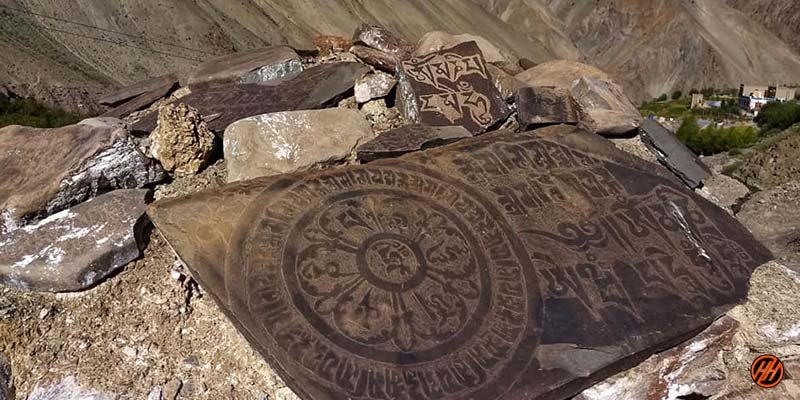
Key Points About Markha Valley Trek
- Level: Difficult (so first timers trekkers should avoid)
- Proper conditioning & training of body required
- Need proper gear & clothing for sub-zero temperatures?
- Shoes are the single most important equipment
- High Altitude requires proper acclimatization
- Phones don’t work on the trek
- Beautiful landscape so carry good photo gear (I couldn’t carry my best equipment)
- Travel light (my backpack was heavy at about 10 kg to 12 Kg)
The difficulty level of the Markha Valley Trek?
The difficulty level of the Markha Valley Trek is typically considered moderate to moderately difficult, depending on various factors such as altitude, terrain, weather conditions, and individual fitness levels. Here’s a breakdown of some key aspects contributing to the trek’s difficulty:
- Altitude : The trek involves hiking through high-altitude terrain, with the highest point, Kongmaru La Pass, reaching approximately 5,100 meters (16,732 feet) above sea level. Altitude sickness can be a concern for some trekkers, especially if proper acclimatization is not observed. It’s essential to ascend gradually, stay hydrated, and listen to your body to prevent altitude-related illnesses.
- Terrain : The trail encompasses a variety of terrain, including rocky paths, river crossings, narrow gorges, and steep ascents and descents. Some sections may require scrambling over boulders or navigating narrow ridges, adding to the physical challenge of the trek.
- Duration and Distance : The standard itinerary for the Markha Valley Trek spans around 6 to 8 days, covering approximately 80 to 100 kilometers (50 to 62 miles). Trekking for several consecutive days with long hours of walking can be physically demanding, particularly for those who are not accustomed to hiking or carrying a backpack.
- Weather Conditions : Ladakh experiences extreme weather conditions, with temperature fluctuations ranging from hot during the day to freezing at night, especially at higher altitudes. Trekkers may encounter strong winds, sudden changes in weather, and occasional snowfall, particularly if trekking early or late in the season.
- Remote Location : The trek takes place in a remote and isolated region, far from medical facilities and other amenities. Trekkers need to be self-sufficient and prepared for unforeseen circumstances, such as injury or adverse weather conditions. Carrying essential gear, including a first aid kit, extra clothing, and sufficient food and water, is crucial for safety and comfort.
Overall, while the Markha Valley Trek is achievable for most physically fit individuals with some trekking experience, it does require preparation, perseverance, and a respect for the challenges posed by the high-altitude environment. Proper training, acclimatization, and adherence to safety guidelines can help ensure a rewarding and enjoyable trekking experience in this stunning Himalayan landscape.
How to Reach Leh for Markha Malley Trek?
Reaching Leh, the starting point for the Markha Valley Trek, typically involves traveling by air or road, as the region is landlocked and located in the remote Himalayan Mountains. Here are the primary ways to reach Leh:
- Flight to Leh : The most common and convenient way to reach Leh is by air. Kushok Bakula Rimpochee Airport in Leh is well-connected to major cities in India, including Delhi, Mumbai, Bangalore, and Srinagar. Several airlines operate regular flights to Leh, especially during the peak tourist season from May to September. Flight duration varies depending on the origin city but generally ranges from 1.5 to 2.5 hours.
- Manali-Leh Highway : The Manali-Leh Highway is a popular road route to Leh, especially for those traveling from northern India. The highway passes through breathtaking landscapes, high mountain passes, and remote villages. The journey from Manali to Leh covers a distance of approximately 473 kilometers (294 miles) and typically takes around 2 days, with an overnight stop in Keylong or Sarchu. The highway is open from late May to early October, depending on weather conditions.
- Srinagar-Leh Highway : Another scenic road route to Leh is via the Srinagar-Leh Highway, which connects Leh with the city of Srinagar in the Kashmir Valley. This route traverses through the picturesque Kashmir Valley, crossing high mountain passes like Zoji La and Fotu La. The distance between Srinagar and Leh is approximately 434 kilometers (270 miles), and the journey usually takes around 2 days, with an overnight stop in Kargil. Similar to the Manali-Leh Highway, the Srinagar-Leh Highway is open from late May to early October.
Once you reach Leh, you can make arrangements for the Markha Valley Trek, including hiring a guide, obtaining permits (if required), and arranging transportation to the trek’s starting point in Chilling or Spituk, depending on your chosen route. Leh also offers various accommodation options, restaurants, and stores where you can purchase trekking supplies and essentials before embarking on the trek.
Best time to Visit Markha Valley Trek Leh Ladakh India
The best time to undertake the Markha Valley Trek is during the summer months, from mid-June to September, when the weather is most conducive to trekking and the trails are generally free from snow. Here’s why:
- Weather : During the summer months, Ladakh experiences relatively mild temperatures and clear skies, making it an ideal time for outdoor activities like trekking. Daytime temperatures in the Markha Valley during this period typically range from 15°C to 25°C (59°F to 77°F), offering comfortable conditions for hiking.
- Accessibility : The summer season sees the opening of high-altitude passes and mountain trails, including the ones used for the Markha Valley Trek. Roads leading to Leh, the starting point for the trek, are also open and accessible, allowing for easy travel to the region.
- Scenery : The summer season brings vibrant colors to the landscapes of the Markha Valley, with blooming wildflowers, lush greenery, and snow-capped peaks creating a picturesque backdrop for trekking. The rivers are also more manageable for crossings compared to other times of the year.
- Cultural Festivals : Ladakh is known for its vibrant cultural festivals, some of which coincide with the summer months. Visitors trekking in the Markha Valley during this time may have the opportunity to witness local festivals, such as Hemis Festival, which celebrates Tibetan Buddhism and includes colorful masked dances and rituals.
While summer is the most popular time to visit the Markha Valley, it’s essential to be prepared for fluctuations in weather, especially at higher altitudes. Trekkers should carry appropriate gear for varying conditions, including warm clothing, rain gear, sun protection, and sturdy trekking shoes.
Additionally, it’s advisable to check local conditions and forecasts before embarking on the trek, as weather patterns can be unpredictable in mountainous regions. Overall, the summer months offer the best combination of favorable weather, accessibility, and scenic beauty for experiencing the Markha Valley Trek to its fullest.
Things to Carry on Markha Valley Trek
When embarking on the Markha Valley Trek, it’s essential to pack carefully to ensure you have all the necessary items for a safe and enjoyable journey.
Here’s a comprehensive list of things to carry:
- Moisture-wicking base layers (tops and bottoms)
- Insulating mid-layers (fleece or down jacket)
- Waterproof and windproof outer shell jacket
- Waterproof and breathable trekking pants
- Thermal underwear (for colder days or nights)
- Lightweight and quick-drying trekking shirts (long-sleeve and short-sleeve)
- Comfortable trekking shorts or convertible pants
- Warm hat or beanie
- Gloves or mittens
- Sun hat or cap
- Sunglasses with UV protection
- Buff or scarf (for sun protection or warmth)
- Sturdy and broken-in trekking boots with ankle support
- Comfortable camp shoes or sandals for wearing around camp
- Moisture-wicking trekking socks (synthetic or wool blend)
- Gaiters (optional, for keeping debris out of boots and protecting ankles)
Backpack and Accessories :
- Trekking backpack with rain cover (30-50 liters)
- Lightweight daypack for shorter excursions from camp
- Water bottles or hydration system (1-2 liters capacity)
- Trekking poles (optional but recommended for stability and reducing strain on knees)
- Dry bags or stuff sacks for organizing gear and keeping items dry
- Headlamp or flashlight with extra batteries
- Personal toiletries and hygiene products (toothbrush, toothpaste, biodegradable soap, hand sanitizer, etc.)
- Quick-drying towel or pack towel
- Personal medications and first aid kit (including altitude sickness medication, blister treatment, pain relievers, etc.)
- Trekking permits and identification documents (passport, permits, emergency contact information)
Sleeping Gear :
- Lightweight and compact sleeping bag suitable for the expected temperatures
- Sleeping pad or mattress for insulation and comfort
Food and Cooking :
- High-energy snacks (nuts, dried fruits, energy bars, chocolate, etc.)
- Lightweight and compact camping stove with fuel
- Cooking utensils (pot, pan, utensils, plates, cups, etc.)
- Biodegradable soap and sponge for cleaning dishes
- Lightweight and nutritious dehydrated or freeze-dried meals
- Water purification tablets or filter (for refilling water from streams or rivers)
Miscellaneous :
- Map and compass or GPS device (plus spare batteries)
- Lightweight and compact camera or smartphone for capturing memories
- Notebook and pen for journaling or taking notes
- Multi-tool or pocket knife
- Sunscreen with high SPF and lip balm with SPF
- Insect repellent or bug spray
- Whistle and signaling mirror (for emergencies)
- Portable power bank for charging electronic devices
- Trash bags for carrying out waste and leaving no trace
It’s important to pack efficiently and avoid carrying unnecessary items to keep your backpack as light as possible while ensuring you have everything you need for the trek. Adjust the list based on the duration of your trek, weather conditions, personal preferences, and any specific requirements or recommendations from your trekking guide or tour operator.
Trekking with Himalayan Hikers on the Markha Valley Trek
Trekking with Himalayan Hikers on the Markha Valley Trek offers an immersive and unforgettable experience for several reasons:
- Expertise : Himalayan Hikers is renowned for its experienced guides who are well-versed with the local terrain, culture, and safety measures. They ensure a smooth and enriching trekking experience.
- Scenic Beauty : The Markha Valley Trek is renowned for its breathtaking vistas, including snow-capped peaks, lush valleys, picturesque villages, and ancient monasteries. Himalayan Hikers ensures you witness the best of these natural wonders.
- Cultural Immersion : Trekking with Himalayan Hikers allows you to interact with the local Ladakhi people, experiencing their unique culture, traditions, and hospitality firsthand. You’ll have the opportunity to stay in traditional homestays and learn about their way of life.
- Small Groups : Himalayan Hikers typically organizes small group treks, fostering a more intimate and personalized experience. This allows for better interaction with the guides and fellow trekkers, creating a sense of camaraderie.
- Safety Measures : Safety is paramount on any trek, and Himalayan Hikers prioritizes it by providing well-equipped guides, first aid kits, and adhering to safety protocols. They also have emergency evacuation plans in place if needed.
- Customization : Whether you’re a novice or an experienced trekker, Himalayan Hikers can tailor the trek to suit your preferences and fitness levels. They offer various itinerary options and can accommodate special requests.
- Responsible Tourism : Himalayan Hikers is committed to responsible and sustainable tourism practices. They strive to minimize environmental impact, support local communities, and promote eco-friendly trekking initiatives.
Preparing for the Markha Valley Trek
Preparing for the Markha Valley Trek involves several key aspects to ensure a safe and enjoyable experience. Here’s a guide to the type of preparation you should consider:
- Physical Fitness : The Markha Valley Trek involves walking long distances over varied terrain and altitudes. Building endurance through cardiovascular exercises like hiking, jogging, or cycling, as well as strength training for leg muscles, will help you tackle the trek with ease. Aim for a fitness level that allows you to walk for several hours a day with a backpack.
- Altitude Acclimatization : Markha Valley Trek reaches altitudes above 4,000 meters (13,000 feet), which can lead to altitude-related sickness if not acclimatized properly. Consider arriving in Leh, the starting point of the trek, a few days in advance to acclimatize to the high altitude. During the trek, ascend gradually, stay hydrated, and listen to your body for any signs of altitude sickness.
- Packing Essentials : Pack light but ensure you have all the essential gear. This includes sturdy hiking boots, comfortable clothing suitable for layering, a warm insulated jacket, rain gear, a good quality backpack, sleeping bag, headlamp or flashlight, water bottle, sunscreen, sunglasses, hat, and personal toiletries. Don’t forget any necessary medications and a basic first aid kit.
- Training Hikes : Prior to the trek, undertake some training hikes to simulate the conditions you’ll encounter on the Markha Valley Trek. This will help you gauge your fitness level, break in your hiking boots, and familiarize yourself with carrying a backpack for extended periods.
- Mental Preparation : Trekking in remote mountainous regions can be physically and mentally challenging. Prepare yourself mentally for long days of walking, unpredictable weather conditions, and basic accommodation facilities. Stay positive, be flexible, and embrace the adventure.
- Research and Planning : Familiarize yourself with the route, terrain, and potential challenges of the Markha Valley Trek. Study maps, read trekking guides, and seek advice from experienced trekkers or tour operators like Himalayan Hikers. Plan your itinerary, including rest days for acclimatization and contingencies for emergencies.
- Permits and Documentation : Ensure you have all the necessary permits and documentation required for the trek, including any permits for entering restricted areas or national parks. Check the latest regulations and obtain permits well in advance to avoid any last-minute hassles.
Day 1: Arrive in Leh. Rest & Acclimatization
Arrive in Leh by 12 PM. Today is for rest & acclimatization. Being outdoors is recommended as it helps in the acclimatization process. Explore the local market of Leh. Have the local cuisine and enjoy shopping for dry fruits and local handicrafts.
Day 2: Acclimatization in Leh city
Explore the cultural and natural beauty of Leh. This will make you familiar with the town and also help in acclimatizing to the weather. Leh is the center point of Ladakh and also a major town from where all expeditions begin. It is also a culturally rich place. There are dozens of monasteries and ancient temples that you can go around. They are located in and around the town. Enjoy the local cuisines which are a major attraction for travelers.
Day 3: Drive to Skiu . (1/2 Hour). Same day Trek to Skiu Camp (1 hours)overnight stay Camp
Drive to Skiu . (1/2 Hour). Same day Trek to Skiu Camp (1 hours)overnight stay Camp.
Day 4: After breakfast trek Skiu to Sara – 3500 m (10 km) 5/-6 hours overnight stay Camp
After breakfast trek Skiu to Sara – 3500 m (10 km) 5/-6 hours overnight stay Camp.
Day 5: Trek from – Sara to Markha 3710 m (10 hours) 5-6 hours overnight stay Camp
Trek from – Sara to Markha 3710 m (10 hours) 5-6 hours overnight stay Camp
Day 6: Trek – Markha to Lower Hunkar 3968 m (6 hours) overnight stay Camp
Trek – Markha to Lower Hunkar 3968 m (6 hours) overnight stay Camp.
Day 7: Trek from Lower Hunkar to Nimaling – 4535 m (6-7 hours) overnight stay Camp
Trek from Lower Hunkar to Nimaling – 4535 m (6-7 hours) overnight stay Camp.
Day 8: Trek from Nimaling to Leh 3500 m via Kongmaru las pass 5336m (8 hours trek) same day drive to leh 3 hours overnight Hotel
Trek from Nimaling to Leh 3500 m via Kongmaru las pass 5336m (8 hours trek) same day drive to leh 3 hours overnight Hotel.
Day 9: Departure from Leh
Departure from Leh.
Mandatory Documents
Please carry the documents given below.
Original and photocopy of government photo identity card- (Aadhar Card, Driving License, Voters ID, etc, Passport and Visa important to foreigners Medical Certificate (First part should be filled by the Doctor and Second part by the Trekker) Declaration Certificates
Note: – Many trekkers commit the same mistake of carrying unnecessary items on a trek which only makes the backpack heavy. It is important to know the right items to carry. It differs from season to season if you are trekking in summers then carry less layers of warm clothing and if you are trekking in winters carry enough layers to protect yourself against chilly cold.
Necessary Items for trekkers

Backpack (50 to 60 liters) A strongly built backpack with good support is compulsory for a trek. (Rain cover is important)
Sturdy Trekking Shoes The shoes should be strong enough with good support. The people ask if sports shoes would be comfortable but it is good to bring the right trekking shoes.
The Clothes You Should Bring On a Trek Avoid keeping extra clothes because it only makes you backpack heavy.
Trek Pants – The jeans are never suitable for a trek so you need at least 2-3 trek pants for treks carry more for longer treks.
Jacket – Jackets are very important to carry on a trek it protects you against the chilly weather. So carry 2 jackets on a week long trek.
Layers of warm Clothing Carry warm woolen layers or fleece. Carry more layers during winter season (at least 2 to 3) and less during summer.
Thermals – The Temperature decreases at night so you might be need thermals for Night.
T- Shirts – Bring those t shirts which dry fast.
Poncho –They are needed if you are trekking on a Rainy day to keep you dry.
Hiking Pole
Water Bottle 2
Cap or Balaclava
Woolen and Waterproof Gloves
Socks (Woolen and Regular)
Torch head light
Personal Toiletry Items – (toothpaste, toothbrush, toilet paper, sanitizer etc.)
Carry Personal Medical Kit
Personal Medical Kit (Carry minimum 5 tablets and maximum 10)

Diamox – (Prevents altitude sickness)
Digene – (It cures discomfort in stomach, acidity)
Crocin Advance – (Cures fever and headache)
Aspirin/Combiflam – (Pain reliever)
Disprin – (Cures headache)
Avomine – (Prevents motion sickness)
Avil – (It treat allergies)
Norflox TZ & Lomofen – (Prevents Diarrhoea)
Ranitidine – (Reduces the amount of acid in stomach)
Volini/Moov spray – (For sprains)
Betadine/Savlon – (Antiseptic cream)
Stretchable/Elastic bandage
Note:- Use medicines only when prescribed by the doctor. In case you face any problem during your trek, discuss and take advice from the Professional guide.
Sorry! Here are no Available dates right now. For Any Queries you can Email us with [email protected] and Call Us +91 9756197558
What is Included In This Trek?
- Transport from Leh Airport to Leh Airport
- Forest Permit and entrance fee
- Accommodation in our Hotel/Home Stay
- Accommodation in tents on twin share basis
- All meals: Breakfast, lunch, tea, coffee, snacks, soup and Dinner
- Radio Walkie Talkie for Communicatio n
- High quality Dome tents
- Sleeping bags
- Toilet tents
- Dining Tent
- Dining table
- Camping stole
- Kitchen team
- Good Experience Trek Leader Guide and Technical Guide
- Medical Kit
- Oxygen Cylinders
- Crampons and Gaiters
- More technical equipments
- Helmet, Rope, Ice Axe
What is Not Include In This Trek?
- Personal Insurance mandatory for Markha Valley Trek
- Personal toiletry Items
- Meals in Leh market hotel/home stay
- Anything not specifically mentioned under the head Inclusions
- Inner Line Permit Fee
- medical certificate is mandatory for trek permit
- On the first day en route to base camp the breakfast and lunch are not included
- last day en route lunch and dinner are not included
Porters Costs Per Bag Per Day Rs. 500.00 Per person Extra pay to Directly our Manager
Note – We serve three meals a day including snacks and soup. A variety of delectable and healthy food is provided which includes Indian, Chinese and other Western meals. They are nutritious and keep you fit and healthy on the trek. (Veg or Non-Veg food)
There are no reviews yet.
Your email address will not be published. Required fields are marked *
Name *
Email *
Save my name, email, and website in this browser for the next time I comment.
Related Tours
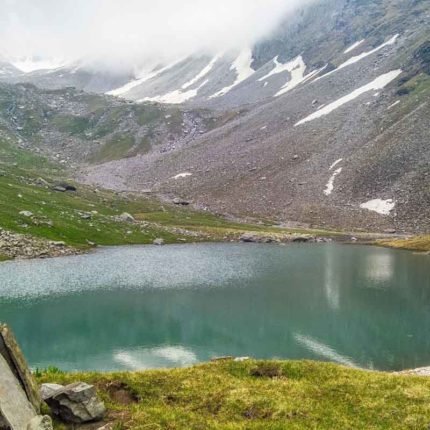
Chandranahan Lake Trek
CHANDRANAHAN LAKE an Alpine Lake in Himachal Pradesh
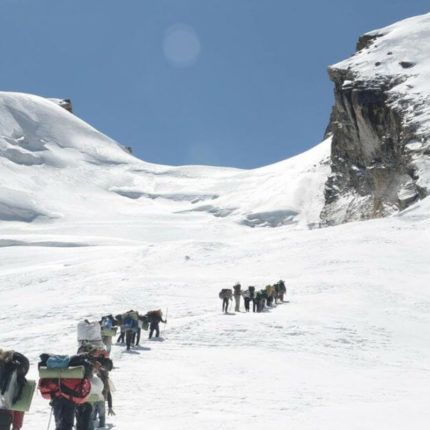
Sinla Pass Trek
Sinla Pass a high Pass in the ‘Little Kashmir’ of Uttarakhand
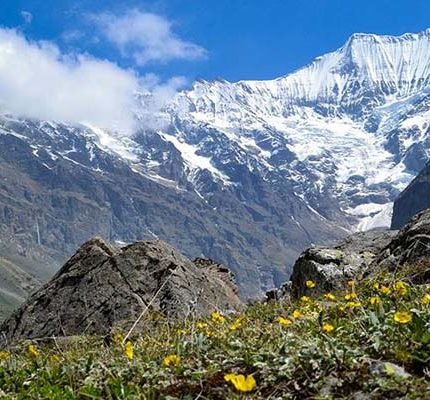
Sunderdhunga Trek
Sunderdunga Trek in Kumaon Garhwal Range, Uttarakhand.
Price: ₹ 35,000.00
Book the tour
Send a quick enquiry.
- Overview Itinerary Dates Include/Exclude
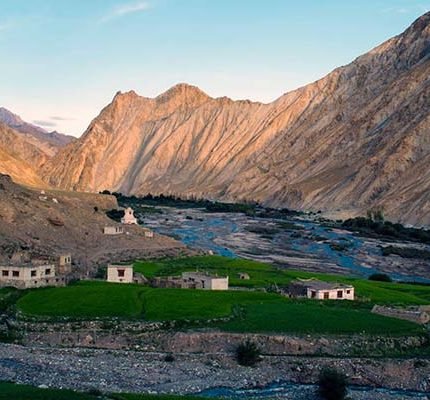
- Weekend +91 87 6262 3333
- Himalayan +91 9886 444 809
- International +91 84968 85968
- [email protected]
- One Day Treks
- Two Day Treks
- Himalayan Treks
- International Treks
- Private Treks
- Group Adventures
![Markha Valley Trek [Premium] - Tour Markha Valley Trek [Premium] - Tour](https://vl-prod-static.b-cdn.net/system/images/000/696/989/20d9fde45193baa6c2d7e0a59e6354d8/x600gt/ladakh-g02a1788ab_1920.jpg?1716818181)
- Markha Valley Trek [Premium]
- Secure & Easy Booking
- Best Price Guaranteed
- 1000+ Happy Customers
Markha Valley is a hidden gem nestled in the Himalayas. Discover the untouched beauty of this picturesque region, where rugged landscapes, charming villages, and high mountain passes await. Immerse yourself in the unique culture of Ladakh as you interact with welcoming locals and witness majestic views of Kang Yatse and the Himalayas. With meticulous planning and expert guidance, the Markha Valley Trek promises an unforgettable journey, offering a perfect blend of natural wonders and cultural experiences. Take this extraordinary Himalayan trek that will leave you with cherished memories and a profound connection with the mountains. Secure your registration with just a 20% deposit today and pay the remainder 30 days before the departure date. Your journey awaits! ✈️
LEH is located in the northernmost parts of the country. It is traveller friendly, enchanting and a hassle-free fun town lapped in the snow-covered fringes of the Himalayas. You can explore the bustling Local bazaar, and enjoy some delicious food ranging from the local cuisine, Mughlai, Tibetan, and Chinese to Italian. Narrow footpaths, sturdy walls, and a view of snow-covered mountains make you fall in love with the place instantly. There are a number of interesting places and monasteries to visit in and around Leh, such as – Shanti Stupa, The Leh Palace, the monasteries of Shey, Hemis, Alchi, Thiksey and Lamayuru, the Armed Forces Hall of Fame and much more!
You need more information?
short itinerary:.
- Day 1: Arrival in Leh - Transfer to Hotel
- Day 2: Acclimatization Hike to Shanti Stupa and Leh Mountain (3,500m)
- Day 3: Drive to Skiu (3,400m) - Trek to Sara (3,600m)
- Day 4: Trek from Sara to Markha (3,750m)
- Day 5: Trek from Markha to Thochungtsey (4,300m)
- Day 6: Trek from Thochungtsey to Nimaling (4,700M)
- Day 7: Trek from Nimaling to Chokdo (3,900m) via Kongmaru La (5,200m) & Drive to Leh
- Day 8: Leh Sightseeing Day
- Day 9: Departure - Fly Back
Detailed Itinerary of Markha Valley Trek:
Day 1: Arrival in Leh - Transfer to Hotel Upon your arrival in Leh, the captivating capital of Ladakh, TrekNomads warmly welcomes you to this mesmerizing land of high-altitude beauty. We will transfer you to your comfortable hotel, allowing you to acclimatize to the thin mountain air. Take this day to rest and relax, getting accustomed to the altitude and serene surroundings. In the evening, venture out for a leisurely walk around the local market, where vibrant colours, traditional crafts, and the aroma of local delicacies will immerse you in the unique Ladakhi culture.
Day 2: Acclimatization Hike to Shanti Stupa and Leh Mountain (3,500m) To ensure a safe and enjoyable trek, we dedicate Day 2 to acclimatization. After a hearty breakfast, get ready for a rewarding hike to Shanti Stupa, an iconic Buddhist monument offering awe-inspiring views of Leh and the surrounding landscapes. From there, we venture to a nearby Leh mountain, surrounded by nature's grandeur, providing further acclimatization amidst breathtaking scenery.
Distance covered: Approximately 5 kilometres (round trip). Time required: 2 - 3 hours.
Day 3: Drive to Skiu (3,400m) - Trek to Sara (3,600m) The real adventure begins as we drive from Leh to Skiu, a picturesque village located along the glistening Markha River. Our trek commences from Skiu, leading us through lush valleys and charming hamlets before reaching Sara. Here, amid the tranquil ambience, we set up camp or stay at a homestay, enjoying a magical evening amidst nature's splendour.
Travel Distance covered: Approximately 90 kilometres. Time required: 2 - 3 hours.
Day 4: Trek from Sara to Markha (3,750m) Today's trek takes us to Markha, a quaint village renowned for its vibrant culture and traditional Ladakhi architecture. Traverse through scenic landscapes, cross the river, and interact with the friendly locals, gaining insight into their way of life. As the evening descends, find yourself amidst the welcoming embrace of Markha village.
Trek distance: Approximately 20 kilometres. Time required: 6 - 7 hours.
Day 5: Trek from Markha to Thochungtsey (4,300m) The trail now leads to Thochungtsey, a pristine camping site set against the backdrop of majestic snow-capped peaks. As we ascend, the landscapes transform, revealing the rugged beauty of the region. Capture moments of serenity and immerse yourself in the untouched splendour of the Himalayas.
Trek distance: Approximately 12 kilometres. Time required: 5 - 6 hours.
Day 6: Trek from Thochungtsey to Nimaling (4,700M) Prepare for a day of breathtaking views as we trek to Nimaling, a high-altitude grazing ground offering stunning vistas of Kang Yatse, a prominent Himalayan peak. Embrace the vastness of the Himalayas, surrounded by pristine beauty, making this a truly unforgettable experience.
Trek distance: Approximately 10 kilometres. Time required: 4 - 5 hours.
Day 7: Trek from Nimaling to Chokdo (3,900m) via Kongmaru La (5,200m) & Drive to Leh The pinnacle of our adventure awaits as we cross the high mountain pass of Kongmaru La at a thrilling altitude of 5,200 meters. Revel in the panoramic vistas before descending to Chokdo, where our trek concludes. From Chokdo, we bid farewell to the mountains and drive back to Leh. Enjoy the evening in Leh, reminiscing about the incredible journey.
Trek distance: Approximately 14 kilometres. Time required: 7 - 8 hours.
Day 8: Leh Sightseeing Day Take this day to explore the captivating attractions of Leh. Visit ancient monasteries like Hemis and Thiksey, marvel at the magnetic phenomenon at Magnetic Hill, and savour the local culture at Leh market. Unwind in the serene ambience of Leh, absorbing the spiritual essence of this enchanting land.
Day 9: Departure - Fly Back With cherished memories and a profound connection with the mountains, it's time to bid farewell to Ladakh. After breakfast, we will transfer you to the airport for your onward journey. Take with you the indelible experiences of the Markha Valley Trek, and we hope to welcome you back soon for more extraordinary adventures with TrekNomads.
Risk and Liability
We will endeavour to make your program smooth and as pleasant as possible. However, the entire course of trekking depends on the ranges of the mighty mountains, physical health, and environmental conditions. Therefore, TrekNomads shall not be responsible for any changes in the itineraries due to unavoidable circumstances and natural disasters such as landslides, road blockages, floods, snowing, cancellations of flights and delays, or any type of sickness including altitude sickness.
Do’s and Don’ts:
- We believe in leaving the mountains in a better condition, which is why we follow a no-litter policy on our treks. Each trekker will have to bring back the waste that is created during the trek.
- Trekking is best enjoyed when you’ve worn comfortable clothes. Try and avoid wearing Jeans, bright colours and heavy apparel as much as possible.
- A lighter backpack always helps you have a better trek, try and carry just as much as needed.
- Always be in sight of your trek lead, if you feel the need to stop for any reason at all, please keep the trek lead informed.
- If you do come across any reptiles, animals or even insects during the trek, please keep your calm and let it patiently pass by. Any kind of noise and panic will scare them as well.
- Do not venture out into the forest/waterfalls on your own as it may be dangerous.
- Trekking is a good adventure, having said that, it is our primary responsibility to take good care of ourselves and be compassionate towards fellow trekkers
- If, at any point, during the trek, you feel uneasy or unwell, please inform the trek lead immediately
- Tune in to the sounds of nature while on a trek and avoid carrying speakers or playing music during the course of the trek
- To help you enjoy the trek to the fullest, we avoid smoking and consumption of alcohol, and other intoxicants during the course of the trek
What is included in the tour
- 04 nights accommodation at a Deluxe Hotel in Leh on a double or triple sharing basis with dinner and breakfast
- 03 nights of homestay accommodation
- 01 night of tented accommodation on double sharing basis
- Meals: Dinner on Day 1, (BF/Dinner) meals on Day 2, (BF/Lunch/Dinner) meals from Day 3 to Day 8 and BF on Day 9
- Standard vegetarian food (plus eggs) for breakfast, lunch and dinner during the trek
- Hot drinking water facility during the trekking days
- Transportation as per the itinerary by NAC Vehicle, Leh to Chilling (Day 3) & Chokdo to Leh (Day 8)
- Porter for personal luggage during the trek up to 10 kg
- Trek equipment: Sleeping bags, Mattresses, Utensils, Ropes
- Tents: Trekkers tent (twin sharing), Kitchen & Dining tent, Toilet tent
- 1 Mountaineering qualified & professional trek guide
- Insurance, meals, transportation daily salary of guide & porter
- Basic First aid Kit with a portable oxygen cylinder
- Personal accident insurance
- All government, local taxes and service charges
- TrekNomads Fee, Trek Captain support and expertise
- 15% discount coupon on Gokyo Trek Apparel and Gear
- ~15% discount on Fast&Up products
- 15% discount on BMore products
- Personalized Dri-Fit T-shirt and Cap
- TrekNomads goodies
What is NOT included in the tour
- The cost to reach Leh and back
- Single room occupancy at Leh
- Individual Tent & Porter (available at extra cost)
- Personal accident and travel insurance
- Medical, Emergency Rescue and Evacuation cost
- Personal trekking gear
- Tips for guide, chef, porter, etc
- Local sightseeing and monastery entrance fee, camera fee, etc
- Transportation is not on a disposal basis. It is strictly as per the program, any extra running will be charged extra.
- Any other expenses incurred apart from inclusions
- All personal and medical expenses, emergency expenses like extra day stay or vehicle charges due to delays, natural calamities (landslides, floods), flight delays/rescheduling/cancellations, any accidents / medical evacuations, riots/strikes & etc.
Other Details:
- Trek Gradient: Difficult
- Trek Distance: 50+ Km
- Assembling Point: Leh
- Trek Duration: 30+ hours
- Average Temperature: 25 to 5 degrees (during the day) and 5 to -15 degrees (during the night)
- Season: July - September
- Nearest Airport: : Leh Airport (Kushok Bakula Rimpochee Airport)
- Nearest ATM: Leh Airport and Market
Frequently Asked Questions (FAQs) for Markha Valley Trek with TrekNomads:
What is the best time for Markha Valley Trek? - Discover the ideal trekking season from mid-June to mid-September for Markha Valley Trek, ensuring pleasant weather and breathtaking vistas.
How challenging is Markha Valley Trek? - Explore the moderate to difficult level of Markha Valley Trek, ideal for trekkers with prior experience and good physical fitness.
How to avoid altitude sickness during the trek? - Acclimatization days during the first two days are crucial and also following the instructions by the trek lead on drinking enough water and eating well during the trekking days.
What is the duration of Markha Valley Trek? - Unveil the 9-day adventure of Markha Valley Trek, including acclimatization days and exploration of stunning landscapes.
What are the accommodation options during the trek? - Experience 3-star hotels at Leh and cosy stays in comfortable tents with essential amenities at designated camping sites during Markha Valley Trek with TrekNomads.
What kind of meals are provided during the trek? - Relish delicious and nutritious vegetarian meals, including local and continental dishes, catered to diverse tastes and dietary preferences during Markha Valley Trek.
Is Markha Valley Trek suitable for solo travellers? - Find safety and camaraderie in Markha Valley Trek, as qualified trek leaders and support staff guide solo travellers through this unforgettable journey.
What are the cultural highlights of the trek? - Immerse yourself in rich cultural experiences, meeting friendly locals, visiting ancient monasteries, and cherishing Ladakhi heritage during Markha Valley Trek.
What are the essential trekking gear required? - Prepare for Markha Valley Trek with sturdy trekking shoes, warm clothing, rain gear, sunglasses, and more. A comprehensive packing list will be shared upon booking.
Are there age restrictions for the trek? - The recommended age range of 12 to 65 years, subject to physical fitness and medical conditions, for embarking on the Markha Valley Trek.
Disclaimer: The information provided in these FAQs is subject to change based on the latest guidelines and conditions. For the most up-to-date details, kindly refer to TrekNomads' latest information before undertaking the Markha Valley Trek.
Loading the map...
- CONNECT WITH US
- TREKNICAL DETAILS

Recognitions

OTHER POPULAR TOURS
![Valley of Flowers Trek and Hemkund Sahib [Premium] - Tour Valley of Flowers Trek and Hemkund Sahib [Premium] - Tour](https://vl-prod-static.b-cdn.net/system/images/000/326/464/f004eeac1383bb5aea2b18eb9400c343/x400gt/VOF_Banner.png?1684915067)
Valley of Flowers Trek and Hemkund Sahib [Premium]
![Kashmir Great Lakes Trek [Premium] - Tour Kashmir Great Lakes Trek [Premium] - Tour](https://vl-prod-static.b-cdn.net/system/images/000/414/735/bed5a46f080cd0e89659ed19c0c6d7aa/x400gt/TrekNomads_Website_Banner__13_.png?1684931452)
Kashmir Great Lakes Trek [Premium]
![Everest Base Camp Trek [Premium] - Tour Everest Base Camp Trek [Premium] - Tour](https://vl-prod-static.b-cdn.net/system/images/000/352/493/2f06596a5543585d0f67bc5c9eabe2dd/x400gt/Everest_Base_Camp.png?1684317973)
Everest Base Camp Trek [Premium]
OTHER ACTIVITIES

- Testimonials
- Customized Private Treks
- Corporate Outings
- Cancellation Policy
Online booking system by Vacation Labs | © 2024 TrekNomads
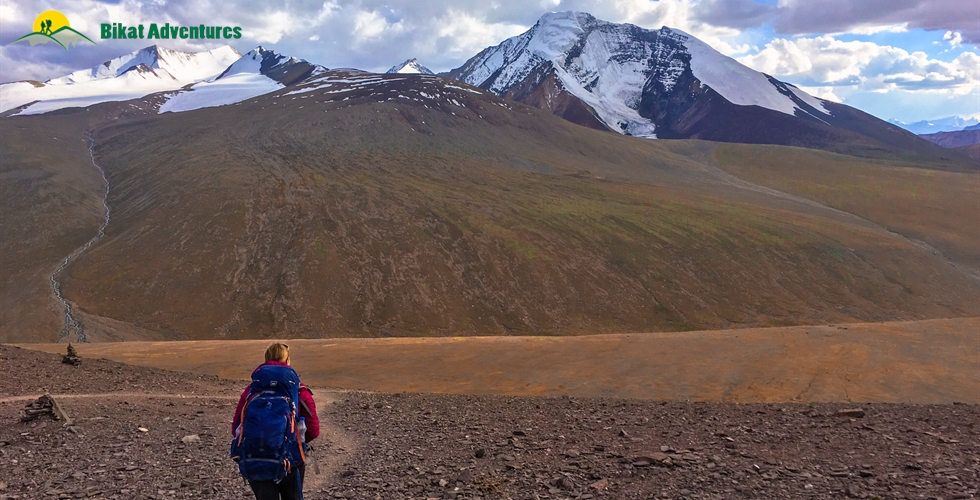
Markha Valley Trek
The Chadar 2.0
Available Batches
Brief description.
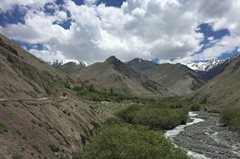
Brief Itinerary
Detailed itinerary.
Nimaling - Shangsumdo via Kongmaru La (7 hours). Drive to Leh
After a hearty breakfast, we will cross Kongmaru La (5200m), the highest pass on the trek, and from here we will have a wonderful view of the Indus Valley and Ladakh Range. The descent is quite steep, but will gradually level out as we enter Shang Gorge, with its fascinating rock formations. More river crossings bar our way before we arrive at the sour-spring of Chuskurmo (used in traditional medicine by the Amchi doctors). Drive from Sumdo to Leh takes about 2 hours. Reach Leh by evening. The trip ends here.
What's Included
- Camping/Homestay during the trek
- Trek Meals (Starting Lunch on Day 3 till Dinner on Day 9)
- Gaiter, Micro-spikes, and Helmet as required
- Trek Permissions Fee, if any (Upto the amount charged for Indian nationals)
- First aid medical kit including oxygen cylinder
- Experienced Guide and Support staff
- Transport from Leh to Road head and return
- Hotel/Guest House Stays in Leh (Day 1,2 & 9)
- Mountaineering course certified Trek Leader with First Aid certification
What's Not Included
- Meals in Leh
- Meals during road Journeys
- Any kind of personal expenses
- Any kind of Insurance
- Mules or porter to carry personal luggage
- Anything not specifically mentioned under the head Inclusions
- Inner Line Permit Fee
Are you Eligible for this Adventure?
Markha Valley Trek is a difficult trek. It is a high altitude trek in Ladakh region which requires climbing to the height of 5,200 meters making it perfect for someone with prior high-altitude trekking experience!
Max Altitude

BRS Level Required
Markha Valley Trek is a level 5 adventure on the Bikat Rating Scale.
This makes it mandatory for you to have high-altitude experience of preferably multiple treks marked at level 4 on the BRS. The altitude, the terrain and the nature of the climb demand a certain level of skill and a need for you to be aware of how your body reacts to the various features of a high altitude environment.
If you do not know what level of BRS trek would suit you best, worry not! Fill out this Form:

we will send you a progression chart to help you comfortably get out of your comfort zone in order to level up and ultimately reach your highest potential in the big, bad world of outdoor adventure.
Packing List
This is a list of essential items for individuals doing the trek with Bikat Adventures. This list contains only those items which the participants are required to bring with them. The list excludes those items which are provided by Bikat Adventures on the trek. We have divided the items into five categories. All the items in the list are essential except for those marked as optional.
Trekking Gear
- Ruck sack bag with rain cover. Qty -1
- Day Pack Bag - Recommended for treks with summit day
- Head Torch with spare Batteries. Qty -1
- U V protection sunglasses. Qty -1 Here is how you can choose the best sunglasses for trekking.
- Water Bottles: 2 bottles of 1 liter each
- Non-skid, deep treaded, high-ankle trekking shoes Qty -1
- Pair of light weight Slipper/Sandals Qty -1
- Quick Dry Warm lower or Track Pants. Qty - 2
- Full sleeves T-shirts/ Sweatshirts. 1 for every 2 days of trekking
- Pair of thick woolen socks. 1 pair for every two days of trekking
- Thermal Body warmer Upper & Lower. Qty-1
- Undergarments. Qty - 1 for every day of trekking
- Warm jacket closed at wrist & neck .Qty-1
- Full sleeves sweater. Qty -1
- Rain wear ( Jacket & Pants ) . Qty-1
- Pair of waterproof, warm gloves. Qty-1
- Woolen cap. Qty-1
- Sun shielding Hat. Qty -1
- Personal toiletries kit (Small Towel, Toilet paper, paper soap, Bar soap, toothbrush, toothpaste, cold cream, etc.)
- Sun screen lotion small pack. Qty -1 Here is your Sun Protection 101 to stay safe in the bright sunny outdoors.
- Lip Balm small pack. Qty-1
- Small size, Light weight & Leak proof lunch box. Qty-1
- Plate. Qty- 1
- Spoon.Qty-1
- Tea/Coffee (plastic) Mug.Qty-1
Miscellaneous
- Camera (Optional)
- Carry your medicines in plenty in case you have any specific ailment. Consult your doctor before joining the trek.
- Dry fruits, Nuts, Chocolate bars (Optional)
Frequently Asked Questions
Eligibility, is this adventure good for me, what’s a good fitness benchmark for this adventure, what skills do i need to complete this adventure, what is the minimum and maximum age limit, about the activity, where is it located, what are some of its highlights, what are some of its challenges, what is the best season for this, what is the accommodation type, what is the temperature like here, is it technically challenging, connectivity, how do i reach the starting point, is there cellular network available throughout, where is the nearest atm, if i choose to travel to the base with you, what is the pick-up point, what time is the drop-off on the last day, what are the nearby attractions that i can explore, equipment & gear, what equipment is provided to us, what can i rent from you, where will i receive the rented items, where do i have to return the rented items, what gear do i need to bring, are there local shops to rent/buy equipment, facilities & additional services, can i offload my bag, can i leave any extra luggage i carry at the base of this adventure, what are the meals like, what are the washroom/ toilet facilities like, what should i do if i get my period on this adventure, what are the medical facilities available to me on this adventure, are there any electricity charging points on this adventure, mandatory documents, what documents do i need to carry, do i need insurance for this, do i need a permit for this, certification, do you provide a certificate of completion, when and how will i get the certificate of completion, international travel, will i need a visa, when should i apply for the visa, what kinds of insurance do i need to travel here, what is the specialty of this when compared to other mountain ranges, till which month can i make a booking for this, what is the qualification of the outdoor leader provided to us, how do you choose your outdoor leaders, is it safe for women, what is the ratio of outdoor leader to participants, what do you do in case of an emergency, what are the rescue options on this adventure, how do you choose your equipment, can i attempt this adventure if i have a specific medical condition, sustainability, what kind of camping do you practice on your outdoor adventures, why are you against fixed camping in the outdoors, how do you manage overcrowding on certain trails, what are some things to remember when using a dry toilet, why should i avoid wet wipes in the outdoors, where should i dispose of my sanitary waste if i am on my period, why should i carry my own utensils on an outdoor adventure, booking process, what happens after i make the payment, do you create a whatsapp group of participants before the start date of the activity, do i need to submit a medical certificate, do i need to submit an undertaking form.
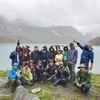
Small Group Size
Our batch sizes are capped at 15 for smaller treks with the trek leader and trekker ratio of 1:8. This ratio, in our years of experience, has proven to deliver the best trekking experience for individuals as well as groups. Capping the size of the group ensures individual attention to each trekker so that no signs of distress or need during the trek go unnoticed. It also helps to form a more cohesive cohort with better group energy which helps define the rhythm and pace of days on the trek. As you go higher up on the BRS scale, since the stakes are higher, expeditions have an even smaller group size with the ratio of expedition leader to climber set at 1:2.
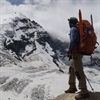
Qualified Trek Leaders
We follow a rigorous regime of hiring and training our experts in the field. Each trek leader is a certified mountaineer with years of experience in the field. In addition to their qualification, they also go through practical and situational training to tackle any and all kinds of sudden conditions that may present themselves on the ground. Being unpredictable is the core nature of the mountains but being ready for any circumstance as best as possible is a controllable asset that we try to nurture. Our field experts are also trained in basic medicine and first-aid response. Watch: Forerunners - The Making of A Trek Leader At Bikat Adventures
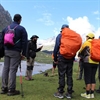
Guided Progression
Since Bikat Adventures is a learning-based organization, we help you climb up the ladder of difficulty within the sphere of outdoor adventure systematically. Our on-ground training modules are designed to handhold you through the upskilling process so that you are ready to take on bigger challenges.
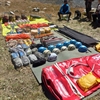
Equipment Quality and Check
All the gear used on our treks and expeditions is tried and tested, maintained for good quality, and is overall top-notch in quality and condition. We are continually looking to obtain the best of everything there is in the market so as to ensure optimum safety.
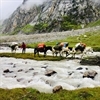
Support Systems
Along with the staff you see on-ground, we have a team of superheroes working in the background to give you the best experience possible. Our background team also comprises local staff from each area who know the region best. Having local support helps with studying the area, pre-planning, execution, and in receiving timely support in case of emergencies in these remote locations.
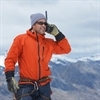
Communication
Our on-field staff is in constant contact with our teams based in primary locations so as to eliminate any avoidable delay in reaching additional help and support when required. We try to use the best tools for communication available, including satellite phones, in regions where they are not restricted.
What our customers Say

Cancellation Policy
Cash refund
Cancellations up to 30 days prior to departure date
5% deduction
Cancellations between 30 days to 15 days prior to departure date
50% deduction
Cancellations within 15 days prior to departure date
Voucher refund
Cancellations up to 5 days prior to departure date
No Deduction
Cancellations within 5 days prior to departure date
- Cash refund is applicable only in case of bookings made without using any promotional offer code or vouchers
- This is only a brief of cancellation terms. For finer details please refer Detailed Cancellation Policy.
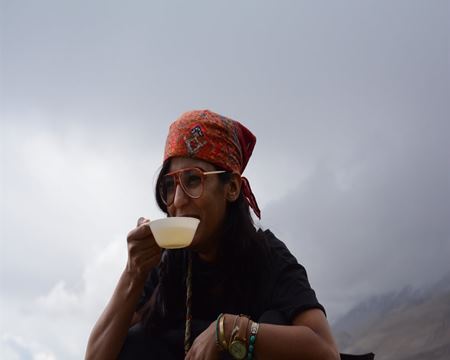
Subscribe for latest updates & offers
Similar adventures.
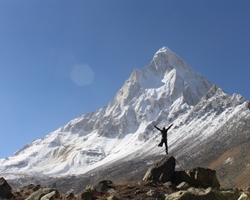
Vasuki Tal Trek
The closest one can get to mt shivling on a trek.
Uttarakhand
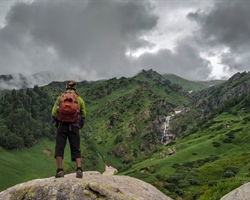
Kalihani Pass Trek
A challenging and off-beat gem of himachal.
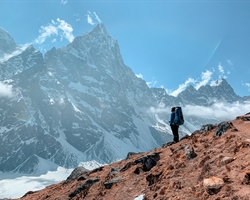
Everest Base Camp Trek
Walk where the legends walked., enter your email, events by categories.

Mountaineering

Scuba Diving
Events by months.
- January July
- February August
- March September
- April October
- May November
- June December
Events By Nights
- 5 & More Night
- Environmental Policy
- Privacy Policy
- Term & Conditions
- Work With Us
- Address: 303, 3rd Floor, Tower B4, Spaze Itech Park, Sector 49. Gurgaon
- Pre Sale - 7838148127 , Post Sale - 8588878499, 9667639126
Bikat Adventures
- Cancellation & Refunds
- Content Sharing
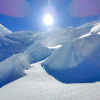
© 2024 Bikat Adventures - All Rights Reserved
Powered by: novel knett software solutions, submit enquiry.

Markha Valley Trek
Get a free quote.
Leh – Chilling – Skiu – Markha - Hankar – Nimaling – Shangsumdo – Leh - Pangong - Delhi
The Markha Valley Trek is a 9-day adventure through the scenic landscapes of Ladakh and Zanskar ranges, starting and ending in Leh. This popular trek proceeds on a moderately difficult route and covers key locations such as Chilling, Skiu, Markha, Hankar, and Nimaling. The main highlights of this Markha Valley trek tour include crossing high-altitude passes like Gandala and Kangmaru, camping in picturesque villages, and witnessing stunning views of the Stok Kangri massif. The journey offers cultural experiences and natural beauty, including visits to remote monasteries and encounters with local wildlife. Undoubtedly, this trekking expedition is full of surprises and worth every effort that goes into it.
With our Ladakh tour package, you can transfer all your travel planning burdens to us! Our skilled team at Leh Ladakh India will curate the best itinerary and travel options for your Ladakh tour. Enjoy a hassle-free experience and focus solely on the wonders of Ladakh.
Trip Highlights
Itinerary Detail
Arrive at the Kushok Bakula Rimpochee Airport in Leh and meet our tour representative, who’ll greet you and assist you in getting to the pre-booked hotel. After your check-in at the hotel, spend the rest of the day relaxing and acclimatizing. You will be at 3,500 m above sea level, with thin air and less pressure. So you just need to rest so that your body will acclimate according to the weather and altitude. Drink a lot of water as it will help your body to get more oxygen. You can explore the market in the evening.
Overnight stay at the hotel in Leh.
On day 2 of the Markha Valley Trek tour, enjoy sightseeing of Leh and get acclimatized. After breakfast, you will head towards the Shanti Stupa, a white dome structure dedicated to Buddhism. From the Stupa, you can enjoy panoramic views of Leh as the monument is perched on a hilltop at a dizzying height of 11,841 feet above sea level. Leh Palace is another stopover of the day, one of the tallest buildings of its time, with nine stories in all. From the top of the palace, one can enjoy the picturesque view of the city and the Stok Kangri and Zanskar ranges.
In the evening, you will visit the local market in Leh. The vibrant aura of the local market will make you fall in love with the place. You can buy antiques from here. After the sightseeing tour, return to the hotel.
You will start your day early, and after having breakfast, you will leave for Chilling, where you will start your trek. First, you must ascend the Ganda La (4,985 m), which will be tiring, so you must stroll. Enjoy the spectacular views of the Stok Kangri massif and surrounding valleys. After descending from here, you will reach a tiny hamlet called Shingo. Have your lunch here and then head towards the Skiu village. The path from Shingo to Skiu is easy and surrounded by several small streams. Skiu is located in the lower Markha valley at an altitude of 3,400 m. The Markha Valley is relatively narrow, and the temperature at night will be pretty high.
Overnight stay at the camp in Skiu.
Start for Markha village on the 4th day of the trip. Cross the river and trek up to Markha village, the longest valley. This day will be the longest trek day. The beautiful green fields and irrigation canals can be seen on the way. It is worth walking along the trail where the Skiu Nala meets the Markha to visit the small monastery.
Enjoy an overnight stay here.
On the 5th day of the tour, you will walk alongside the river, and the woody bushes will grow thickly along the river. You have to cross several bridges over which the trail marches towards the Thinlespa Village and further to the Hankar village, from where you can get the enchanting views of the Gyalpo-Ri Peak. Enjoy the dinner at Hankar and enjoy the majestic beauty of the valley.
Night halt in tents.
On the 6th day of the trip, after having breakfast, you will head towards the Nimaling. You must climb steadily on this day through the narrow valleys and villages. The Nimaling Plain is a broad undulating meadow that slopes upwards to the base of the ice-clad Kang Yatse Peak (6,440 m). Nimaling is surrounded by ponds and streams that provide grassland to many animals, namely Yaks, Sheep, Goats, Horses, and Dzo. You can also spot occasional blue sheep and wolves here.
Overnight stay at the Nimaling.
On the last day of the trek, you will start climbing the Kangmaru Pass and enjoy the panoramic views from the top. The snow-laden peaks in every direction, and you can see the massive Karakoram Range on a clear day, including the K2. From there, you will start descending, and the trail will be steep towards the Martselang Valley past the Sulphur Springs of Chyushkarmo. Follow the Martselang stream to the village of Shangsumdo. The town is situated at the confluence of Shang Nala and Mastselang. From Shangsumdo, you will get an assisted transfer to the hotel in Leh.
After breakfast, you will leave for Pangong Lake, 200 km from Leh. On your way to Pangong, enjoy the astonishing views of the beautiful valley. The emerald-colored lake is situated at an altitude of 4,350 m and extends from India to Tibet. The lake changes its color from azure to blue to green to grey. Soak in the enchanting beauty of this lake and spend some time in the tranquil surroundings.
Later, return to Leh in the evening. Overnight stay at the hotel in Leh.
This is the last day of your Markha Valley Trek tour package. After a delicious breakfast, check out of the hotel and leave for the airport in the morning for your homebound flight from Leh Airport.

- Cultural Trips
- Wildlife Expeditions
- Destinations
- Outdoor Programs
- Discover trekking
- Health and fitness
- Experiential learning
- Trekking tips
- Outdoor skills
- Trekking gear
Markha Valley Trek Best Time | Weather and Temperature Guide
The best time to visit Markha Valley trek is from May to August. The trail starts attracting trekkers from across the world in mid-May. These months have pleasant weather and mild temperatures.
As summer arrives in the valley, the villages at lower altitudes adorn bright shades of green. The lush green paddy fields amidst the arid desert, surrounded by towering mountains, present a breathtaking sight during the Markha Valley trek in summer.
Summer colours fade from the trail by August, and autumn hues take over. If you prefer fewer people on the trail, trek to Markha Valley in September. The trekking season concludes as September ends.
Avoid the winter months of December to February, as heavy snowfall makes it challenging to navigate the trail.
Markha Valley Trek in Summer (May to August)
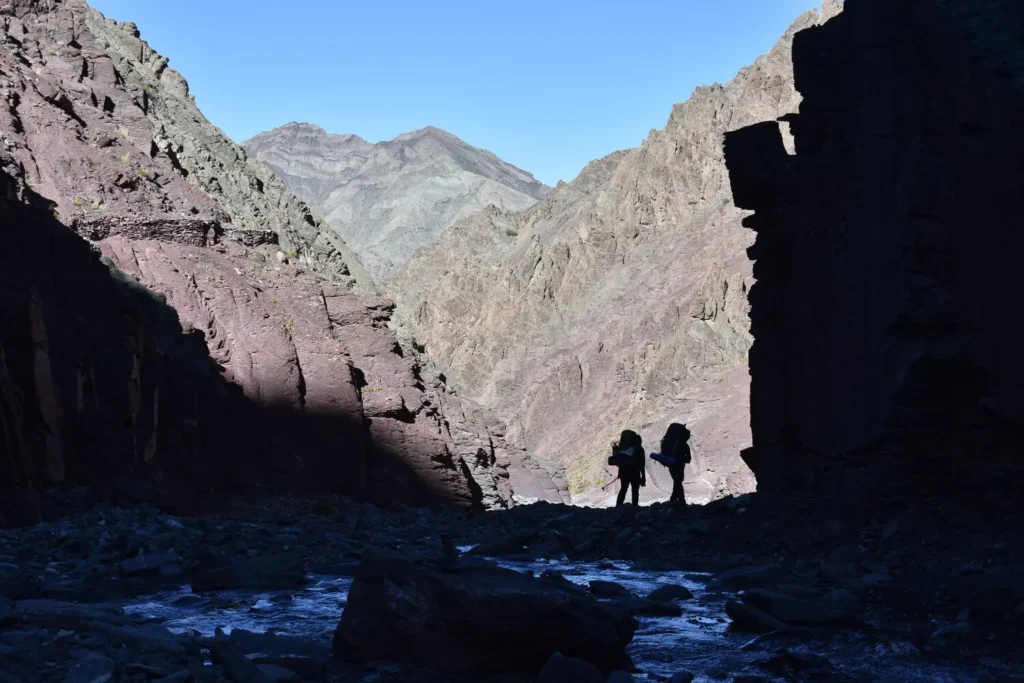
Ladakh witnesses summer from May to August. These months are considered the best time to visit Markha Valley trek in Ladakh. Weather remains clear, and you will have warm sunny days and moderate temperatures. Summer in Ladakh is the best time to explore the higher reaches where Markha Valley is located.
June to August is the peak season in Markha Valley. The trail receives a high number of trekkers during these months compared to other months.
Markha Valley Trek in May
Planning the Markha Valley trek in May saves you from biting cold and harsh winter temperatures. Clear and dry weather makes your trek comfortable.
During this season, the villages along the trail come to life. You witness contrasting landscapes in the villages. The traditional Ladakhi house, with a lush green field guarded by an arid mountain desert, is a sight to behold.
Markha Valley Trek in June
The clear and sunny days let you indulge in the stunning views of Stok Kangri and Kang Yatse peaks in June. The Kongmarula Pass at an altitude of 17,060ft. has remains of winter snow. The weather is usually cold and windy at the Pass.
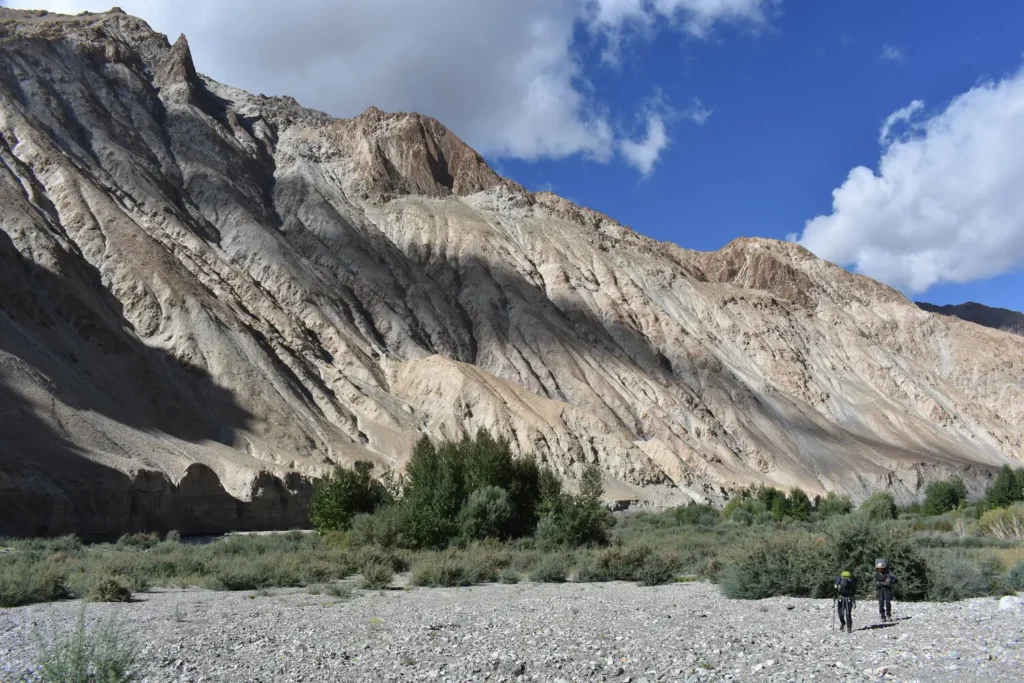
Markha Valley Trek in July
Markha Valley experiences mild showers in the afternoon. July offers the raw beauty of Ladakhi villages as you traverse the highlands of Ladakh. Patches of green fields turn the brightest during this month.
Markha Valley Trek in August
August offers breathtaking landscapes of Ladakh. It is also a perfect time to enjoy the rare flora and fauna on Markha Valley trail.
Markha Valley Trek in Autumn
Embarking on a trek to Markha Valley in Ladakh is ideal during autumn. Breathtaking landscapes and a suitable climate make autumn perfect for experiencing Markha Valley.
Markha Valley in August
Markha Valley trek remains dry, with low precipitation and little or no rain in August. August is the most suitable time to embark on this picturesque and culturally enriching trek. Warm and mild weather, clear blue skies, and stunning views of the mountain ranges make August the most favoured month to explore the valleys of the highlands in Ladakh.
Markha Valley in September
September is the perfect time to indulge in autumn hues. The paddy fields change the colour, and the mountain ranges appear crisp and clear. Markha Valley trek traverses the Hemis National Park, offering a rare opportunity to encounter the diverse Himalayan flora and fauna in September.
Trekking to Markha Valley between October and November is not the best option. However, weather conditions are unpredictable and the climate is not appropriate for trekking.
Markha Valley Trek Weather and Temperature
Markha Valley trek experiences pleasant weather in the summer months. May to September feature mild temperatures appropriate for trekking. While days are warm and sunny, the mercury level drops at night thereby increasing the cold.
Markha Valley Trek Weather in Summer
The Markha Valley temperature is mild and comfortable during the summer months of May to July. Markha Valley weather is dry and sunny in summer. Some days will be hot as the sun is stronger in the valley at lower altitudes. Night temperature is frigid and it further drops depending on the altitude.
Ladakh is a high-altitude desert. The region remains unhindered by the monsoon rains as high mountains restrict the rain clouds. However, the weather is unpredictable in the mountains, so expect mild and moderate showers. Come prepared with rain gear to deal with unpredictable mountain weather.
Markha Valley trek temperatures remain moderate, touching a maximum of 24°C. The nights and early mornings are chilly and drop to sub-zero as you gain altitude. Prepare for fluctuations in temperature and carry enough layers to keep yourself warm on the trek.
Markha Valley Trek Weather in Autumn
As you advance towards September, the temperature drops further. Weather conditions become extreme. As Ladakh is a cold desert, the temperature becomes unbearable, and exploring Markha Valley trek becomes challenging.
You can consider trekking to Markha Valley in September. However, be prepared to deal with freezing cold and unpredictable.
Markha Valley Trek Highlights
Markha Valley is one of the most popular treks in Ladakh that passes through picturesque villages to reach the summit at Kongmaru La. The trek in the cold desert of Ladakh is known among adventure lovers for its majestic view of Mt KangYatse, Stok Kangri peaks, Ladakh, and Zanskar ranges. Markha Valley trek surprises you with the exquisite beauty of its unique landscapes after every climb.
The Markha Valley Trek does not limit itself to a single experience but gives you glimpses of unique Ladakhi culture, the humble life of villagers, and exotic Himalayan wildlife. However, the highlight of the Markha Valley trek is witnessing the pristine Kang Yatse peak (6,400) atop the Kongmorula Pass at 17,000 ft.
The trek takes eight days to complete, including travel to and from the base camp, Leh. Although the trail is moderate, climbing to the high-altitude pass is taxing. You will cover 70km and need to be physically fit to embark on this thrilling trek.
Leave a Reply Cancel Reply
Save my name, email, and website in this browser for the next time I comment.
Related Tours
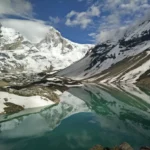
Kedartal Trek
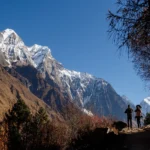
Manaslu Circuit Trek

Annapurna Circuit Trek
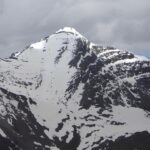
Stok Kangri Trek

Sar Pass Trek
You will receive an email containing a link allowing you to reset your password to a new preferred one.
Verification mail has been sent.
Please check your mail to verify your account.
Click Here to Login
- How To Reach
- Dates & Price

33°57'24.6"N 77°17'52.6"E
Markha Valley Trek

Pickup Point
Leh Airport, India
Minimum Age
- Markha Valley trek offers a striking contrast of trekking in a dry cold desert valley while providing beautiful views of Ladakh & Zanskar ranges, the 21,000 ft Kang Yissay and the 20,086 ft Stok Kangri peaks.
- The Markha Valley trek goes inside the beautiful Hemis National Park and involves two pass crossings- Gandala La (15748 ft) and Kongmaru La (17,060 ft).
- Some exciting waist-deep river crossing sections on Markha River to trails going across interesting Buddhist villages and rocky canyons are some of the features that give this trek a unique fervor.
- With close proximity to Leh, which is one flight away from most Indian metropolitan cities, Markha Valley Trek can be something any experienced traveler to Leh should definitely consider doing.
The Markha Valley Trek is one of the most astounding and well-known treks in the Ladakh region of India. Located in the northwestern part of India, the Ladakh region is famed for its savagery and uneaten beauty. The trek follows a remarkable high valley with excellent views across the mountain region and is one of the best ways to experience the unique culture of the High Himalaya region. The Markha Valley trek goes long with the Markha River downstream taking in several high passes including Ganda La (15748 ft) and Kongmaru La (17,060 ft). From both passes, you get grand views across the landscape with the tall peaks of Kang Yatse and the Stok Kangri (20,086 ft) coming into sight. Not only is the trek one of mountain beauty, but it also takes trekkers through an outlook of ancient farming with many green irrigated fields and local villages being passed along the way. You'll also encounter several monasteries and meet the shiny dressed monks as they go about their daily lives. You will be open to several waist-deep river crossings, high rocky canyons, and tour many Buddhists villages en-route.
Quite less are aware of the dryer and barren side of this heavenly place. The most desired adventure hub Leh, popular for its raw and arid thrills, is a gateway to the burned-out trails. With Markha Valley trek one gets to redeem the dry region of mighty Kashmir. The mysterious ride of 9 days, exhibiting lush green to yellow barren landscapes, passing alongside Indus river, will stay in mind for your lifetime.
Markha Valley is the largest valley of the Ladakh region. Leh is the starting point of this trek, which is an added advantage to explore the Buddhist monuments in Leh. You will be astonished to traverse through the tiny hamlets as you gain altitude. Surprisingly, these villages host cafes or tea houses serving rejuvenating hot drinks when you are tired from the strenuous hike. One after another, Rumbak, Yurutse, Skiu, Markha, Hankar, Nimaling settlements will revitalize you. Not only that most of the villages have preserved monasteries, ruined forts, and temples. One of them, the Tacha monastery is a beautiful and heart catcher that lies between the mountains.
Though the trek goes through dry regions the Indus, Markha and numerous streams will come your way. Since the trail goes through Hemis National Park, all its treasured fauna, mountain sheep, Argali, rabbits, snow leopards can be spotted at every camping site. Ganda La and Kongmaru La are the two cardinal passes to be crossed en route. These passes are known for the panoramic views of infinite Karakoram and Ladakh ranges. The amazing view of K2 mountain, Stok Kangri and Kang Yatse peaks are fulfilling and the motivation of this trek. On limpid days one can get to see faraway Tibet region. A small trek ahead of Markha Valley and you will get to the base of Kang Yatse peaks. The trail is of easy to moderate grade with 1-2 steep sections, is recommended to all age groups. This is not one of those typical treks that retrace the same path while descending. Therefore, you get a wider and non-repetitive insight into Ladakhi Himalayas. Each day reveals mesmerizing views concealed behind the mountains.
Best Time to Visit
The best time to visit Markha Valley trek is between June and mid-October. During this time, the weather is Ladakh is pleasant and the average temperature ranges between 20 - 30�?�°C in the daytime. July and August are the best months for Markha Valley trek as during these months Manali-Leh and Srinagar-Leh highways also open for private vehicles.
Brief Itinerary
Detailed itinerary, day 1 : arrive in leh.
Arrive in Leh and rest to acclimatize in the thin air of Leh. Spend your day at Leh. If you like, you can visit ancient monasteries, palaces, and museums that the place is famous for. Drop by Shey, Thiksey Gompa, and Stok Gompa. Being in the same destination will assist in getting acclimatize well for high altitudes. Towards the evening, you can enjoy a hike to Leh palace. The rest of the evening will be spent on relaxation.
Day 2 : Acclimatization in Leh
Day 3 : drive from leh to chilling and trek to skiu.
Start early in the day towards the Base camp of Ganda La which is a steep gradient involving an hour-long hike. As you move up the valley to the base camp, look for the peak of Stok Kangri looming behind you. Look for the usual prayer flags as you reach the lower base camp of Ganda La at an altitude of 14,272 feet. A further 30 minutes or 1 km will bring you to the high base camp of Ganda La. Enroute you may sight Blue Sheep, Marmot, and Argali roaming the land freely. The Ganda La Pass is a further 1 km up in the valley where the elusive Snow Leopard resides, though sighting one will be rare. At the top of Ganda la pass, you get a grand view down to Zinchen Gorge and Stok Mountains and towards the Skiu side of the valley. The contrast in the landscape on both sides is incredible. The trail is well defined, zig-zags all the way up to the pass. Keep your ears well protected as it is extremely windy. As you pitch down to Skiu, observe the terrain intensifies becomes rocky in nature. This pass crossing section can be hard for trekkers as one may experience headaches, nausea, etc. Ensure you do not hike too fast as the variance in height gained and lost is significant for the day. Carry plenty of water as the quality of water is not that good on way till Shingo. A water filter can help you here.
After two hours of difficult descent, you will reach a settlement named Shingo (13,615 feet). The last section of the Markha Valley for the day until Skiu takes around 3 to 4 hours. The dusty trail undergoes a yellow-colored valley. From Shingo lookout for a trail heading south towards the village field from where you take a logical trail moving towards your left. This trail enters into a narrow gorge with an abundance of wild roses that bloom in the months of July-August.
The trail is well established all the way till Skiu. Expect to cross Shingo Nallah three to four times on the way to Skiu. All this while, the trail is descending down crossing the stream on stepping stones. The bottom of the gorge is full of willow and Sea buckthorn providing much-needed shade from the sun. 1.5 km before the end of the gorge, the stream disappears and you reach Skiu. You have just entered Markha Valley. Observe Markha River coming down from Chilling. This is the point from where Stok Valley blends with Markha Valley. We camp overnight at Skiu.
Day 4 : Skiu To Markha
Today is a moderate day for trekking with very little altitude gain/loss though there is a lot of distance to cover. From Skiu, start eastwards towards the Markha Valley. Walk along with the Markha River with mountains on both sides. The trail for the day is a comparatively level walk over the river bed, side trails along the river with few parts where you have to climb up and down due to broken down trails in few sections. Walk beside the river for 2 km till you reach a bridge section. Do not cross over but stay on the route along the river. The trail from here has few washout sections requiring you to climb, few meters up and down to pass the broken section of the trail. The trail to Chalak village from here goes through a bridge crossing towards your left and a further 2 km Markha Valley to reach a clearing known as Narding go around with a 3km walk up the valley to a spot called Sara.
Another one km and you reach a bridge crossing section. Cross the bridge and return back to the right side of the river. Observe cultivated Barley fields ahead. You have reached Chalak. We rest at Chalak village and have lunch. It takes around 4 hours to reach Chalak from Skiu. From Chalak the trail ascends slowly as you pass by a trail marked with Bharal horn for directions. Observe chortens and mani walls set high above the river throughout the way. After 2 to 3 km the valley comes up and a river junction takes you to Markha Village. Let the guide decide the best spot for the river crossing. You may find the height of water to be femur high. The water is icy cold so better to take off your shoes and socks and pull up your pants. Once you cross over, Markha Valley for a couple of kilometers till you see a final bridge crossing. As you cross over the bridge you approach Markha -the biggest village in the area, where we camp for the night.
Day 5 : Markha To Hankar
oday is another moderate day for trekking. Follow the trail from Markha village alongside Markha River, remaining at the right side. Ignore a wooden plank bridge. After 2 km you reach the intersection where a path from Zanskar meets up. Look for suitable spots to cross over Markha River. You will be required to cross over at least twice. Consult a local in Markha or leave it to the experience of your guide to making this decision. After the second river crossing, it is a 2-hour hike up to Umlung. Look out for the Umlung Gompa and cross over from its base to reach Umlung. You can get a breathtaking view of Mt. Kang Yissay as you climb up from Umlung towards Tacha and Hankar. After 2 hours, skirting up a gorge, you reach an old village named Hankar. A km past Hankar the trail breaks into two. One going to Thochuntse and the other to Zalung karpo La. Continue on the trail going along the branch takes you to Thochuntse which is another 1 km ahead.
Day 6 : Hankar To Nimaling
It’s a shorter 6 km trek to Nimaling. 15 minutes from the Thotchuntse campsite, the trail forks. Take the trail to the left. After 1 hour climb, the landscape is smoother, curvier. The climb becomes gradual. After one hour into the climb, leads you to a pond where you can fill water. A distant walk on a grassy meadow leads you to Nimaling. You see effusive streams on your left with a glacier backing the Kang Yatse and to the right is the Kang Yatse peak. The campsite of Nimaling is in a broad valley and is completely exposed to strong winds. When it snows, the green of the valley turns to an absolute white carpet glittering with snow. Camp overnight at Nimaling.
Day 7 : Nimaling To Chokdo via Kongmaru La And Drive To Leh
Today is a difficult day due to the highest altitude pass crossing of the Markha Valley. From Nimaling look ahead towards Kongmaru la Pass. Cross a stream part and continue towards the north climbing a long face of a ridge leading to Kongmaru la Pass. The hike from Nimaling to Kongmaru la pass takes around 2 hours and is a steep incline hike. At the top of the pass, you will get a great view of Indus valley and Ladakh ranges. You can also see a wide array of wildflowers on the slope leading to the pass. You also get a mobile signal of the BSNL network here. The downhill descent from the pass to Sumdo is brutal. The terrain is rocky and drops down steeply as you enter into a narrow canyon after trekking down 2 to 3 km.
The canyon has a typical landscape one is accustomed to seeing in Ladakh. The brown and reddish rocks on both sides allow not more than 2 to 3 people to pass at a time. After 2 hours of hiking the canyon widens up till you reach Sukarno. The hike from Sukarmo to Shang Sumdo is a long one with a major part on a dry river bed. After an hour of walking on the river bed, you come to a section running along a small hill. The trail here is descending consistently. The last section involves an hour of level walks to reach Sumdo along the same river. Sumdo is a small village with tea shops and parachute tents. Take a cab from Sumdo to Leh which is 8 km on the highway road. You can also Markha Valley to Hemis to visit the Hemis Monasteries. This is a 2 hour Markha Valley from Sumdo. From Sumdo, it takes about 2-3 hours to reach Leh.
We will arrange a cab for you from the pickup point in Leh which will be the Airport, the charges for the same are not included in the package. For communications purposes, we will create a Whatsapp Group before the departure date of the trek and will share the details regarding the transportation. The drop at Leh Airport after the trek will be arranged in a similar way.
How to reach Markha Valley Trek Starting Point ( Leh ) :
By Air
The Kushok Bakula Rimpochee Airport in Leh is the highest airport in India. You can get daily flights to Leh from most of the cities in India. Frequent flights ply from Delhi, Mumbai, Bangalore, Chennai, and Kolkata. Standing at an elevation of 11,150 feet, Leh is one of the highest cities in India.
The nearest major railway station is the Jammu Tawi railway station which directly connects major cities of India like New Delhi, Mumbai, Chennai, Bangalore, Kolkata and many more. It is the most convenient stop, from where frequent buses and cabs are available.
You can use either the Manali-Leh highway or Srinagar-Leh highway if you wish to travel by road. The Srinagar-Leh highway is more preferable than the Manali-Leh highway.
Latest Stories
Why trek with us .
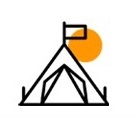
Trek Calendar All
Get yourself fit, nutrition tips, things to take, health & safety.
- Accommodations at Trek: All accommodations on the trek will be on twin sharing basis in Tents or Homestays. Any accommodation in a hotel/guest house/hostel will be in a budget hotel.
- Guides: An experienced guide will accompany you for the trek. The team will have years of experience and well equipped for any emergency situation.
- Services of a Professional Trekking Team: A team of an experienced Cook, Camp Staff, Porters/Mules will accompany you for all the arrangements on the trek .
- Meals: All Meals on the Trek are included. We will serve Vegetarian Indian food on the trek which will be cooked by our high altitude chefs. It will be a five-course meal plan.
- Camping and Safety Equipment: All the camping equipment such as Tents, Sleeping bags, Toilet Tents, Dining Tent, Mattresses, and other things will be provided by us and we guarantee the quality. Safety Equipment including Medical kit, Oxygen Cylinder, Oximeter, Crampons & Gaiters(if required) will be provided by us. We recommend you to bring your own sleeping bags if possible.
- Trek Permits and Forest Camping Charges: Only for Indian Clients, All the applicable trekking permits, Camping Charges, Forest Entry Fee, etc will be paid by us. Foreigners have to pay these charges if not mentioned.
- A Life-Changing Experience: We assure you that by trekking in the Himalayas you will have a life-changing experience and we will do everything we can to provide you with the best services and make your venture in the wild an unforgettable one.
Note: Prior to booking any adventure with Trekmunk, it will be mandatory to sign the waiver form and get a medical certificate from a doctor in due time, without these, you will not be allowed to start the trek. All this will be done online without using any paper.
- GST and Other Taxes: The goods and services tax is not included in the price mentioned with the trek. They are subjected to change according to the government rules of India.
- Food in Leh: Food in Leh is not included in the package. You can dine anywhere in Leh city, we can recommend a few good options.
- Flights and Transportation: Flights or other means of transport are not included in the package. Transportation from Home city to Leh and Leh to Home city is not included in the package. Any expenses occurred during the journey are not included in the package cost.
- Personal Equipment: Your Rucksack, personal clothing, shoes, trek poles, and other personal trekking gear is not included in this package. You have to bring your own gear according to the weather and difficulty of the trek.
- Portage of Personal Bags(Offloading): We highly advise you to carry your own burden (your rucksack) but due to any reason, if you wish to not carry your rucksack, we can arrange for a porter/mule to carry it. For this service, you will be charged over and above the trek cost. The charges for offloading vary with every trek.
- Travel Insurance: Travel Insurance is not included in this package. We recommend you to have travel insurance before opting for such adventures. You can buy insurance from us while booking the trek, it is optional.
- Personal Expenses: Any personal expenses incurred (Laundry, Bottled Water, Beverages, Snacks, Orders at tea houses or dhabas, Tips for guides, Camera fees, etc) are not included in the package.
- Emergency Expenses: Any costs arising out of unforeseen circumstances such as accidents, bad weather, landslides, road conditions and any other circumstances beyond our control are not included in the package.
- Anything not mentioned in Inclusions of the package.
Cancellation Policy And More Information
Booking Terms:
1. Confirmation Policy :
Upon Booking, An invoice will be sent to your mail & within 12 to 24 hours the booking confirmation with additional details will be sent to your mail.
2. Cancellation Policy:
Note: Following Cancellation policy will be followed for departures booked on or before 31st May 2021-
1) Cancellation up to 7 days before the start date of the trek: Get a complete cash refund (minus 5% transaction fee). The money is refunded to the same bank account, credit, or debit card from where the payment was made.
2) Cancellation during the last 6 days before the start date of the trek, and not counting the day of the trek: Full refund with 100% of the trek fee in the form of a Trekmunk Trek Voucher. Valid for 1 year from the date of issue. Can be used on any Trekmunk trek.
3) Cancellation on the start day of the trek, or no show on the start day of the trek : Unfortunately, no refund.
For more details, go to https://www.trekmunk.com/cancellation-policy
3. Refund Policy:
Any refund applicable will be processed within 10 to 15 business days as per the company policy.
4. Postpone/Transfer of a booked trek:
1. You can postpone your booked trek for a period of two months (61 days) but we will charge a 20% processing fee. The last date for the postponement will be 15 days before the start of the trek. Failing to book the slot in 2 months (61 days) time, would be considered a cancellation with no refund of any kind. Postpone of a booked trek can only be done once.
2. You can transfer your booked slot for the trek to any fit person till 15 days before the trek. You just have to mail us the request and rest we will handle. The new person has to get all the mandatory documents duly signed for the trek.
More Information:
1. We Trek for a Cause : For overall development of the areas we run our operations in, we donate Rs 100/- per booking from our profits which are used for the upliftment of the local people and conserving nature. We have named this initiative as - Trek for a Cause. For more details, follow: https://www.trekmunk.com/trek-for-a-cause
2. We are paperless : We are focusing on Sustainable Tourism and to do that we are trying all measures to convert our trek operations to be Eco-Friendly. Going Paperless is one step closer to our aim.
3. Single-Use Plastic : Trekmunk does not encourage the use of single-use plastic items. We are ensuring that our team is working together to reduce the problem and educate those around them. We will send you instructions on how to go plastic-free on your adventures.
4. Preparing for your Holiday : Getting some additional exercise makes a lot of sense to spend time before coming on a trekking adventure. The fitter you are, the more enjoyable you will find the experience. Hiking in the hill country is the best training but jogging, squash and swimming are also good for developing cardiovascular fitness and stamina. To read more on how to get fit, follow: https://www.trekmunk.com/get-fit-for-trek
5. Electricity Supply & Plug : You will get electricity supply till the starting point of the trek. If not Indian, We recommend you check if you require an adaptor for your electrical items at: http://www.worldstandards.eu/electricity/plugs-and-sockets/
6. Currency: The unit of currency in India is the Indian Rupees.
7. Health & Vaccinations:
Severe Allergies : If you have a severe allergy please inform the Trekmunk office before you travel. We will do all we can to help, but we cannot guarantee an allergy-free environment on trekmunk trips. You will need to carry your own treatment for the allergy with you, as 'adrenaline auto-injectors' are not carried as standard by our leaders and staff. You should inform your leader on the arrival of your allergy, and let them know where you keep your adrenaline pen.
Vaccinations : You should contact your doctor or travel clinic to check whether you require any specific vaccinations or other preventive measures. You should be up to date with routine courses and boosters as recommended e.g. diphtheria-tetanus-polio and measles-mumps-rubella, along with hepatitis A and typhoid. Malarial prophylaxis is not usually required for trips in the mountains, however, if you are visiting rural and remote low lying areas then they might be necessary.
8. Passport & Visas/Identity Proofs : If foreigner, Validity for 6 months, should have blank pages, and should be kept with yourself all the time.
9. Water : If you are on a trekking or cycling holiday, water is supplied to fill up your individual bottles. This will be boiled or filtered. Additionally, you should take purification tablets or a filter bottle (such as a LifeStraw, Sawyer Filter) to treat your water when in towns or where water is not supplied. We do not encourage the purchasing of single-use plastic bottles.
10. Altitude : This adventure involves going to a very high altitude. This is not something that you should worry about; the human body is quite capable of adapting to a very wide range of altitudes, but it is important that we follow some simple rules in order to acclimatize successfully. We will send you the information in your mailbox about Acute Mountain Sickness and trekking in high altitudes. On this trip, we carry bottled oxygen for use in emergencies.
11. Guidance on Tipping : Tipping is the accepted way of saying thank you for good service. Normally the guide and any other trek staff are given their tips at the end of the trek and this is best done as a group. The main guide will make sure that the tip is appropriately distributed among all the staff members on the trek.
12. Spending/Emergency Money : Approximately Rs. 8000-10000/- (in Indian Currency)should be carried for miscellaneous expenses including porter and trek crew tips, drinks, soft drinks, etc. We recommend that you carry your travel money in the form of cash as the availability of ATM is less in these remote areas. This can also serve as your emergency spending money.
13. Travel Insurance : It is recommended to have travel insurance for these kinds of adventures. When taking out insurance please ensure the policy you choose covers you for the activities and altitude included in your itinerary. We will ask for the Travel Insurance Details over a mail. Indians can buy insurance from us while booking the trek.
I and my friends went to Markha Valley trek with Trekmunk and we all had a great time. Walking up and down the hill, coming across some beautiful sites was mesmerizing. Staying in tents was so much fun. And our guide had all the knowledge about the trek. Trekmunk is really good w ...
I had an amazing trek with Trekmunk to Sandakphu November and December 2019. From the first moment of inquiry about the trek and all my questions were answered clearly and on time thanks to Dheeraj who managed to facilitate the trek quite well with his communication. Our guide Ar ...
I chose (after a lot of research) Trekmunk for my first trek - The Hampta Pass and Chandratal Trek. And I am so really glad I did so. The trekker needs to only focus on the trek and the beautiful landscape around him/her. The rest of everything is taken care of by Trekmunk from d ...
I and my friends went to Markha Valley trek with Trekmunk and we all had a great time. Walking up and down the hill, coming across some beautiful sites was mesmerizing. Staying in tents was so much fun. And our guide had all the knowledge about the trek. Trekmunk is really good with its food and accommodation facilities. I highly recommend Trekmunk. Kudos to their Team.
I had an amazing trek with Trekmunk to Sandakphu November and December 2019. From the first moment of inquiry about the trek and all my questions were answered clearly and on time thanks to Dheeraj who managed to facilitate the trek quite well with his communication. Our guide Arpan was very experienced, calm, patient and very helpful to each trekker's needs in the group. He facilitated to find and hire a porter for me once I needed one although we were in the middle of the trail. He also arranged emergency transportation when I had to cut the trek and go back home for an urgent matter. I really enjoyed their service and I would like to repeat the same trek or try other treks with them again.
I chose (after a lot of research) Trekmunk for my first trek - The Hampta Pass and Chandratal Trek. And I am so really glad I did so. The trekker needs to only focus on the trek and the beautiful landscape around him/her. The rest of everything is taken care of by Trekmunk from day 1 till the end of the trek. Scrupulously managed logistics; no compromise on safety and security; experienced, intelligent and knowledgeable trek leaders; scrumptious meals; contingency and backup plans; etc. make Trekmunk an ideal choice to go trekking with. My trek was lead by Ashish Pathania, Prashant Reddy and Sanjay Thakur. The three are were thorough professionals. They were jolly, very helpful, experienced, knowledgeable, organized, and needless to say polite yet strict when needed. They played the most important roles in making sure our overall trekking experience was a wonderful one. Thank you Trekmunk for one of the most beautiful experiences I have had till date. Will see you guys soon.
I had the best time of my life at Sandakhphu Phalut trek arranged by Trekmunk. Literally I felt like I was in heaven and I was soo very happy. I will recommend everyone to opt for Trekmunk. I was a solo woman traveler and was a bit worried, but things went very smoothly and I enjoyed it a lot. I miss my fellow trekkers too. I am very satisfied with their arrangements.
I had the most wonderful experience trekking through the ranges of Chandrashila with Trekmunk. The small moments of achievement were phenomenal. Chandrashila is the most astonishing peak that I've ever trekked through; I've never been so fascinated. I think I am going to go for another trek with Trekmunk soon enough! The kind of hospitality that is provided to us is worth appreciating. I made many new friends and have enjoyed each and every day of this trek to its fullest.

Related Blogs
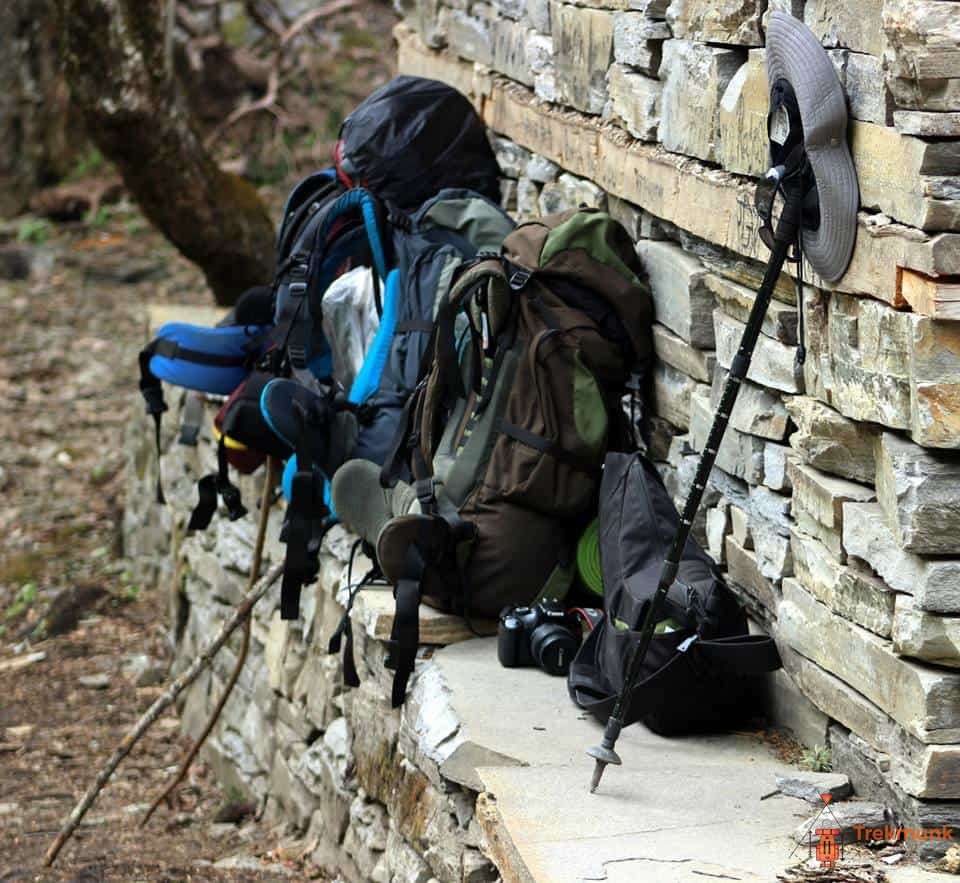
Related Tours
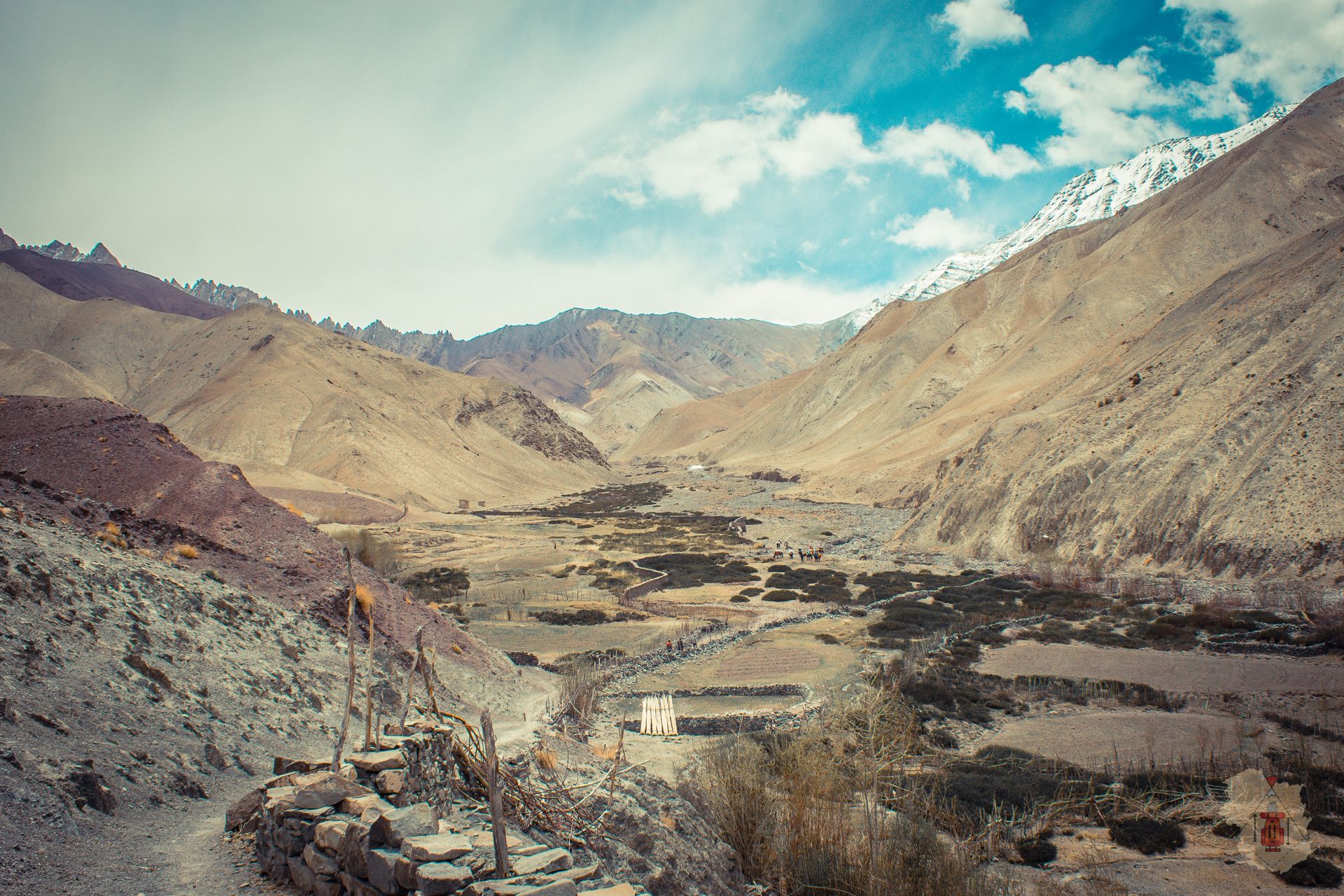
Nubra Valley Trek
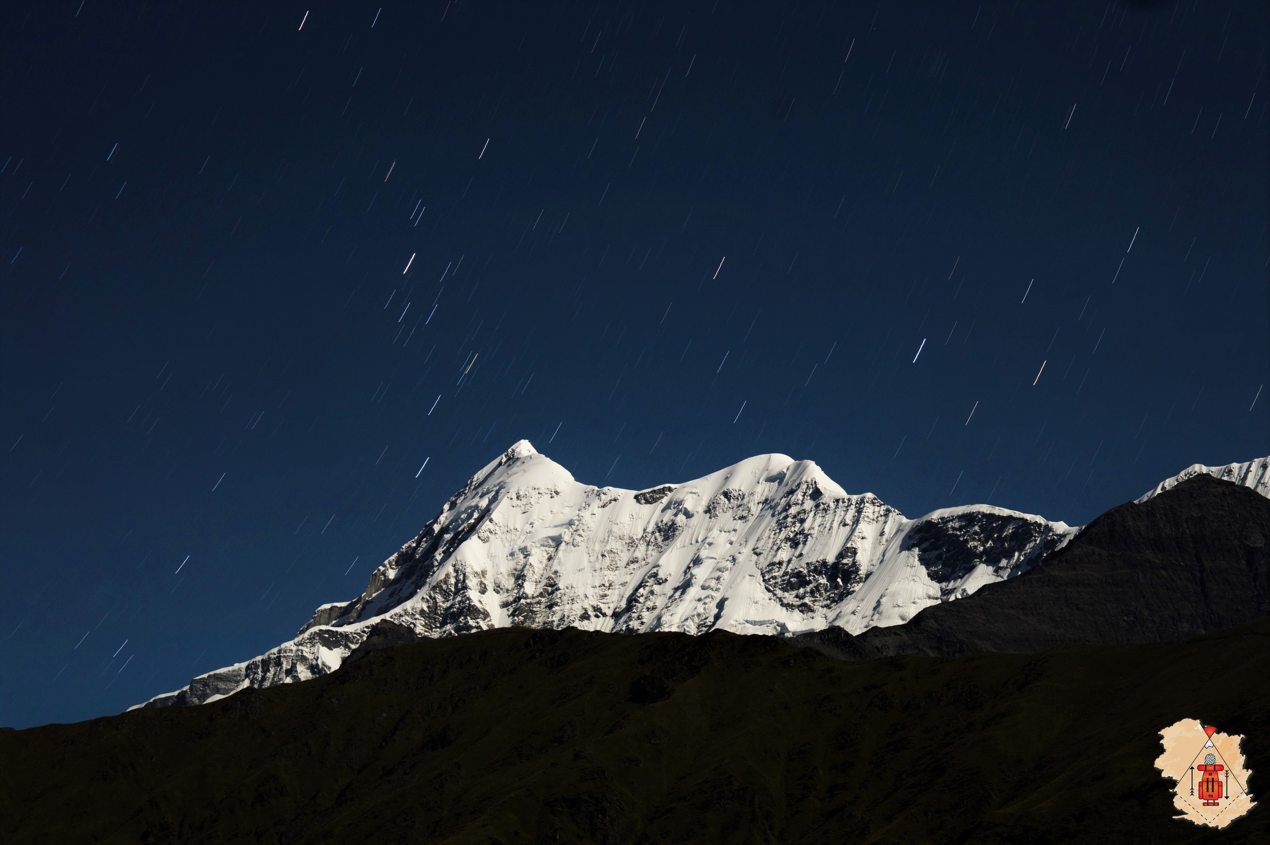
Roopkund Trek
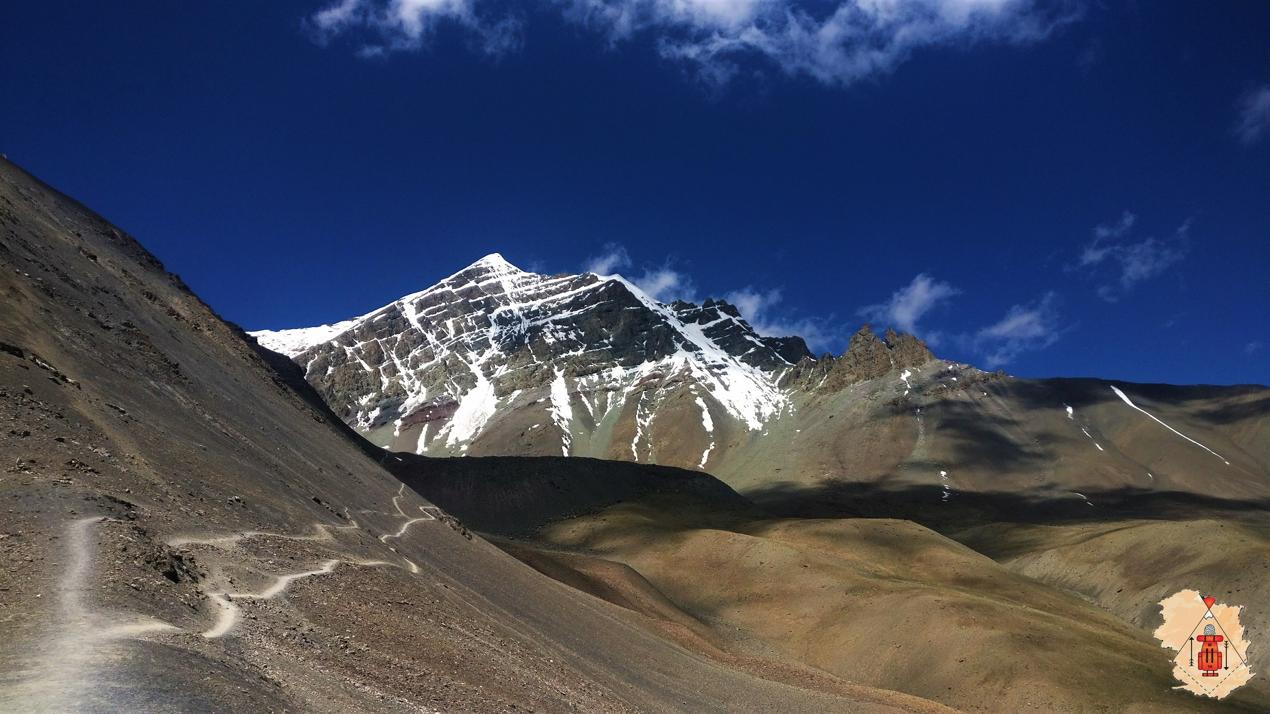
Stok Kangri Trek
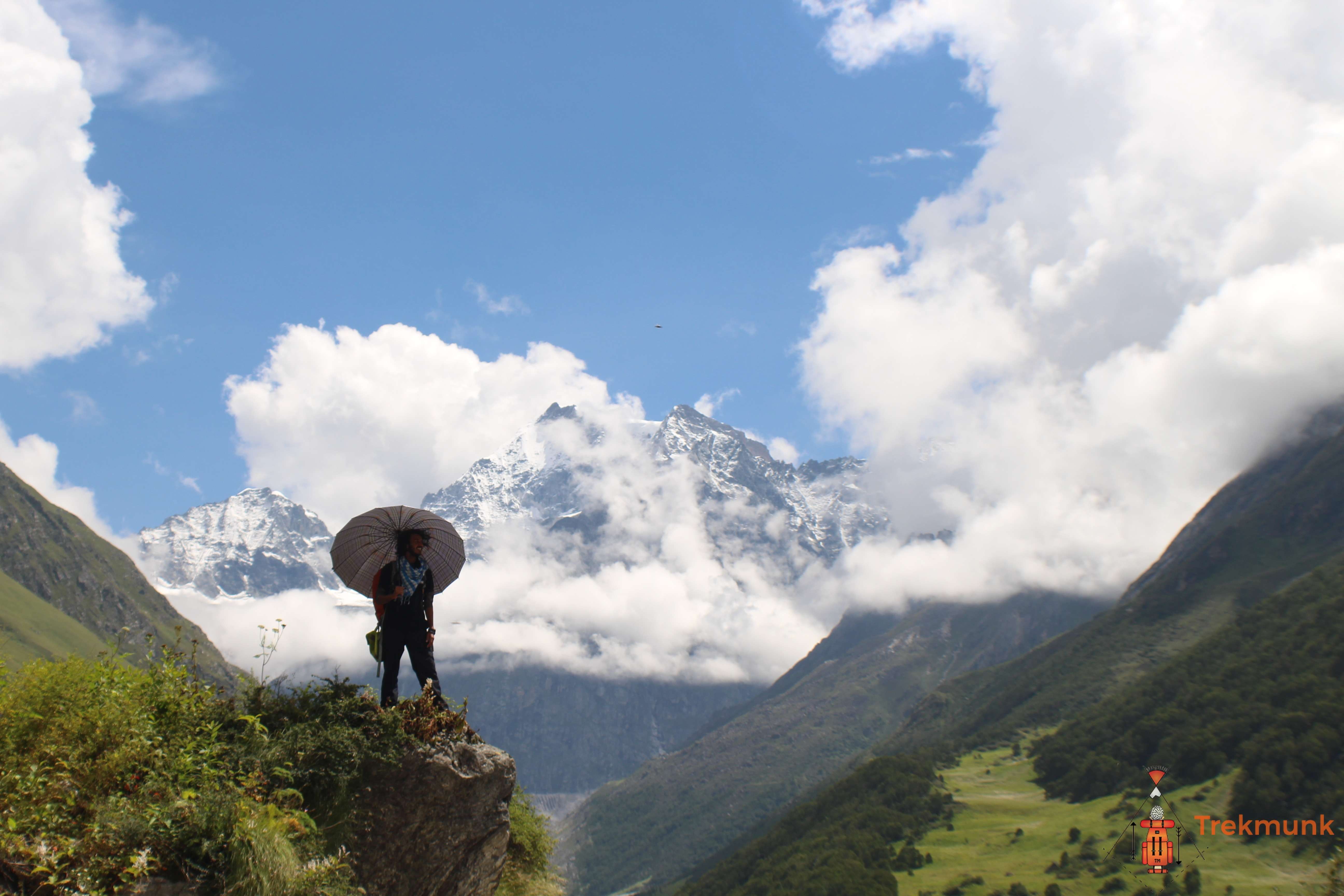
Valley of Flowers Trek

"Trekmunk is changing the indian trekking industry"
"10 Most Promising Adventure Sporting and Trekking Companies - 2020"
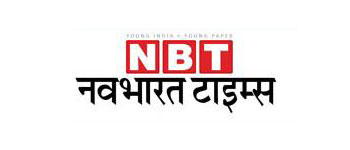
" Things you do for the Passion for Travel"
Hello there, How can we help you ?
Timing: 10 am to 6 pm IST (GMT +5:30)
Whats App Us

Search form
- +91-11-41076073
There is no trip in the wishlist.
MARKHA VALLEY TREK

India, Ladakh
- 12 MAX GROUP SIZE
- 1,01,250 START POINT TO END POINT

- 15 Sep - 22 Sep 2024
Select Payment Full-₹66900 Advanced-₹20000 Pending-₹46900
- description
- cost details
What to expect
- photo gallery
One of the most classic and popular treks in Ladakh – its a perfect combination of beautiful trans-Himalayan landscapes dotted with Ladakhi villages. There are good chances to spot some high-altitude wildlife as well as experience the life of nomadic families as they herd their yaks in these big and beautiful valleys. After a couple of days of acclimatisation to the high altitude in Leh, you will set out to explore the heartland of the central Ladakh Valley. It involves crossing the high pass of Kongmaru La (5274 mts) and walking on the banks of the Markha River crossing it a few times. Kang Yatse peak (6400m) at the head of this valley dominates the skyline as we get higher up the valley and the view towards the Zanskar range from the Kongamaru La is simply mesmerizing.
Day 01: Fly Delhi – Leh (3500m). Rest and Acclimatize
Day 02: sightseeing around leh, day 03: drive leh to skiu (3400m) - takes around 3hrs & trek to sara (3500m) - 4 - 5hrs, day 04: trek sara to markha (3700m) - 4-5hrs, day 05: trek markha to thachungtse (4150m) - 4-5hrs, day 06: trek thachungtse to nimaling (4720m) - 3-4hrs, day 07: trek nimaling to chogdo over the kongmaru la (5130m) - 6-7hrs & drive to leh - 2hrs, day 08: fly back to delhi from leh, payment schedule.
₹ 20000 - Booking Amount
TRIP COST INCLUDES
- - All arrangements for staying and camping while on the trip
- - All transport in a Non AC Car / Tempo Traveller as per the itinerary above
- - Accommodation on twin share basis with foam sleeping mats in tents / ‘A’ class hotels (all meals included)
- - Mules for porterage of personal and group luggage
- - Full board camping arrangements on the mountain with a large mess tent, tables & stools
- - Professional guide fee, environmental & camping fees
- - All trekking arrangements with India’s most experienced guiding team, camp staff, cook etc.
- - GST as applicable (Subject to change as per govt rules).
TRIP COST EXCLUDES
- - Delhi - Leh - Delhi airfare. Railway station / airport transfers in Delhi
- - Sleeping bag, items of personal clothing
- - Expenses of a personal nature like laundry, insurance, beverages and snacks in Leh or any other tea house, tips for guides, cooks & porters
- - Any costs arising out of unforeseen circumstances such as bad weather, landslides, road conditions and any other circumstances beyond our control.
- Note - 1- Single Room in Hotels and Single Tent during camping can be booked at an additional cost.
Cancellation terms
If it becomes necessary to cancel your trip, you must notify the office immediately in writing. The following terms would be applicable.
• More than 45 days prior to departure - we will refund the entire amount received by us minus a processing fee.
• Less than 45 days prior to departure - 25% of the Trip Cost as the cancellation charges and we will refund the balance.
• Less than 30 days prior to departure - 50% of the Trip Cost as cancellation charges and we will refund the balance.
• Less than 21 days - the entire amount would be forfeited.
The tour price is quoted as a package. No partial refunds or credit will be given for services not used. We recommend that you obtain cancellation travel insurance upon booking. If you can replace your spot by getting someone else to take that seat cancellation charges would be waived completely.
Pls note that these cancellation terms may be amended from time to time.
A trip graded as a Moderate Trek takes you to high altitude regions - above 3000m / 10,0000ft and will involve considerable altitude gain over the course of the trek. Altitude will have an effect, hence one would need to be careful about acclimatization. Moderate treks will have multiple days which involve considerable amount of ascents and descents and would require walking for more than 6 hours. There might be a day or two of camping in relatively high altitudes above 4000m / 13,000ft. A typical trek will last around a week to ten days depending on the region and is a good step-up for people who have completed a beginner trek.
Good fitness levels are needed to enjoy these trips. Some training up before the trip would help. Prior trekking experience is desirable.
Photo Album - September 2021 Photo Album - 2013
Related Blogs
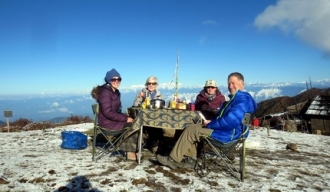
Nutrition in the Mountains
By white magic | 6 apr 2016.
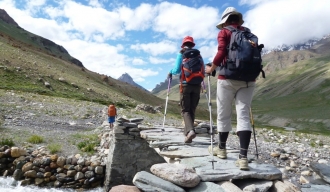
Setting the right pace on a trek
By avilash bisht | 29 mar 2016.
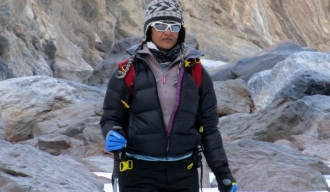
Clothing in Layers for the Mountains
By white magic | 14 mar 2016, similar trips.
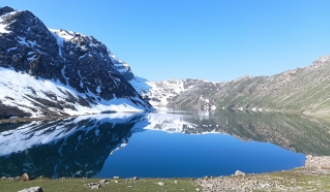
TARSAR MARSAR TREK
31 aug - 7 sep 2024.
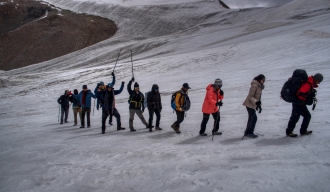
NUBRA VALLEY TREK
06 sep - 14 sep 2024.
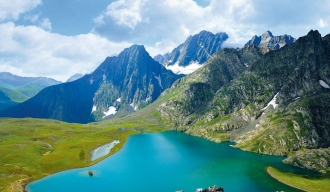
KASHMIR GREAT LAKES TREK
15 sep - 24 sep 2024.
- Tribal Places
- Hill Stations
- Treks of India
- Tips for travel

Ladakh is a dream come true for many, especially for its trekking and biking opportunities. The destination offers many treks for the adventure lover in you, from the great Chadar Trek to the magical Markha Valley Trek . This blog will explore the depths of the Markha Valley and its trek!
Markha Valley: Ladakh’s Most Pristine Valley
One of the most alluring treks in Ladakh is the Markha Valley trip, which offers an enthralling adventure between flying prayer flags, old mani walls, towering mountain passes, unusual animals, and breathtaking steep gorges. You will pass through real villages along the way, letting you feel a deeper connection to the rich fabric of Ladakhi culture. The trek offers breathtaking views of the Stok and Zanskar ranges, showcasing colourful rock formations.
June to September is the best time to start the Markha Valley walk. This strenuous route is best suited for experienced hikers because of its many stream crossings, difficult ascents and descents from two high passes and lengthy walking days. Prepare yourself for an experience that promises to be both a cultural immersion and a sight of natural beauty, letting the peace of the Markha Valley’s sceneries soothe you from the cares of everyday life.
Markha Valley Trek: Beauty in Difficulty

The Markha Valley trek is a strenuous trek well worth the effort. The beginning of this daring walk begins at Leh, which gives your adventure even more excitement as you get to see the Buddhist structures there. As you ascend, you’ll be astounded to travel past the small villages. Although the path passes through arid areas, you will see streams of water, such as the Markha and Indus. When travelling through the Hemis National Park, one is treated to a wide variety of rare wildlife, including argali, snow leopards, mountain sheep, rabbits, and other Himalayan species.
This demanding five-day trip is mostly intended for experienced trekkers, including multiple stream crossings, steep ascents and descents from two passes, and an hour-long walk. It is appropriate for hikers of all ages. The Markha Valley Trek offers breathtaking vistas hidden behind the mountains, and each day is thrilling in its unique manner.
Markha Valley Trek Itinerary from Chilling

This walk has three alternative beginning points: Chilling, Spituk, and Stok. The most common place to start is Spituk. On the other hand, you ascend quickly from the Spituk side to Ganda La (more than 5,000 feet in two days) and then fall severely to Skiu. A simpler route is to start from Chilling since you may join the path at Skiu and increase in height gradually.
It is the route to begin the walk from Chilling. You can also start from Spituk or Stok if you are physically fit and well-acclimatised. Although beginning from Spituk allows you to cross two high passes, the vistas from Markha up to Kongmaru La are undoubtedly the greatest on this path.
Day 1: Chilling to Skiu – 3 Hours – 7 Kilometres
· The Markha River empties into the powerful Zanskar River at Chilling. It is also the closest roadhead from which to begin the walk.
· Once at Chilling, use the tram bridge to cross the Zanskar River. Starting with a good time is riding the tram across the massive river. There is another way to cross the river here since a bridge was recently built.
· Turn right after crossing the river. In actuality, this is a few kilometres of motorable road. You’ll notice a route that veers off the road and ascends as soon as you start. You are welcome to choose this route instead of the boring road stroll.
· The track begins with a strong rise lasting around 30 minutes. Due to the altitude, you may experience some difficulty. But the hard portion of the walk for the day is behind us. From here, the route flattens out and rejoins the road.
· From then on, the walk to Skiu is rather level and takes place over the Markha River. After another 3 miles on your path, you will cross the settlement of Kaya. Although it would be lengthy the next day, you may spend the night in this village as there are also homestays.
· Kaya is three km ahead of Skiu. A charming town is tucked up between enormous, rugged mountains. Here are camping areas and homestays available. Since the next settlement is quite a distance away, it is not advised to proceed. Get a good night’s sleep to help you recover for the lengthy trek the following day.
Day 2: Skiu to Markha Valley – 7 Hours – 20 Kilometres
· It’s a long day walking along the riverbank, mostly on level terrain. On this day of the walk, you can glimpse some greenery by the Markha River’s thickets and several barley fields. Its difficulty (and pleasure) will be forging two separate, frozen bridges across the Markha River.
· Head up the Markha Valley towards the east to begin. The path follows the river for two km until it crosses a bridge. Continue straight ahead along the river, avoiding the bridge.
· From here, there are a few washout parts on the route that you must traverse by climbing up and down to get beyond the damaged area. There is a bridge crossing on the trail ahead. The Narding clearing is located 2 kilometres beyond this bridge. There’s a campground called Sara 3km up ahead.
· You have to cross another bridge one km ahead of Sara. You have arrived at Chalak village. There are barley fields in this lovely village. Travel time from Skiu to Chalak is 5 to 6 hours. The path steadily climbs from Chalak, passing past a track signposted with Bharal horns.
· The valley opens after two to three kilometres, and a river crossing leads to Markha Village. This place can have thigh-high water. Removing your shoes and socks and pulling up your trousers is advisable because the water is chilly. Find a place where it is safe to wade in, ideally where the river widens.
· After you pass across, continue walking for a few km until the last bridge crossing of the day. When you cross the bridge, you will soon come to Markha, the largest settlement in the valley. There are several homestays in Markha.

Day 3: Markha Valley to Hankar – 5 Hours – 11 Kilometres
· The trek’s most breathtaking section starts here. The sights begin to unfold as you approach the upper Markha valley this morning. On this day’s climb, you enjoy breathtaking views of Kang Yatse, an almost flawless pyramid.
· Follow the route that leads up from the settlement of Markha. From Markha village, take the route that runs beside the Markha River. A wooden plank bridge will appear; ignore it and walk, keeping the river to your right.
· It’s a 2-kilometer walk through the Markha River after that. At least two crossings will be required of you today. The second river crossing is followed by a two-hour walk up to the little village of Umlung. To get to Umlung, watch for the Umlung Gompa and cross from its base.
· The first glimpse of Mt. Kang Yatse is gained as you ascend from Umlung, a beautiful sight. You may reach the charming town of Hankar after two hours of trekking around the edge of a canyon. You may continue to Thochungtse, but there aren’t any homestays there.
Day 4: Hankar to Nimaling – 6 Hours – 10 Kilometres
· Day 4 is another brief day of hiking in an amazing location. Enjoy the scenery and take it slowly, but get to Nimaling before the weather becomes too terrible.
· From Hankar, follow the route as it goes sharply upward. About a km in, the route divides in two. The route heads up to a pass named Zalung Karpo La; you may ignore it. After another kilometre on the lower route, you will arrive at Thochuntse’s campground.
· Beautiful green meadows with a few teahouse tents may be seen at Thocuntse. The track splits right after Thochungtse. Proceed on the left-hand track; the right-hand trail leads to the Kang Yatse base camp.
· The route is quite steep for around sixty minutes before easing up slightly. You soon come to a lovely pond with Kang Yatse in the distance. It is the ideal location for your packed lunch.
· It’s a long, steady fall from the pond to the huge, windswept plateau of Nimaling. Nimaling is utilised as a summer pasture and is unusually lush for its height. There is a tea house here with plenty of ready-to-use tents where you may spend the night during the hiking season (May to September).
Day 5: Nimaling to Chokdo via Kongmaru La – 6 Hours – 12 kilometers)
· This day’s hike is comparatively challenging. It would help if you first made your way up the short but steep Kongmaru La hill. Perhaps more challenging, though, is the steep descent from the pass that seems never to end.
· Most people descend to Shang Sumdo on the same day. However, it makes for an uncomfortable last day. Spending the night in Chokdo is strongly suggested if you have the luxury of leisure.
· Kongmaru La may be seen easily to the east from Nimaling. Proceed towards the pass after crossing the brook close to the campground. A well-marked path ascends sharply to the pass. It takes around two hours to go to the pass from Nimaling.
· Kongmaru La is an ideal place to recuperate following the tough ascent. This location offers fantastic views of the Ladakh and Indus valleys on a clear day.
· But this is only the start of the truly challenging portion of the day—not its conclusion. The pass has a treacherous drop. After walking for two to three kilometres, you will reach a small canyon with rocky, precipitous slopes.
· When you get to Sukarmo, the canyon opens after approximately two hours of descending. You can also spend the night in Sukarmo because it has tea house tents. You continue down the riverbed for another hour until you reach a part that runs along a small hill. Here, the route descends steadily.
· You will soon arrive at Chokdo, the little settlement where you will spend the night. Here is where you may book a homestay. Since Chokdo has phone service, it is best to make a cab reservation there if you intend to take one from Shang Sumdo to Leh. If not, you might have to travel to Shang Sumdo and wait for a taxi for several hours.

Day 6: Back to Leh from Chokdo via Shang Sumdo: 2 Hours Trek + Drive – 5 Kilometres Trek + 50 Kilometers Drive
· It is a quick and simple day’s hike to Shang Sumdo, the roadhead. It should take you less than two hours to complete the stroll along the riverbed.
· There are occasional buses that go from Shang Sumdo to Leh. You can get to Leh via cab if a bus isn’t available. Locating other hikers ready to share a cab is a smart idea if you’re doing the Markha Valley trek solo.

Markha Valley Trek Cost
If you choose to do this trek via an operator, it will cost you around Rs. 20,000. If you do it solo, the cost will be higher—approximately Rs. 25,000 to 30,000.
Markha Valley Trek Best Time

June to September is the best time for the Markha Valley trek in India. The weather is pleasant during that time, and the sightseeing opportunities are marvellous.
The Markha Valley trip is an in-depth investigation of Ladakh’s spirit, not just a physical excursion through magnificent scenery. The hike became a kaleidoscope experience as the colourful prayer flags floated in the mountain wind, and every step unveiled a new rock tint. The settlements murmured stories of Ladakhi customs and provided a real link to the area’s rich cultural heritage, like an oasis in this high-altitude desert.
The Markha Valley journey goes above and beyond the Stok and Zanskar ranges’ breathtaking scenery, testing your mettle with stream crossings, difficult ascents, and descents from high passes. Each step is like a brushstroke, capturing the marvels of nature and leaving a lasting impression on your soul. It turns into a canvas of wonders.
Encouraged by the striking Markha Valley trek in Ladakh? It’s now your chance to explore the captivating scenery, take in the constantly changing colours of the rock-strewn path, and experience the genuine charm of the Ladakhi settlements. The rugged beauty of Markha Valley invites you, whether you are an experienced trekker or a traveller seeking cultural immersion. Bring a sense of wonder, curiosity, and fortitude, and let the mountains lead you on an extraordinary journey. Don’t let this chance pass you by; heed the call of the Markha Valley, where every action is a stroke of a trip that will change your life. Where this blog ends is where your experience starts. Are you going to take the call?
- Markha Valley Trek
- Tourist places
RELATED ARTICLES
Travel advisory: 7 indian places you should avoid this monsoon season, top travel destinations for indians for the august long weekend, explore amrit udyan and rashtrapati bhavan museum: now open for public, kinnaur kailash yatra 2024: registration, date, costs, amarnath yatra 2024: opening date, registration, helicopter booking.

Welcome to The India Explorer, your ultimate guide to discovering the rich tapestry of India’s culture, landscapes, and heritage. Led by passionate travelers, our team delivers in-depth reviews of hotels, restaurants, and staycation spots, helping you make informed travel decisions. Join us as we explore the unseen and celebrate the diversity of this vibrant nation.
Important Links
8 Best Treks in Himachal Pradesh – Explore Adventure, Beauty
Top 6 famous street food in assam- you absolutely must try.
- Terms and Conditions
- Privacy Policy
- Content Update Policy
- Content Review Policy
- Diversity and Inclusion Policy
- Copyright and Fair Use Policy
- Content Authenticity
©2024, TheIndiaExplorer is developed and managed by Squalo Technologies
A Complete Guide to Trekking Tours in India
India Tours
International tours, destination wedding, medical tourism, plan your trip.
- Trekking in India
Markha Valley Trek
- Accommodation
- Sightseeing
- Trip Highlights
- Best Time to Visit
About Markha Valley
One of the most popular treks in the Ladakh region is the Markha Valley Trek that allures adventurists across the world. It is a trek that passes through places with different landscapes. The Markha Valley Trek when winds onto the Hemis National Park and Rumbak Valley, will give the opportunity to witness rare species of animals of the Himalayan belt and if you are fortunate enough you might encounter a Snow Leopard. Nonetheless the valley is the home of several species like the lynx, Ladakhi Urial (a type of goat), Arghali (great Tibetan sheep), Blue sheep, Red fox, Tibetan wolf, Dhole (wild dog), Marmot and Mountain hare. Moreover this trail in Ladakh region also offers birding opportunity.
The Markha Valley Trek covers some remote human settlements like Rumbak village followed by Yurutse and Markha that leave the explorers mull over the rich indigenous culture of the Indo-Tibetans. One may also live get a chance to enjoy a home stay in one of these remote villages. Further the trekking trail in Ladakh region also lead your way up to the shrines like Lhatos and Mani before entering the Markha village. The journey winds and trails up to the Kongmaru La at 5100 meter, wherefrom one can capture the spectacular view of the hulking high Kang Yatze Peak and the Tibetan border.
The traditional Markha Valley Trek commences from Spituk and heads up to Ganda La en route Zingchen and thereafter to Skiu, which is an isolated village and houses an old monastery and ruins of an old castle that was once a rest stop for the Royal family on their way to Srinagar. From Skiu, the tracks lead to Markha and thereby to Shang Sumdo via Kongmaru La.
Markha Valley Trekking Tour Highlights
- Get the chance to explore the multi-hued Tibetan markets and historically rich Buddhist monasteries
- Witness some of the most sublime Himalayan sceneries throughout the picturesque trek
- Get the opportunity to stay at remote mountain villages and interact with its sweet and simple inhabitants
- Camp at scenic locations under the starry sky
Best Time to Visit Markha Valley Trek
The best time to visit Markha Valley is between June and mid-October. During this time, the weather is Ladakh is pleasant and the average temperature ranges between 20 and 30°C in the daytime. July and August are the ideal months for Markha Valley trek as during these months Manali-Leh and Srinagar-Leh highways also opens for private vehicles.
Where is the Markha Valley?
Markha Valley is located between the Zanskar and Leh region of Ladakh in Jammu and Kashmir State. This valley runs parallel to the Himalayan range and is at a short distance from Leh. Markha Valley trek has beautiful, wild and barren landscapes and therefore it is often called as Little Tibet. Strategically located, the valley offers the stunning views of Ladakh and Zanskar ranges, the 21,000 ft Kang Yissay and the 20,086 ft Stok Kangri peaks.
Markha Valley Trek (Detailed Itinerary)
Delhi – leh (complete rest in leh for acclimatization), other benfits (on arrival).
- Stay Included
Board the morning flight to reach Leh. Arrive at Leh and transfer to hotel/guest house and take a complete rest. This relaxation is essential for becoming accustomed to the climate. Overnight stay at the hotel/guesthouse.
Leh – Shey – Thiksey – Hemis
Today, we shall go on a sightseeing tour to some important monasteries in the area. We will be visiting Shey Gompa, which was once the summer capital of Ladakh kings; Thiksey Gompa, which is said to be one of the most beautiful structures in Ladakh and the famed Hemis Monastery belonging to Drukpa Order. Overnight stay at the guest house.
Leh - Spituk (drive) – Trek to Zingchan (3200 mts/10496 ft)
Today, early in the morning, we will leave for Spituk, which is an hour journey away. We shall explore Spituk Gompa, which is believed to be 500 years old. After visiting Spituk, we will begin our trek and passing a bridge and strolling southwest of Indus River, we will reach Zingchan Village. Overnight stay in camp.
Zingchan - Yurutse (3900 mts/12792 ft) via Rumbak
Post breakfast, we shall ascend to Rumbak from Zingchan. We shall trek along the Rumbak Nala via Yurutse Village, which has lush fields of potatoes and barley. Overnight stay in the tents.
Yurutse - Skiu (3100 mts/10168 ft) via Ganda La
Our trek today will end at Skiu, which can be reached by crossing Reach Ganda La (4900 meters). The pass offers spectacular view of Zanskar Range and other far-flung peaks of Himalaya. From Ganda La is a long descent to the village of Shingo. The trail then leads to a gorge from Shingo Village, which is at a short distance from Skiu. At Skiu, we will witness the confluence of river from Markha Valley. Overnight stay in the tents.
Skiu - Markha (3800 mts/12464 ft)
An easy climb today from Skiu will lead us to Markha Valley. The trekking trail passes through several streams. Overnight stay in the tents.
Markha – Thochuntse
Our today’s trek will be from Markha to Thochuntse. It is to be noted that at Markha, there is a change in landscape and from now onwards the view of heavily forested sections will not be witnessed rather barren and rugged landscape will follow. We shall be crossing river andl come across Hankar en route to Thochuntse. Hankar is the highest village in Markha Valley. Overnight stay in the tents.
Thochuntse - Nimaling (4700 mts/15416 ft)
In the morning today, we will begin our trek to Nimaling. We will be crossing a number of gentle slopes and a chain of glassy ridges. There is a sequence of Mani Walls and chortens on the route. This is counted among the most stunning high valleys in Ladakh and is separated by Kangyatse Peak. Overnight stay in the tents.
Nimaling – Kongmaru La (5150 mts/16892 ft) – Sumdo
After the breakfast, we will cross to the north of Markha and shall ascend to Kongmaru La (5306 meters), which is the highest passes in the region. After taking a good view of the surrounding snowy peaks and Karakoram range, we will trek down to the Martselang Valley leading Martselang Stream to the Sumdo Village. Overnight stay in the tents.
Sumdo - Hemis (4 hrs trek) – Leh
Our trek today will be from Sumdo Village to Martselang. At Martselang Valley, the trail broadens into the Indus Valley. We shall take the jeep waiting for us at Martselang Village. We will also be exploring Hemis Monastery and then drive to Leh via Thiksey and Shey Gompas. Overnight stay in the hotel.
Reach the airport in order to catch flight to Delhi
Fill Enquiry Form Below
Why tmi for trekking holidays, experienced.
An experienced trekking tour operator, with a team of an experienced adventure enthusiast ensure to give our clients well-designed trekking tour packages.
We are certified by major tour and travel associations in India and world like IATA, IATO, TAAI, IMF & MOT (Ministry of Tourism, Govt of India).
Happy Customers
TMI has received numerous accolades from its happy customers for its excellent services and best adventure holidays.
Local Offices
We have local office in Ladakh, Uttarakhand, Sikkim, Jammu & Kashmir, & Himachal Pradesh for our customers to find assistance anytime and anywhere.
Related Tour Packages
24 Nights - 25 Days
Darcha Lamayuru Trek
18 Nights - 19 Days
Darcha Padum Trek
12 Nights - 13 Days
Frozen River Trek
11 Nights - 12 Days
Hemis Jugtakh Trek
7 Nights - 8 Days
Indus Valley Trek
14 Nights - 15 Days
Junglam Trek
10 Nights - 11 Days
Ladakh Monastery Trek
16 Nights - 17 Days
Ladakh Zanskar Trek
Lamayuru alchi trek.
9 Nights - 10 Days
Lamayuru Chilling Trek
Lamayuru padum trek.
22 Nights - 23 Days
Manali Ladakh Trek
Markha valley & stok kangri trek, nubra valley trek.
17 Nights - 18 Days
Remote Zanskar Trek
15 Nights - 16 Days
Rupshu Valley Trek
6 Nights - 7 Days
Sham Valley Trek
Snow leopard trek, southern zanskar trek.
19 Nights - 20 Days
Spiti to Ladakh Trek
5 Nights - 6 Days
Spituk to Stok Trek
Stok kangri trek.
26 Nights - 27 Days
Trans Zanskar Expedition
Tso moriri lake trek, more about trekking in ladakh, our latest informative travel blogs, explore the hidden natural treasure of himalayas with these unexplored treks in uttarakhand, india trekking guide: best informative blogs on india himalayas trekking tour, where to visit in uttarakhand and himachal for adventure, chilling, and finding peace for a post-lockdown holiday, india trekking information at a glance, trekking destinations.
- Uttarakhand
Special Interests Treks
- Wildlife Treks
- Spiritual Treks
- Weekend Treks
- Cultural Treks
- Family Treks
Best Time for Trekking in India
- Best Time to Do Ladakh Trek
- Best Time to Do Uttarakhand Trek
- Best Time to Do Sikkim Trek
- Best Time to Do Himachal Trek
- Best Time to Do Kashmir Trek
- Best Time to Do Garhwal Trek
Fixed Departure Tours
- Fixed Departure for Ladakh
- Fixed Departure for Uttarakhand
- Fixed Departure for Sikkim
- Fixed Departure for Himachal
- Fixed Departure for Kashmir
Seasonal Treks
- Spring Season Treks
- Summer Season Treks
- Monsoon Season Treks
- Autumn Season Treks
- Winter Season Treks
Essential Links
- Things to Carry
- Terms & Condition
- Trekking Equipment
- Trekking Permit
How It Works
- Tell us details of your holiday plan.
- After you submit the form, one of our travel experts will get back to you with customised holiday package based on your requirement, within 24 hours.
- Grab the deal and start packing your bags for an indelible holiday with Tour My India.
Call Us for details
+91-9212553106
Request a quote.
You will be redirected to your dashboard shortly. We will also call you back in 24 hrs .
- Markha Valley Trek: A Gateway To Ladakh’s Hidden Villages And Valleys
Markha Valley is bestowed with the diverse beauty of rocky mountains, snowcapped peaks, and serene hamlets. Thus, making Markha Valley Trek a rollercoaster ride in different terrains. Circling some parts of Hemis National Park, this trek has a difficulty level of moderate to difficult depending on your fitness level. Also known as the tea house trek, this trek offers varied levels of adrenaline rush. Some of which include steep ascends, river crossing, bridge crossing, etc. What by day paints a picture of a picturesque landscape, by night covers you with a blanket of numerous stars. Starting off Chilling village, this trek sure makes for one hell of an experience.
Best Time To Go For Markha Valley Trek
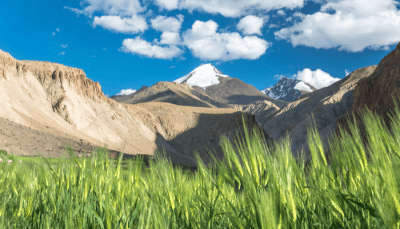
The best time to visit Markha Valley Trek is during the months of June and September. These months comprise the summer season in Ladakh. During these months the temperature is moderate and the terrain is mostly clear. Moreover, it is the best time to visit both the Srinagar-Leh route and the Manali-Leh route. Post-September, the roads get blocked due to frequent snowfall and most passes get closed. Traveling during the months of June and September, you can also save yourself from the blows of harsh winter winds.
The ideal duration of this trek comprises a total of 6 days. A duration of 6 days takes you through various scenic check-points such as Chilling, Skiu, Markha, Hankar, Nimaling, Kongmaru La, Shang Sumdo, etc. Moreover, it lets you take sufficient halts in-between the trekking trail. Even though Markha Valley is considerably warmer during June, August, and September, it is nowhere as warm as the planes. Therefore, make sure to always carry woolen clothing and an extra pair of socks.
Must Read: 12 Astounding Spots For Trekking In Ladakh That Need To Be On Every Hiker’s Bucket List!
How To Reach The Base Camp
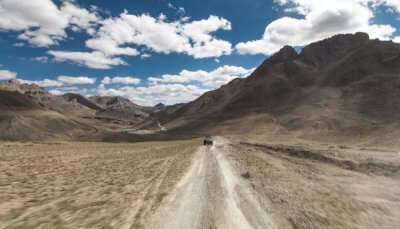
Image Credits: Pixabay
The base camp for Markha Valley Trek is a small hamlet called Chilling. This village is situated at an elevation of 3,346 meters above sea level. Moreover, it is connected by Leh by the following modes.
- By Bus: Situated at a distance of approximately 66 km from Leh, Chilling can easily be reached by road. Moreover, it is the only mode of transport to reach Chilling from Leh. The village is situated inside the premises of Hemis National Park. One can make their journey by bus every Wednesday and Sunday.
- By Car/Taxi: Another way to travel to Chilling village by the means of car or taxi. It is also the fastest mode to reach Chilling by Leh. Taxi rides will cost you somewhere around INR 1200 and INR 1500. If you don’t have much experience driving in high altitude regions, it is recommended that you hire a local driver.
Suggested Read: 7 Valleys In Ladakh That Prove It Is Indeed A Paradise On Earth!
5 Highlights Of Markha Valley Trek
Markha Valley Trek in Ladakh crosses past many awe-inspiring checkpoints. Some of these checkpoints are beautiful campsites while some are picturesque villages. Listed below are some of the highlights of this trek.
1. Skiu Village
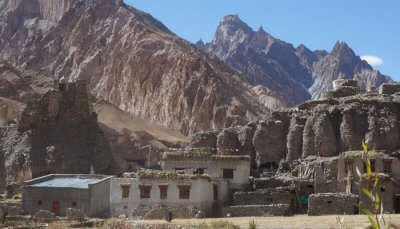
Skiu Village is situated adjacent to Kaya Village. This village is situated within the premises of Hemis National Park. It is one of the very first villages that you will pass through in this trek. It is circled with huge rocky mountains. Here, one can stay in homestays and can also opt to camp.
Suggested Read: Stok Kangri Trek: A Remarkable Yet Difficult Trekking Experience In Ladakh!
2. Markha Village
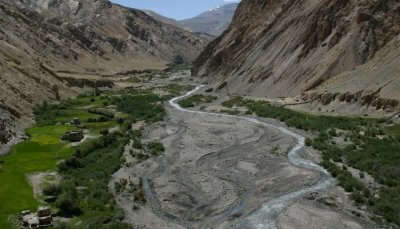
Situated alongside the famous Markha River, Markha Village is the biggest village situated in Markha Valley. It is home to more than 22 families and is an important checkpoint of Markha Trek . Here, one can also find numerous homestays to rest for the night. En route, you can also spot local people with their yaks.
Suggested Read: Explore The Hemis National Park In Ladakh to Witness Wildlife In High Altitudes
3. Hankar Village
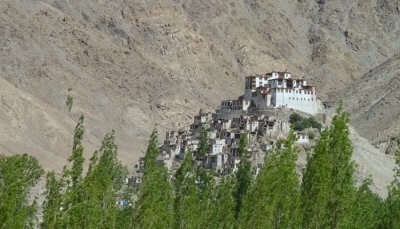
Hankar is a small village with awe-inspiring landscapes. It is also considered as one of the most beautiful stops in this trek. This village also offers you picturesque views of a monastery. Moreover, staying the night in this village will also bring you closer to the local cuisine of Ladakh.
Suggested Read: 8 Tourist Circuits Of Ladakh To Cover The Best
4. Kang Yatse Hill
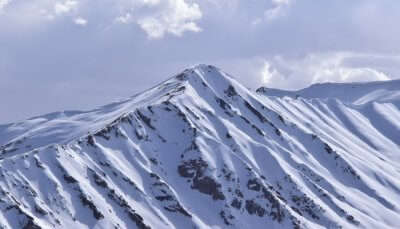
On your way to Markha Trek, you will also enjoy the spectacular views of Kang Yatse Hill. This throne-shaped peak is situated inside the premises of Hemis National Park. Enjoy gazing at the snow-covered peaks and capture the incredible landscape with your camera. Kang Yaste has two summits roughly situated at an elevation of approximately 6400 meters.
Suggested Read: Head To Ladakh In Winter For An Adventure Of A Lifetime
5. Kongmaru La

Kongmaru La is situated at an elevation of 5130 meters above sea level. It is also the highest point of the trek and offers spectacular views of the Kang Yatse Hill. This high-altitude pass connects Markha Valley with the Indus Valley. You will pass through this pass on your way to Chokdo Village.
Further Read: Leh Ladakh Bike Trip: Everything You Need To Know From The Scratch!
Head on for a breathtaking experience with Markha Valley Trek in Ladakh. Also, witness the intriguing changes in the enchanting landscape as you get-going. This trek accounts for nothing more than a thrilling holidays in Ladakh . So say Juley to your next adventure in the mountain peaks of Ladakh.
Disclaimer: TravelTriangle claims no credit for images featured on our blog site unless otherwise noted. All visual content is copyrighted to its respectful owners. We try to link back to original sources whenever possible. If you own rights to any of the images and do not wish them to appear on TravelTriangle, please contact us and they will be promptly removed. We believe in providing proper attribution to the original author, artist or photographer.
Frequently Asked Questions About A Gateway To Ladakh
What is the best time to go for Markha Valley Trek?
The best time to go for Markha Valley Trek is during the months of May and September. During these months the temperature is moderate and the terrain is mostly clear.
What are some of the safety tips to keep in mind while trekking in Ladakh?
Given below are some of the safety tips to keep in mind while trekking in Ladakh:
- Owing to the high altitude, It is important that you take time to acclimatize for a few days upon your arrival in Leh and before going on a trek.
- Always equip yourself with a personal first-aid box.
- Make sure you are accompanied by a travel guide before heading for a trek.
- During your trek, make sure to take sufficient water breaks to keep yourself hydrated.
- Also, pack ample dry snacks like dry fruits to help you keep the pace.
- Carry a sturdy pair of hiking shoes that you are comfortable wearing.
- Pack an extra pair of socks and undergarments.
- Pack extra batteries and power banks.
What are the top treks in Ladakh?
Given below are some of the top treks in Ladakh:
- Stok Kangri Trek - Difficult
- Kang Yatse 2 Trek - Difficult
- Chadar Trek - Difficult
- Markha Valley Winter Trek - Moderate
- Sham Valley Trek - Moderate
Are there any villages situated in Markha Valley?
Listed below are some of the villages situated in Markha Valley:
People Also Read:
Skandagiri Trek Chadar Trek Bhrigu Lake Trek
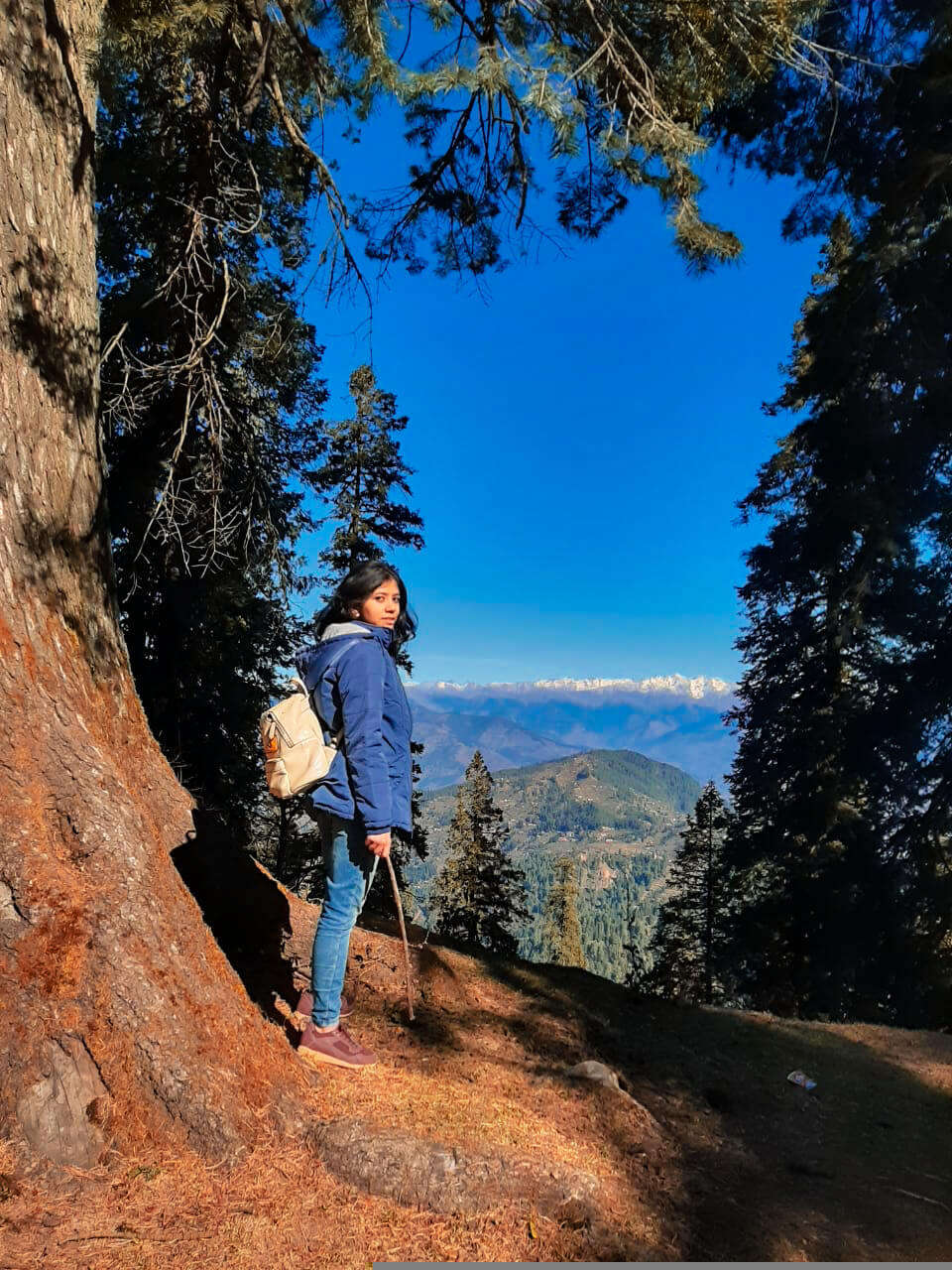
Saumya Rawat
A true stargazer, an enthusiastic traveler, and a free-verse poet, Saumya sees the world in-between pages and pathways. She is always up for a travel plan, dark chocolates, and photo walks. Creative and quirky just constantly run through her head. Moreover, she has a flair for storytelling through video-making but that is still a work-in-progress.
Places to visit in India
- 30 Best Places To Visit In Bangalore In...
- 64 Best Places To Visit In Kerala For...
- 39 Best Places To Visit In October In...
- 101 Places To Visit In India Before You...
- 20 Places To Visit In Sakleshpur In 2024...
- 35 Exotic Places To Visit In December In...
- 32 Best Places To Visit In January In...
- 20 Best Places To Visit In Meghalaya For...
- 12 Places To Visit In Punjab To Witness...
- Unravel Places To Visit In Uttarakhand For A...
- 26 Best Places To Visit In Jammu For...
- 29 Places To Visit In Monsoon In India...
- Best Places To Visit In August In India...
- 36 Beautiful Places To Visit In Kashmir One...
- 55 Fascinating Places To Visit In Hyderabad In...
- 35 Ultimate Places To Visit In July In...
- 72 Places To Visit In Rajasthan In 2024
- 42 Best Places To Visit In Pondicherry In...
- 33 Spectacular Places To Visit In Mumbai On...
- 43 Places To Visit In West Bengal In...
- 41 Best Places To Visit In June In...
- 35 Best Places To Visit In Mysore In...
- 35 Places To Visit In Coorg For A...
- 54 Best Places To Visit In India In...
- 8 Places To Visit In Jibhi For A...
- 64 Best Tourist Places To Visit In Goa...
- 25 Best Places To Visit In Visakhapatnam In...
- 16 Places To Visit In Lucknow That Showcase...
- 60 Best Places To Visit In Kolkata That...
International Places To Visit
- 35 Best Places To Visit In Japan That...
- 40 Best Places To Visit In Canada In...
- 28 Places To Visit In October In World...
- 28 Stunning Places To Visit In South Korea...
- 25 Places To Visit In Manila In 2024...
- 19 Best Places To Visit In Morocco In...
- 34 Best Places To Visit In Austria In...
- 82 Best Places To Visit In Turkey That...
- 10 Breathtaking Places To Visit In The World...
- 22 Best Places To Visit In Netherlands: The...
- 24 Fabulous Places To Visit In Ireland: The...
- 19 Best Places To Visit In London In...
- Discover 24 Places To Visit In Switzerland In...
- 17 Mystical Places To Visit In Egypt In...
- 15 Places To Visit In United Kingdom That’ll...
- 33 Best Places To Visit In Amsterdam On...
- 19 Best Places To Visit In Kuala Lumpur...
- 42 Best Places To Visit In Bangkok In...
- 11 Popular Places To Visit In Doha For...
- 26 Places To Visit In Germany In 2024...
- 32 Places To Visit In Belgium That Make...
- 15 Places To Visit In USA That Reflect...
- 37 Best Places To Visit In Dubai At...
- 15 Top Places To Visit In Asia To...
- 20 Must-See Places To Visit In Milan In...
- Top 27 Places To Visit In Greece In...
- 31 Places To Visit In Abu Dhabi In...
- 25 Places To Visit In August In The...
- 15 Best Places To Visit In Chicago That...
- 14 Places To Visit In Berlin You Must...
Things To Do
- 40 Things To Do In Pondicherry In 2024...
- 12 Best Things To Do In Matheran In...
- 23 Intoxicating Things To Do In Turkey In...
- Top 14 Interesting Things To Do In Kanyakumari...
- 38 Things To Do In Gokarna To Escape...
- 12 Best Things To Do In Varanasi For...
- 21 Remarkable Things To Do In Krabi In...
- 16 Things To Do On Honeymoon In 2024
- 23 Things To Do In Chennai To Explore...
- 20 Things To Do In Ahmedabad For An...
- 30 Best Things To Do In Wayanad For...
- 37 Amazing Things To Do In Kerala For...
- Top 39 Things To Do In Jaipur
- 19 Things To Do In Mussoorie For A...
- 33 Best Things To Do In Kolkata In...
- Top 25 Things To Do In Kodaikanal For...
- 32 Things To Do In Ooty That Will...
- 15 Things To Do In Srinagar That Will...
- 20 Things To Do In Darjeeling
- 27 Kickass Things To Do In Malaysia
- 25 Best Things To Do In Phuket That...
- 18 Awesome Things To Do In Kasol On...
- 27 Exciting Things To Do In Chikmagalur
- 9 Things To Do In Mathura For An...
- 23 Things To Do In Lonavala For A...
- 10 Best Things To Do In Lakshadweep For...
- 30 Joyful Things To Do In Bhutan
- 38 Exhilarating Things To Do In Udaipur In...
- 18 Best Things To Do In Chandigarh
- 29 Amazing Things To Do In Shimla
- 30 Things To Do In Dehradun In 2024
- 7 Incredible Things To Do In Vrindavan For...
Recent Posts

Explore Tso Kar Lake On Your Next Serene Adventure In Leh In 2024

Visit Tanglang La Pass A Journey Through The Vivid Tales In 2024

Explore Hall Of Fame A Place In Leh That Fills Your Heart With Pride In 2024
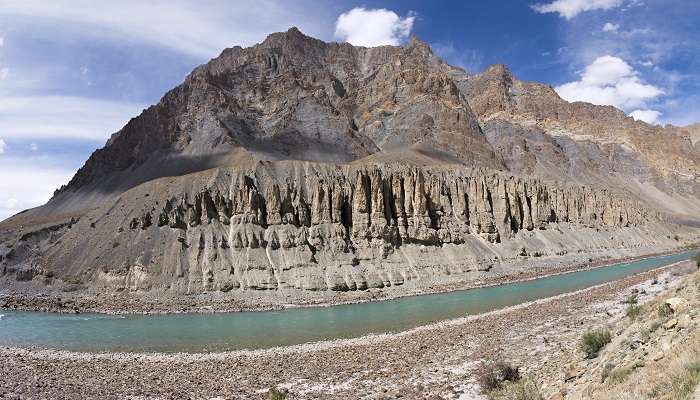
Explore Zanskar Valley In Ladakh For An Exceptional Journey In 2024
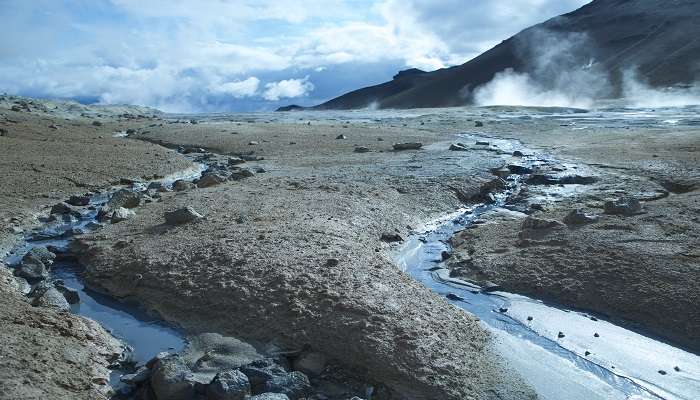
Embark To Panamik A Famous Hot Springs And Scenic Splendour Of Nubra Valley In 2024

Experience The Tranquil And Quiet Of The Thiksey Monastery In 2024
Trending Blogs

20 Mysterious Places In India To Visit In 2024 More Bizarre Than The Bermuda Triangle

10 Scariest Roads In India That Are A Driver’s Nightmare
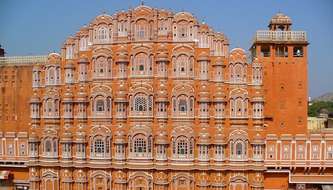
101 Places To Visit In India Before You Turn 30 in 2024

35 Exotic Places To Visit In December In India 2024 To Enjoy A Surreal Vacation

64 Top Honeymoon Destinations In India In 2024

95 Best Honeymoon Destinations In The World In 2023 For A Romantic Escape!
Navigation menu

IMAGES
COMMENTS
The Markha Valley trek follows the Markha Valley River from Chilling up to Kongmaru Pass and down to Shang Sumdo, near Hemis National Park. ... Updated on October 8, 2023 December 15, 2021. Read. India A Complete 10-Day Leh Ladakh Itinerary. Updated on October 4, 2023 October 4, 2023. Read. 17 Comments Simon S. says:
The Markha Valley trek takes around 6-7 days to complete, starting in Leh. Depending on the exact start and end point, the Markha Valley hike is approximately 50 miles (80 kilometres) in distance. Total elevation gain / loss is about 2500m / m, with a max elevation of 5260m.
Day-1: Arrival in Leh. Altitude: 3,500 m/ 11,500 ft. NOTE: Markha Valley Trek is of 7 days and the highest altitude is of 17,100 ft. If you are looking for more challenging adventure in Leh try out the Twin Peaks Expedition. You can go for either Kang Yatse II or Dzo Jongo Peak as well.
Yaks grazing on green plains at an altitude of 5,000m, white snow-covered peaks higher than 6,000m, extensive valleys surrounded by huge, rocky mountains and a strong Tibetan culture with deep roots: the Markha Valley trek is the perfect hike for those seeking both stunning Himalayan landscapes and experience real Tibetan culture.. Markha Valley is one of the most popular treks in Ladakh, but ...
Markha Valley trek is also known for being a 'tea house trek' where one can expect accommodation in parachute tents at most of the village en route. Apart from the striking contrast of trekking in an arid cold desert valley, you get an outstanding view of the Ladakh and Zanskar ranges, the 21,000 ft Kang Yatse and the 20,086 ft Stok Kangri ...
Markha Valley trek takes you along the ancient silk route with astounding villages of Markha & Hankar, in a valley now situated in the Hemis National Park. The valley is located to the south of Leh and runs in the North West - South East direction. The trek follows the valley all the way up to Kongmaru La, a high altitude pass with over 17,250 ...
Best Time to Visit Markha Valley Trek. The ideal time to visit Markha Valley is between June and mid-October. During this time, the weather is Ladakh is cool and pleasant and the average temperature ranges between 20 and 30°C in the daytime. Also, the highways leading to Ladakh are open for civilian traffic. This is the time when Ladakh ...
Markha Valley Trek is a stunning journey through the Ladakh region, offering scenic views, cultural insights, and diverse landscapes. Learn the detailed itinerary, reviews, and safety tips from Trekup India, the best trekking partner in India.
Day 06 - Trek - Markha to Lower Hunkar 3968 m (6 hours) overnight stay Camp. Day 07 - Trek from Lower Hunkar to Nimaling - 4535 m (6-7 hours)overnight stay Camp. Day 08 -Trek from Nimaling to Leh 3500 m via Kongmaru las pass 5336m (8 hours trek) same day drive to leh 3 hours overnight Hotel. Day 09 - Departure from Leh.
Markha Valley is a hidden gem nestled in the Himalayas. Discover the untouched beauty of this picturesque region, where rugged landscapes, charming villages, and high mountain passes await. Immerse yourself in the unique culture of Ladakh as you interact with welcoming locals and witness majestic views of Kang Yatse and the Himalayas.
Markha Valley Trek is a difficult trek. It is a high altitude trek in Ladakh region which requires climbing to the height of 5,200 meters making it perfect for someone with prior high-altitude trekking experience! Grade. Difficult. Max Altitude. 5200 m. Distance. 65 km. BRS Level Required.
The Markha Valley Trek is a 9-day adventure through the scenic landscapes of Ladakh and Zanskar ranges, starting and ending in Leh. This popular trek proceeds on a moderately difficult route and covers key locations such as Chilling, Skiu, Markha, Hankar, and Nimaling. The main highlights of this Markha Valley trek tour include crossing high ...
The best time to visit Markha Valley trek is from May to August. The trail starts attracting trekkers from across the world in mid-May. These months have pleasant weather and mild temperatures. As summer arrives in the valley, the villages at lower altitudes adorn bright shades of green. The lush green paddy fields amidst the arid desert ...
The trek follows a remarkable high valley with excellent views across the mountain region and is one of the best ways to experience the unique culture of the High Himalaya region. The Markha Valley trek goes long with the Markha River downstream taking in several high passes including Ganda La (15748 ft) and Kongmaru La (17,060 ft).
The trail to Markha is gentle with crossings Chortens, Prayer walls & Markha river but the trail seems long mainly due to sun exposure - today the altitude gain is hardly 200m across 12km of trek, crossing the Markha river a couple of times. Markha is a substantial village, complete with a derelict fort on the hillside and a small village ...
15 Best Winter Treks in Himachal: Venture into Snow-Covered Wonderlands. Pangarchulla Trek: A Difficult Trek for Those Who Love Adventure. Beas Kund Trek: A Guide for Beginners - Price, Distance, Detailed Itinerary. 4 Hill Stations near Hyderabad for a Day Trip (Within 100, 200 and 300 km)
Beauty on the Markha Valley trek comes with a price - a lot more people and the tea-house culture. There's nothing wrong with that but it requires an adjustment after a couple of truly remote weeks. Our trip to the start of the formal Markha Valley trek began after a long day that included crossing the Rubrang La at 5,020 metres (16,470 ...
The best time to visit Markha Valley is between June and mid-October. During this time, the weather is Ladakh is pleasant and the average temperature ranges between 20 and 30°C in the daytime. July and August are the ideal months for Markha Valley trek as during these months Manali-Leh and Srinagar-Leh highways also opens for private vehicles.
5. Kongmaru La. Image Credits: Pixabay. Kongmaru La is situated at an elevation of 5130 meters above sea level. It is also the highest point of the trek and offers spectacular views of the Kang Yatse Hill. This high-altitude pass connects Markha Valley with the Indus Valley.
Mytishchi has a humid continental climate, which is the same as Moscow but usually a few degrees colder due to significantly lesser impact of urban heat island.The city features long, cold winters (with temperatures as low as −25 °C (−13 °F) to −30 °C (−22 °F) occurring every winter and a record low of −43 °C (−45 °F)), and short, warm-hot summers (with a record high of 38 ...
Hotels near Babushkinskaya Station, Mytishchi on Tripadvisor: Find 34,534 traveler reviews, 30,340 candid photos, and prices for 1,033 hotels near Babushkinskaya Station in Mytishchi, Russia.
Written October 21, 2015. This review is the subjective opinion of a Tripadvisor member and not of Tripadvisor LLC. Tripadvisor performs checks on reviews. hugow48. Hayling Island, UK 81 contributions. 0. beautiful.
Rapid trains (Sputniks) bound to Pushkino and Bolshevo also stop here. You can also get here pretty easily by taking the Kaluzhsko-Rizhskaya metro line to the end at Medvedkovo and there catch a bus or marshrutka to the Mytishchi center from the metro station. 55.91449 37.76223.